
Case Studies

Case Study: Driving Fast Results With Auto Dealership Marketing
February 10, 2023

When it comes to marketing, having an integrated strategy is essential. By integrating different marketing channels, you can ensure that your message reaches the right people in the right place and at the right time.
This is especially important for auto dealerships, which rely on multiple marketing channels to reach potential customers.
Whether you’re boosting your visibility with search ads or building trust with potential leads through content marketing , having an integrated marketing strategy can help you achieve your goals faster.
The benefits of an integrated marketing strategy are numerous. It allows you to create a unified message and reach potential customers on multiple platforms. An integrated strategy also allows you to track customer behavior across multiple platforms and adjust your tactics as needed. This allows you to optimize your campaigns for maximum efficiency and effectiveness.
An integrated marketing strategy can also help you save time and money. By using a single platform, like Marketing 360® , to manage your campaigns, you can save time by not having to manage multiple campaigns separately. This can help you focus your efforts on the channels that are working and adjust your strategy accordingly.
Local auto dealership drives quick success with integrated marketing strategy

One local auto dealership saw just how much of an impact an integrated, streamlined marketing strategy can have on overall success. Best of all, they didn’t have to wait to see results.

Over the last 30 days alone, they saw more than 350K impressions, almost 12K clicks and more than 5K conversions. Compared to the previous 30-day period, they saw a 520% increase in impressions, a 294% increase in clicks, a 278% increase in conversions and a 360% increase in website visits.

How did they do it?

First, they invested in SEO by optimizing their website for relevant keywords, like “used car dealership near me,” helping them rank higher and expand their reach.

They also let the keyword research guide their content marketing strategy, making it easy to write helpful, relevant blogs, social media posts and beyond.

Second, they enhanced their organic strategy by using search advertising. By targeting the same keywords in search ads, they were able to enhance both their organic and paid search strategies.

Last but certainly not least, they made it a point to stay active on social media. By posting regularly, they were able to build recognition in their brand and expand their local reach.

They also took advantage of the unique benefits of social media by engaging with customers and followers.

To succeed in today’s competitive market, auto dealerships need an integrated, multi-channel marketing strategy. And, while you may not always see immediate results, having a cohesive strategy is an effective way to drive success.
Build, manage and grow your small business with Marketing 360®
Marketing 360® is a singular platform that offers everything you need to build a modern, professional website , launch ads on popular channels , manage all of your contacts, projects and deals , schedule out social media posts , monitor your SEO performance and so much more, plus the marketing team you need to grow your business .
See our plans and pricing.
Account M37880 Screenshots taken on 2/8/23
*Results are based on past client performance. Individual account performance may vary. Results are not guaranteed.
Get Plans and Pricing Below

Case Studies , Social Media Management
Case Study: Plumber Wins With Social Media Management

Case Studies , Reputation Management
Case Study: Property Management Uses Reputation Management to Learn About Customer Satisfaction

Case Study: Furniture Store Sees Conversion Rates Skyrocket

Case Studies , Social Media Marketing
Case Study: Furniture Store Boosts Visibility With Social Media Giveaway

Case Studies , Facebook Ads
Case Study: E-commerce Store Grows with Facebook Ads

Carpet Cleaner Marketing Case Study: Reputation By Design
Get the know-how to get ahead.
Get business, marketing and sales tips written by experienced industry practitioners. 100% free. Cancel anytime.
- Email address *
Three Case Studies in Automotive Digital Marketing

Auto dealerships have a unique challenge in digital marketing. Customers tend to engage in over 900 digital interactions with a dealership before they make a purchase, and dealers can expect to pay anywhere from $350 to $500 in advertising and lead-acquisition per car sold — a significantly higher up-front cost than most other industries. The auto dealership’s customer journey is long and complex , which makes investing in the right tools absolutely essential to digital marketing in the auto dealership world.
Digital marketing strategy and attribution is the strongest way to connect with your customers. These days, 92% of car buyers are researching online before they buy, and mobile watch time of test drive videos on YouTube has grown by over 70% in the past two years. Digital marketing strategy has become the primary way to connect with potential customers and build brand awareness.
Here are three leading marketers in the automotive industry, and how they’ve used digital tools to their advantage:
Call tracking can improve inbound leads in the automotive industry
The Humberview Group represents 20 automotive dealerships across Ontario. Despite their industry-leading status, Humberview just wasn’t satisfied with the accepted wisdom about how they should market their dealerships. Many in automotive marketing favor bringing in leads through website form submissions , since they’re cheap and simple to implement, but Humberview found this just wasn’t enough.
Like other industries where customers make big-ticket purchases, the path to conversion for auto dealerships can stretch across weeks or months and involve plenty of research and deliberation on the buyer’s part. “In the auto business, there’s a lot of research that suggests that two-thirds of website visitors do not contact a dealer on digital channels right after visiting the page,” says Maxim Poliakov, digital marketing manager at the Humberview Group.
“So now, when we think about one-third of visitors who do contact a dealer, an even smaller percentage of those are the ones who prefer form submissions,” Poliakov explains. “If you’re focusing your analytics only on form submissions, you’re missing a lot of conversion data, you’re missing out on many many leads, and it’s much harder to make effective decisions about your automotive marketing campaigns.”
Inbound service and sales calls are a big part of Humberview’s day-to-day operations, so they recognized that advanced call tracking and analytics could bring considerable benefits to their business. They had previously been using a barebones call tracking service that came bundled with their website provider, but they recently redesigned their website and switched to a new platform that didn’t include call tracking features.
With the website redesign presenting them with an opportunity for a fresh start, Poliakov and the rest of his team decided to make the switch to CallRail . Right away, they discovered there were real and tangible benefits to unifying the analytics and reporting for their different advertising channels — this approach helps them glean valuable high-level insights about how their automotive marketing initiatives are performing.
“The main feature that got us interested in CallRail was definitely Dynamic Number Insertion , and how that really improved how we could track leads in Google Analytics,” Poliakov says. “Also, our last provider didn’t have a proper API, and their reporting system was very clumsy. With CallRail’s open API and more advanced reporting, we’ve been able to integrate with many different platforms, like Google Analytics and Google Ads , and also with our internal analytics platform.” Now that everything is unified under a single dashboard, Humberview can achieve a full-spectrum view of their marketing efforts, Poliakov says: “It’s awesome, and not only has this saved a lot of time, it has made our marketing so much more effective and more efficient.”
By fully documenting and analyzing the various touchpoints that leads interact with during their purchase journey, Poliakov and his team could suss out which of their channels were the best at driving conversions and sales. Humberview tripled inbound leads after adding call tracking to their toolbox.
How the automotive industry can integrate AI into marketing
Harley-Davidson may not be selling automobiles, but their motorcycle dealerships across the world are still in the business of selling vehicles. As this Harvard Business Review article highlights , the company has integrated AI into their marketing approach to increase New York Sales leads by 2,930 percent.
The auto industry is increasingly spending on SEO , meaning it’s more important than ever to optimize your budget. Harley-Davidson optimizes by personalizing their efforts to the customer.
New York Harley-Davidson dealership owner Asaf Jacobi, utilized Albert, an AI-driven marketing platform to measure and autonomously improve the outcomes of marketing campaigns, as well as analyze existing customer data from a CRM. This allowed Jacobi to isolate specific buying characteristics, such as those who completed a purchase, viewed website content, or added an item to an online cart.
These were leads who were in the ‘decision’ and ‘action’ stages of their customer journey . From there, Albert examined the characteristics of customers who engaged in these micro-moments and touchpoints, and created segments of look-alike audiences. The program then could make strategic marketing recommendations based on their behavior and increase conversion rates.
Knowing your customers is vital to creating programs which target specific segments of car shoppers. After you have customer information, use it. Email marketing can help boost a business and build a customer community - when it’s done right. There are lots of opportunities in email marketing, like letting customers know about your holiday sales, personalized emails, follow-ups, and thank you emails that will keep customers coming back.
Make sure to know where your customers come from and what your sales funnel looks like. This will require a strong grasp of attribution. ‘ First-Touch ’ and ‘ Last-Touch ’ are two of the most well-known attribution models, but be sure to take a look at alternative models and figure out what will be the best fit for your dealerships. After you’ve figured that out, it’s time to optimize your budget and explore PPC further .
Seamless integrations to improve your dealership’s ROI
Paxton Automotive Marketing is the country’s leader in direct mail and digital advertising for the automotive industry. They create customized advertising solutions for more than 125 clients across the nation to drive traffic to their websites, generate leads, and increase direct sales. They’ve been using call tracking since they first opened 14 years ago and have always understood how call attribution was essential for both their internal use and proving ROI for clients.
Paxton Automotive ran into issues when trying to set up integrations with many of the call tracking providers they used and found that although they could track attribution, the call tracking solutions were not user or client-friendly.
“Every other provider fell short in one way or another, either it wasn’t client user-friendly, they weren’t flexible enough to meet our client’s requests, or they would go bankrupt in a year. The automotive industry is fast paced and always evolving. Paxton is dedicated to staying at the forefront and exceeding industry standards,” said Brittany Ford, Sales Account Executive for Paxton Automotive.
The agency not only wanted a client and user-friendly offering but a call tracking provider that would offer them solutions that stayed up to date with digital marketing trends like mobile marketing and SMS – two features widely used in the rapidly growing auto industry.
“Call tracking allows us to see the real-time, direct response from our campaigns. The data collected from call tracking allows us to stay on top of industry trends so we can provide our clients with cutting-edge campaigns,” said Ford. Being able to quickly prove ROI has been crucial for Paxton Automotive, especially in an industry that runs on calls.
“Our clients want results. They want to see the ROI of their ad spend and CallRail helps us to do that. Internally, we use the analytics of CallRail to determine which campaigns are hot and which aren’t.” Because they can see which channels are driving calls in real-time, they can quickly make adjustments to ensure they have successful client campaigns. That quick turnaround between the start of campaigns and proving ROI has led to a 20% increase in client retention.
Implementing CallRail call tracking has enabled Paxton Automotive to fill gaps in call attribution, listen to call recordings for lead qualification , and send sales ready leads directly via SMS and Text, allowing them to increase client sales by 15%.

Case Studies
Discover how the Mastermind platform has produced real results for dealerships with our automotive marketing case studies.

Conquest Digital Boosts Meta Performance
Using Conquest Digital, powered by Polk Audiences, to seamlessly upload segments to their Meta accounts, a Chevy Buick GMC dealer earned impressive returns on ad spend throughout the year.
Read Article
Tom’s Ford Drives Pre-Orders and Service Acquisitions with Mastermind
See how Tom’s Ford utilizes Mastermind tools to drive dealership service acquisitions. Explore customer-focused experiences for your team to engage sales leads.
Error - something went wrong!
Industry Trends and Insights Newsletter Sign-up
Lexus of San Diego Sees 19.5 Point Lift in Loyalty with Mastermind
Learn how the team at Lexus San Diego to adapt to COVID-19 business disruptions with the help of Mastermind.
Nourse Chillicothe Ford Sees Consistent Boost in Business with Mastermind
Mastermind enables Nourse Chillicothe Ford to better understand how their marketing efforts are performing, helping them improve their attribution, ROI and penetration.
Auto Dealer Grows Used Car Inventory and Loyalty with Mastermind
Learn how Mastermind empowered Fred Haas Toyota World to sell more cars and create a better car buying experience to maximize dealership profitability.
Request a Mastermind Demo
Cadillac Dealership Sees 12 Months of YoY Record Sales with Mastermind
Suburban Cadillac of Troy achieved 12 months of year-over-year record car sales which they primarily attribute to automotiveMastermind’s dealership sales and marketing solution.
Team Toyota of Langhorne Revs Up Their Service-to- Sales Process
Discover how Team Toyota of Langhorne improved its service-to-sales process to reach new dealership customers and identify potential auto sales leads.
Selling More Audi's With An ROI That Can't Be Beat
Explore how automotiveMastermind revamped Audi of Tulsa’s car sales process and improved its dealership ROI.
Toyota Dealer Archives Market Leading Retention Rates
Riverhead Toyota went from struggling with selling in the service drive to an enviable 19% average conversion ratio by understanding how to build dealership customer loyalty.
Williams Toyota of Sayre Sees a 62% Sales Jump
Explore how automotiveMastermind streamlined Williams Toyota of Sayre’s car sales process to create a 62% increase in car sales.

BMW of Manhattan
Explore how BMW of Manhattan employed Mastermind's predictive behavior technology to create large profits.

BMW Dealer Meets The Ultimate Sales-Driving Machine
Discover how BMW of San Francisco leveraged Mastermind's predictive analytics marketing capabilities to improve dealership performance.

Mastermind Motivates Team While Delivering Measurable Results
Discover how Audi Seattle employed Mastermind's behavior prediction and automotive equity mining tools to produce measurable results.

Oxmoor Toyota's Data Driven Path To Success
Oxmoor Toyota has found success by having a BDC work on generating leads and driving them to the dealership for their sales team to close.

Williams Honda
Explore how automotiveMastermind helped Williams Honda have its best car sales month in years and increase its bottom line.

Crest INFINITI
Discover how Crest INFINITI leveraged Mastermind's predictive marketing campaigns to increase car sales profits.

Jim Norton Toyota
Explore how Jim Norton Toyota of Tulsa has leveraged automotiveMastermind's data mining technology into its car sales process and improved dealership ROI.

Lexus of Towson
Explore how automotiveMastermind helped Lexus of Towson increase their car sales close rate and increase phone and email queries for personal vehicle offers.

Zimbrick BMW
Discover how Zimbrick BMW used Mastermind's Service Conquest solution to increase dealership conquest sales to 33 vehicles over a 4 month period.
Mastermind Provides Unprecedented Virtual BDC Support Amid COVID-19
Learn more about what Mastermind was doing while dealership management were pre-occupied with focusing on bigger picture strategies to combat the COVID-19 disruptions.
AutoFi is coming to town! Check out the roadshow schedule and book a visit.

Commerce platform powering your website and showroom shopping experiences
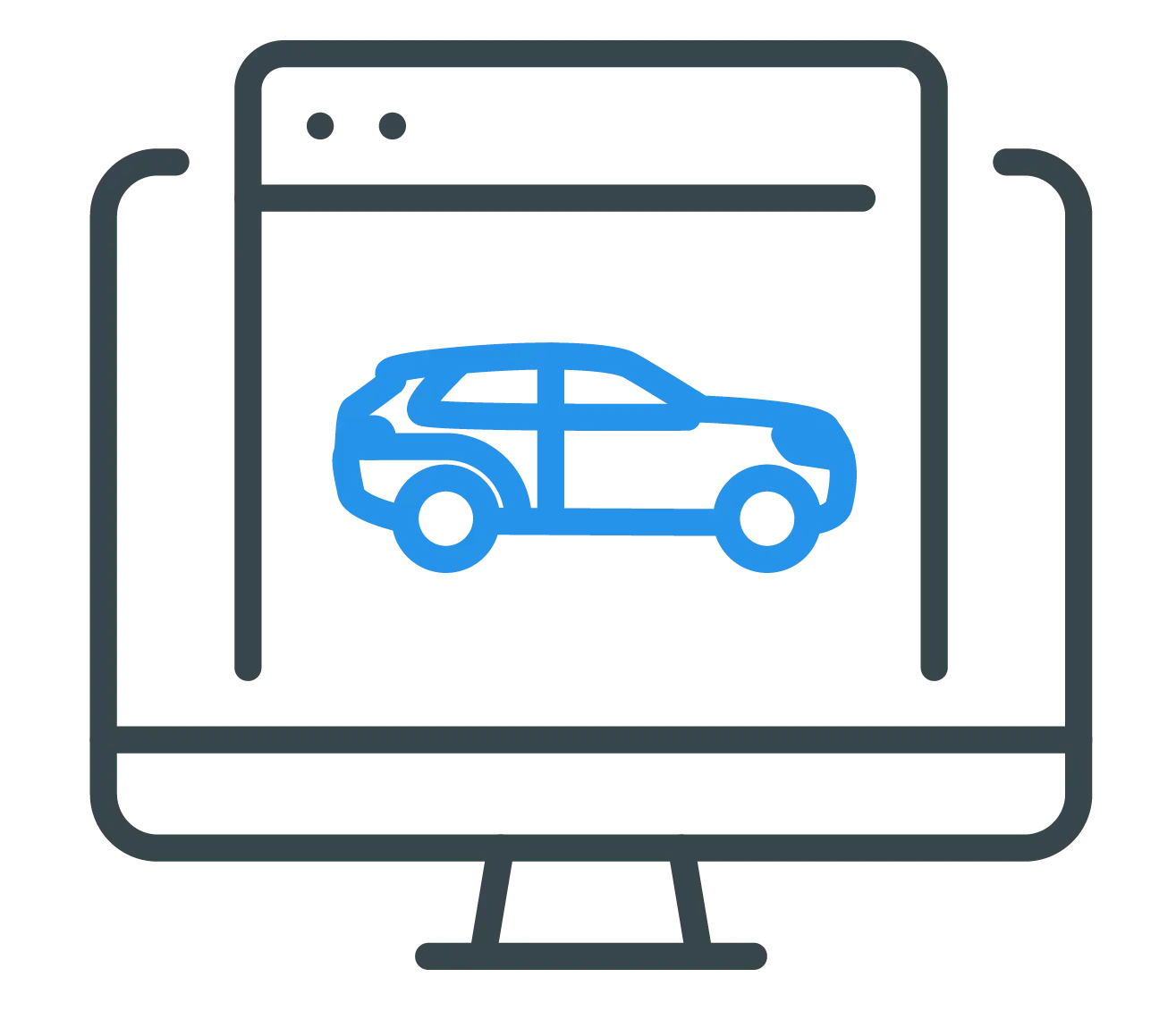
Enterprise: OEM, Lenders, Marketplaces
Online finance automation within a branded digital experience, powering transactions
- Testimonials
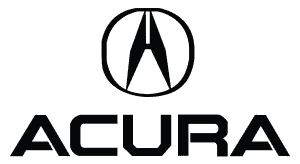
- By Joe St. John
- April 12, 2021
Automotive Dealer Digital Marketing Guide: Strategies, Modern Ideas & Best Practices
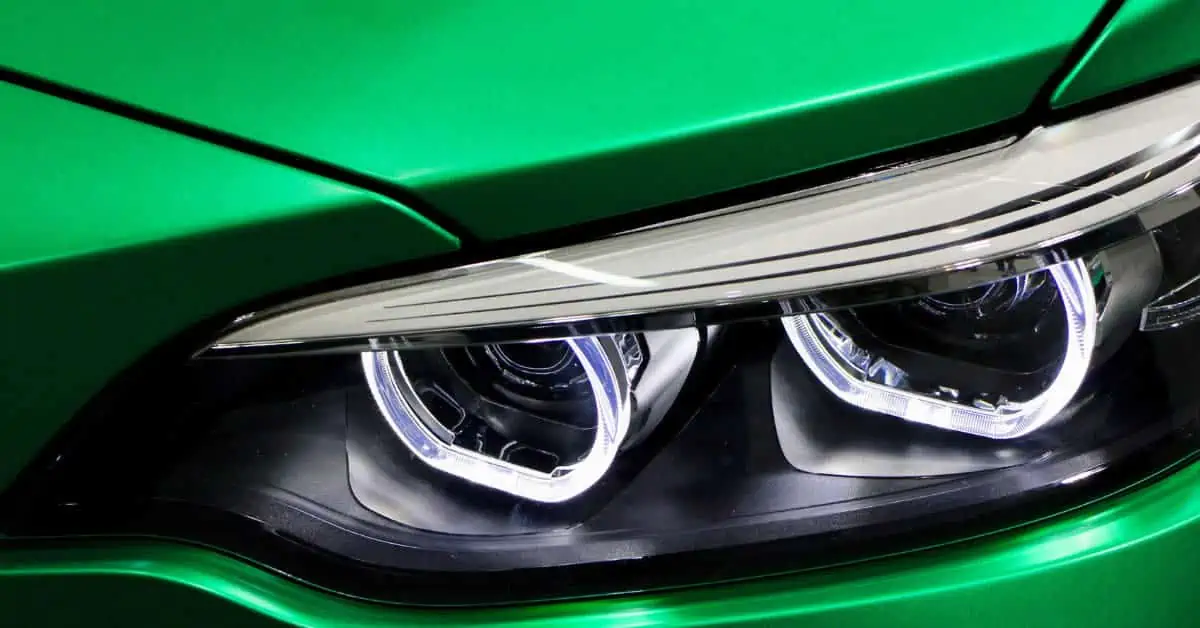
Almost all consumers today are shopping for cars online before they go near a dealership. Smart auto dealers use digital marketing strategies to convert those online shoppers into buyers. I draw on my 20 years of experience to share the top strategies that work.
In this Article:
- Why digital marketing is so vital for auto dealers
- Primary digital marketing channels for auto dealers
- Best strategies for dealership digital marketing
- A downloadable template for an auto dealership marketing plan
How Is Digital Marketing for Auto Dealers Different from Traditional Marketing?
Digital marketing refers to marketing online through websites, emails, and social media. Digital marketing differs from traditional marketing in ways other than where it appears. The practice is more interactive and focuses more on customers.
A car dealership can’t focus a television commercial on a customer of a specific age or other characteristics. That potential customer can’t interact with the TV ad. And the dealer often will not know how effective that commercial was in luring potential customers to the dealership.
Digital marketing can target demographics and other categories of potential buyers. Dealers can quickly and easily see how well the marketing performed and how many people want to learn more.
Why Automotive Digital Marketing Is So Important Today
Automotive digital marketing is crucial because customers shop for cars in vastly different ways than 10 or 15 years ago. Most customers spend hours online shopping for their next car before they ever go to a showroom.
Here are some details on how much online now dominates car shopping:
- 86 percent of car shoppers do online research before visiting a local dealership, according to a study by digital marketing agency Adtaxi.
- Customers who bought a car spent an average of 15 hours on the complete buying journey: researching, shopping, visiting dealerships, and negotiating, according to a 2020 Cox Automotive study. Almost two-thirds of that time—nine-and-one-half of those hours—was spent online.
- According to a Digital Air Strike study, seven in 10 car buyers say online reviews of dealerships affect which dealerships they will visit.
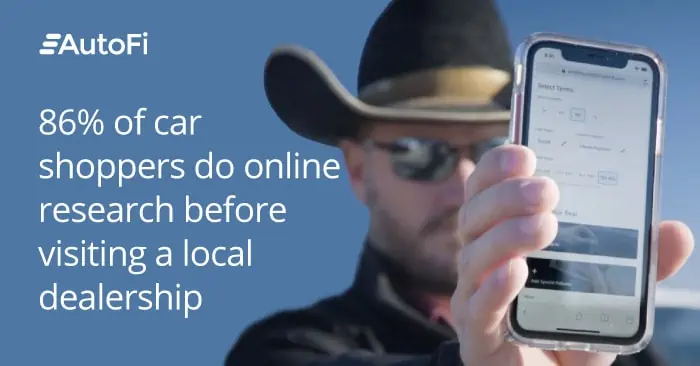
All of this means car dealers must have a strong presence and engage with potential customers online. They need to understand how to focus marketing toward particular groups of buyers and give them the information they want. It’s imperative all of that happens before the buyer ever comes to a dealership or even makes a phone call.
(To learn more about how much online shopping affects many aspects of the car business, including how dealers engage customers and sell automobiles, visit our automotive digital retailing guide .)
How Much Money Do Car Dealerships Spend on Advertising?
Franchised new car dealerships spend about $600 per new car sold. That comes out to spending billions of dollars every year on advertising. Online advertising is increasingly the dominant form of advertising for auto dealerships.
According to the 2019 annual report from the National Automobile Dealers Association (NADA) New car dealerships spent $9.25 billion on advertising in 2019, or about $628 per new car sold. That declined in the first six months of 2020 —likely because of the COVID pandemic. New car dealerships spent about $3.73 billion on advertising in the first six months of 2020, or about $600 per car sold.
In all of 2019, new car dealers spent 56 percent of their advertising dollars online; the next highest expenditure was the 14.5 percent spent on television advertising.
Automotive Digital Marketing Channels
Auto dealers can and should use multiple digital marketing channels to reach potential customers. This practice is called omnichannel marketing. Possible channels range from pay-per-click advertising to a well-designed website to online videos.
Here are the top automotive digital marketing channels:
Pay-per-click online advertising.
Pay-per-click advertising, also known as PPC, can be an essential tool for effective digital marketing. A dealership pays a search engine (most often Google) to show your link at the top of a search result for certain keywords. They pay Google a small amount every time someone clicks on that ad to learn more.
PPC continues to grow in the automotive industry. In 2019, eMarketer found that PPC ad spending in the automotive vertical increased 22 percent from the prior year.
Your ads can be text only, with a link, or sport images or videos. You’ll want to research the best words to use to attract the right customers. Pay attention to the negative words you’ll want to use to ensure you block out irrelevant searches (when searchers, for example, might be wanting to learn more about “mustang” horses instead of searching for a Ford “Mustang.”)
Another component of paid online advertising is called “programmatic display,” which allows you to show your ad to an extremely targeted group based on what they are reading on another website. They might be reading an article about buying cars, for example, or about small SUVs.
A Well-Designed Website with Helpful Content for SEO
Your potential customers can and should also find you without paid search engine advertising. Enter: Search engine optimization, which is optimized content on your website that helps search engines and searchers find you.
One study by Kenshoo, found that 70 percent of consumers who begin researching cars start with a search engine. There’s an advantage to your site having a high listing on a search engine results page; consumers consider them more trustworthy than a PPC ad. So, aim to be at the top of non-PPC, or organic, search results.
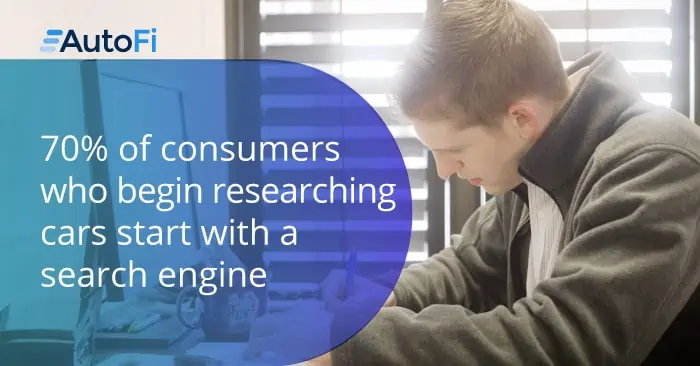
You’ll also want a well-designed website featuring content car buyers are looking for detailed information on individual automobiles and without flashy gimmicks that repel them. Today’s online car shoppers want to find all of the information necessary to make a vehicle purchase online. Learn more about providing a richer website experience for automotive shoppers .
Many car dealerships’ websites have too many calls-to-action (CTAs)— interactive components requesting a viewer’s name and contact info. That said, there should definitely be a few CTAs strategically placed on your website, but you don’t want them to overwhelm and turn off a viewer. Read more about how to increase your automotive website conversions .
Voice search continues to expand. Potential customers ask Alexa on their smart speaker or Siri on their smartphone to point them towards the best auto dealerships. Be sure to optimize your content to answer simple and conversational questions.
To learn more about SEO, read Moz’s post that covers all the SEO basics for car dealerships .
Including a blog on your site that provides basic consumer information about cars and car-buying can also improve your search engine results.
When consumers begin searching for a car, they won’t only look for a specific vehicle. They will also want to learn general knowledge about cars and car-buying. Many consumers, for example, will ask search engines about the pros and cons of leasing versus buying a car. If you’ve written a blog on that topic, there’s a good chance your dealership can be a top result for that question. You can do online research to see what questions consumers most often ask about cars and car-buying. One free online tool that provides you the questions people have is answerthepublic.com .
Your blog will also help consumers view your dealership as a trustworthy source of information and advice.
You can’t just focus on optimizing your website for SEO. You must also optimize it for local SEO—making sure people looking for cars in your metropolitan area find you.
Local SEO has become even more important as more and more people use their phones to access information online. Roughly half of all mobile searches are now for local results. People are on the move and want to know where to get a pizza or shop for a Ford 150. You want to be in the results when they’re looking for a vehicle.
Set up an account and include your address and other geographic info in Google My Business . You’ll also want to have local information throughout your website.
Social Media
Social media is a vital part of any digital marketing plan. According to research by the Chief Marketing Officer Council, 38 percent of car buyers say they consult social media sites before purchasing a vehicle.
Create an account on every social media network, from Facebook to Twitter to Instagram and more. Then task staff with keeping those accounts active, with regular posts about your dealership, car-buying, and vehicles.
You can also buy ads on social media platforms. A distinct advantage is you can target specific potential customers—people living in your metropolitan area who’ve been searching for SUVs, for example. Social media also allows you to see your return on investment for purchasing those ads easily. Facebook metrics, for example, can tell you exactly how many people clicked through to your website from one of their ads.
Online Videos
Viewership of online automotive videos is skyrocketing, and those videos heavily influence potential car buyers.
According to a Google study, 64 percent of people who used YouTube while buying a car were influenced by it. That’s more consumers than were influenced by TV, newspapers, magazine, or automobile reviews.
You might create short videos that show:
- A car on a test drive
- Testimonials from happy customers
- New vehicles and highlight unique features
- Tips on repairing and maintaining your car
The videos can attract more clicks in your social media and online ads and draw people deeper into your website. They can also help attract more visitors to your website through search engines ranking your videos. An important tip when posting a video to YouTube: Upload a written transcript of the video. The transcript generally isn’t visible to viewers, but it will help boost how Google ranks the video in search results.
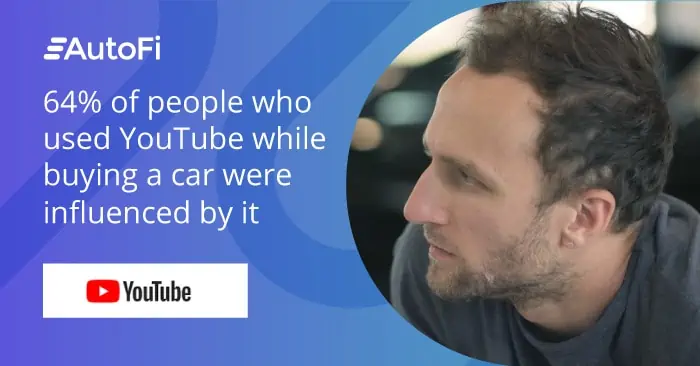
Email Marketing
Also educating their customers since they last purchased or serviced at a specific dealership now, they can be in the driver seat when it’s time for them to be in the market for another vehicle- advertising to your customers on how easy it is to buy from you and save time etc…
Email is as old-fashioned as things can get in the digital world, but it’s still effective.
First, you can and should send emails to your current and past customers. Send to people who’ve bought from your dealership or have their car serviced with you. They will eventually be in the market for a car again; remind them how easy and economical it is to buy from you.
You can also ask prospective customers for their email addresses on your website and through other marketing materials. Send targeted messages based on what the consumers have told you. Be sure to personalize the emails as much as possible and only send them the information they want. When sending emails, always include links to allow potential customers to get to your website. Adjust the length and tone of the emails based on responses you get or don’t get.
And consider distributing regular newsletters via email to people who sign up for them. These newsletters might cover topics like the latest car models, special deals, or useful info about cars or car-buying.
Your dealership can also send a text to customers who opted-in to receive messages from your company. This method is a quicker and more efficient way to reach consumers than through emails. People increasingly use their mobile phones to access business websites, including car dealerships. Customers who get a text from you can immediately go to your website.
Online Directories
Create your own listings in online business directories. These include nationally-based directories like Yelp, along with more localized versions. Make sure your profile is complete and has links to your website and social media accounts.
Online Reviews
Online reviews of your dealership are crucial to success. As mentioned above, seven in 10 car buyers say that online reviews of dealers affect where they will buy a vehicle.
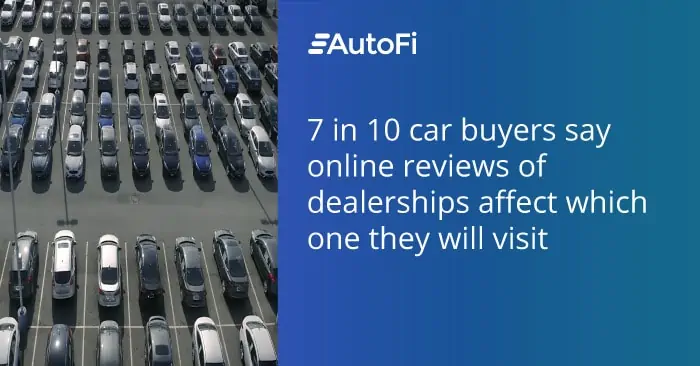
Provide ways for customers to give you reviews on your website or other venues like Google, Yelp, or social media. Be sure to monitor those reviews and respond to them (both positive and negative) in a constructive way. This tactic is only part of what you should be doing for your dealership’s online reputation management. You also need to monitor how your dealership appears in general search engine results.)
Don’t forget to add a link to your website on external review sites.
Third-Party Websites
Dealers will want to put all of their inventory—new and used, with all details about each car—on leading third-party websites that consumers often visit first when searching for a vehicle. The sites include Autotrader.com, Cars.com, Edmunds.com, and CarGurus.com.
Not listing your inventory on these sites is like having your cars behind your dealership building instead of out front.
OTT Advertising
Streaming video is growing exponentially. An estimated 147 million adults in the U.S. now access video content through services like Roku, Hulu, Amazon Fire TV, Sling, and similar platforms. In fact, it’s estimated that 80 percent of all internet traffic is streaming video.
Advertise on these platforms. This type of marketing is called “over the top” advertising because you can bypass traditional TV and cable networks. There are a number of advantages, including it is less expensive and more focused than traditional broadcast advertising.
Mobile Optimization
According to Broadband Search, in 2019, 53.3 percent of all internet traffic came through mobile devices. That compares to 16.2 percent in 2013. In the fourth quarter of 2019, 58 percent of all organic search engine visits in the U.S. were from mobile devices.
People are searching on their phones to find car dealers in your area and then viewing their websites on their phones. Make sure to optimize your website (content and design) for mobile devices. Your site should look seamless and easy to view on a mobile phone.
Direct Mail
Direct mail isn’t digital, but it can complement and help your digital marketing efforts. You can send a direct mail postcard to a targeted recipient with links to your website. Those links can offer more information on new cars at your dealership, special sales events, and other details.
Automotive Digital Marketing Channel Matrix Graphic
This digital marketing channel matrix shows options of where auto dealerships can focus their efforts.
Automotive Digital Marketing Channels Overview
Automotive Digital Marketing Strategies
Having a strategy for your digital marketing efforts is critical when deciding on which channels to use.
Top digital marketing strategies for auto dealerships:
- Understand Where Your Shoppers Are and Make Sure You’re There: Customers use a various websites and tools to research car-buying. The top four:
- 32 percent visit third-party aggregator sites like autotrader.com
- 30 percent research questions or search for their target vehicle through a search engine
- 24 percent visit local dealer websites
- 14 percent visit brand/manufacturer websites
Think seriously about at least the top three areas as you market. Dealers that are represented and excel in those areas have the best chance to impress potential customers. (To learn more about how to perform effective digital marketing for today’s customers, including customers willing to buy remotely, visit “ Marketing for Remote Sales .”)
- Deliver the Right Content for the Right Channel: Shoppers’ research goals and responses vary by the device they’re using. For example, when consumers are on a desktop computer, it’s easier for them to:
- Use your website software to customize a new vehicle
- Compare details on competing vehicles
- Get warranty information
When they’re using a mobile device, it’s easier for them to:
- Reach family and friends as they’re shopping for a car
- Reach out to the dealership or a salesperson
- Book a test drive
- Research location information for local dealers
Your dealership needs to consider shopper behavior as it builds various components of its website. Keep that in mind when targeting its digital advertising for mobile and users.
- Ensure Your Digital Campaigns Target the Right People: Customers look for different features in cars and dealerships. People shopping for a Merced Benz S-Class Sedan focus on features and particulars that someone in the market for a Toyota Corolla might not. They expect the marketing messaging from the dealerships to know that.
Keep this in mind when marketing the broad category of cars your dealership sells. Remember these differentiators when working with customers—you may sell various brands at varying price points. Get the right sort of digital marketing message to each customer.
Read our creative remote selling strategy tips to find more way to engage customers,
- Do A/B Testing: Be sure to test how various digital marketing channels are working. Test each message within a marketing channel to see how it’s performing. A/B testing involves showing similar customers two versions of a message to see which brings a better response.
An email campaign, for instance, might include two options for a message to similar groups. You’ll want to track which collateral brings a higher email open rate and a higher click rate on links within the email.
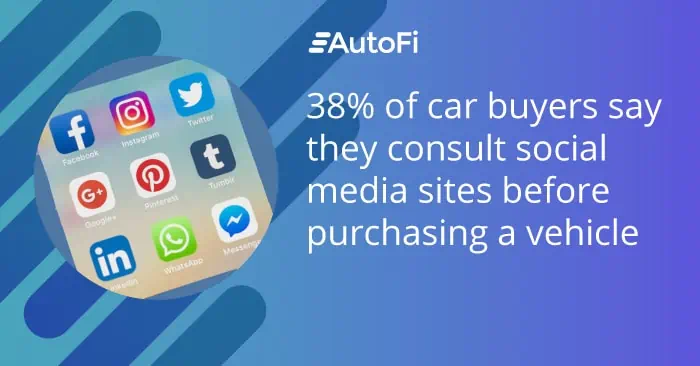
You may even try A/B testing on social media platforms. For example, target the same Facebook message to different audiences within Facebook.
- Understand Good and Bad Conversion Rates: Every type of digital marketing has an average conversion rate—the rate at which potential customers click on a link in an email, for example, or click on a digital ad. Some channels have average conversion rates of only 1.5 or 2 percent. Learn the average conversion rate for each channel to determine what’s a “good” conversion rate and that your efforts are meeting that number.
- Monitor and Track All Results: Many digital marketing channels allow you to track results easily. However, there are other times when you’ll need tools to monitor how your digital marketing is doing. For instance, call tracking software will track incoming phone calls that may result from specific digital marketing.
- Consider Hiring a Full-Time Digital Marketing Expert: Many dealerships hire agencies for their advertising or marketing. There are plenty of agencies with expertise in automotive marketing.
Still, dealerships should consider the value of hiring a full-time expert to work entirely on their digital marketing. When nine out of 10 car buyers start their shopping online, good digital marketing is vital to a dealership’s success. The return on investment for hiring a full-time digital marketer—an expert focusing exclusively on smartly marketing your dealership—can be exponentially high.
Auto Dealership Marketing Plan Template
Digital marketing templates can help auto dealerships track their digital marketing efforts, along with results from and costs of those efforts. Download our comprehensive and easy-to-use digital marketing template.
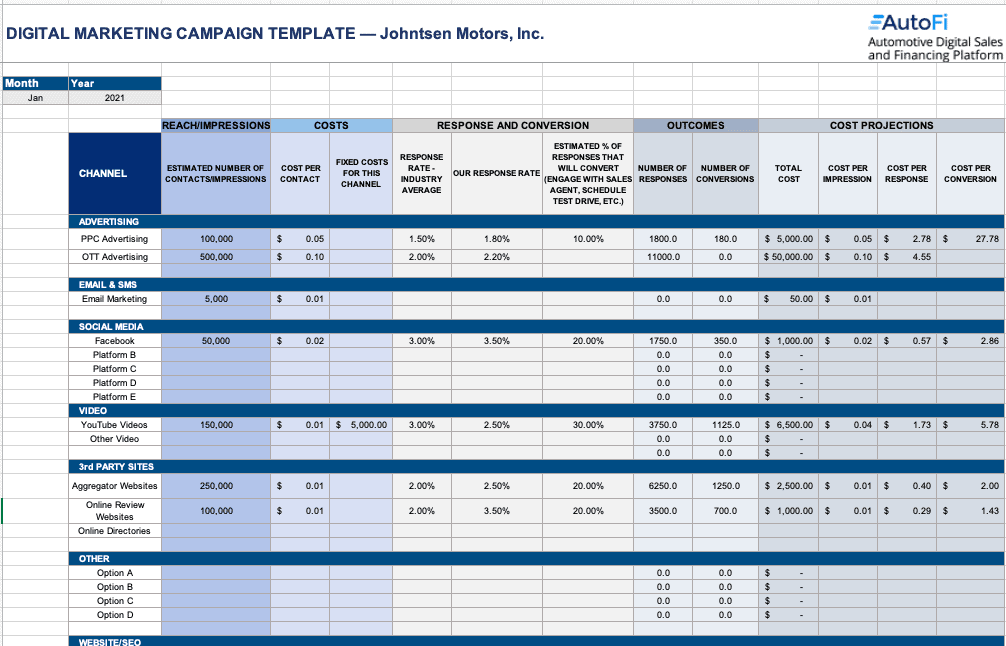
Download auto dealership marketing plan template
Sample Auto Dealership Marketing Plan
We completed an example digital marketing plan for an auto dealership to help you get started. The example plan uses the above marketing plan template.
Download auto dealership marketing plan example
Auto Dealership Marketing Ideas for 2021 and Beyond
Technology will continue to change how dealerships market themselves and their cars. Artificial intelligence (AI) will have a huge impact on digital marketing in the future.
Auto dealership marketing trends to watch:
- Virtual Reality on Websites: Consumers will be able to visit dealership websites and view semi-virtual reality videos of a showroom, sitting inside a new car, or even taking a test drive from the point of view of the driver.
- Chatbots: These tools are increasingly showing up on sales-focused websites, including those of auto dealers. They represent the first baby steps in AI. Chatbots can quickly and easily engage with website users. (For example, Facebook Messenger bots help you converse with over 1 billion people who use Facebook Messenger every month.) Chatbots can answer user questions or provide information based on their actions on the website. These efforts can move those users toward engaging with a dealership sales agent or visiting the dealership. Chatbots’ ability to engage with prospective customers will continue to develop.
- Other Artificial Intelligence: Integrating AI into websites and other applications will allow automotive marketers to reach customers at the right moment with an individualized marketing message. AI will help dealerships target their marketing with the right collateral, to the right customers, through the right channels.
Automotive Digital Marketing Platforms Make Online Marketing More Effective
Digital marketing platforms for the automotive industry give dealerships the tools they need to market their services and cars smarter and more effectively. The solution can also help dealerships engage customers, answer questions and move them through a sales process—all online.
These platforms can help your dealership meet prospective customers where they are starting to shop for a car—online. They can provide all the information customers need when they want it, making it a positive customer experience before they step inside a dealership.
Automotive Digital Marketing Case Study
AutoFi has given Sam Pack’s Five Star Ford in the Dallas metro area the tools it needs to and marketing. The dealership’s leaders understand that most people now do much of their shopping for a car online before visiting the dealership. With AutoFi’s help, Sam Pack’s Five Star Ford customers can click a “shop online” button on its website and move into an online trove of details about specific automobiles and the car-buying experience.
Brian Huth, General Manager of the dealership, says: “I think the future of any Ford dealership, when it comes to digital retailing, is you’re either going to get on it, or you’re going to be left behind. Customers—at the end of the day—do want to touch and feel the car. But they don’t want to go through the hassles of wasting hours on end trying to get the deal. So if you’re not moving toward a digital space, I think you’re pretty much going backward. This is the wave of the future.”
Since using the AutoFi platform in tandem with existing tools, the dealership has secured its spot at one of Ford’s Top 100 Volume dealers and continues to climb up the charts.
See how dealerships are using the AutoFi platform as part of their digital marketing efforts.
Reach Customers Where They Shop with AutoFi Digital Marketing Tools
The AutoFi platform has all the tools a dealership needs to engage customers and meet them where they want—online. Shoppers want to do more than just look at cars online. Many of them want to do everything from finding trade-in details to securing financing online and even making a purchase. That’s why dealerships need a tool to help them market their inventory effectively and deliver the information customers crave.
Learn more about how AutoFi’s digital retailing platform works .
Sign Up for a Demo Today
©2024 AutoFi Inc. All rights reserved
Quick Links
- Privacy Policy
- 548 Market Street PMB 53613 San Francisco, CA 94104-5401
- Sales: +1 (314) 455-7299
- Support: +1 (855) 933-0038
- [email protected]
Case Study: How a Luxury Dealership Won With Geofencing Marketing
What is geofencing, who should dealers target, why geofencing is great for marketing, case study: how a luxury dealership attracted 500 new customer prospects to its website, what was geofencing’s impact, justin croxton.

Case Studies
Constantly testing to drive the best results
Learn the difference in PPC results when a dealership changes from a competitor to Dealer Authority. The proof is in the results!

This case study focuses on the results of a SEO conquest campaign Geo Targeting a local city the dealership was not ranking for organically on Google.

Facebook is constantly changing its algorithm and it is critical to constantly A/B test to ensure you are getting the best results. In this case study, we compare results of Facebook Carousel ads versus Collections ads.

If you’re wondering how our Facebook Ads: car dealership campaigns stack up against the competition, well, the results are in.

- Dynamic Payments
- Request a Demo

Sign up for the Fuse newsletter to keep up with news, insights, and more
Lorem Ipsum Dolor
Maecenas vel neque at ex imperdiet sagittis.
Thursday, September 23rd at 11:00 AM ET
Nulla ut nisl a tellus pretium efficitur
- Donec blandit magna vel dignissim facilisis
- Vivamus aliquam enim condimentum ligula rutrum
- Etiam eu fermentum turpis.
Back to Resource Center
Essential Digital Marketing Strategies for Car Dealerships
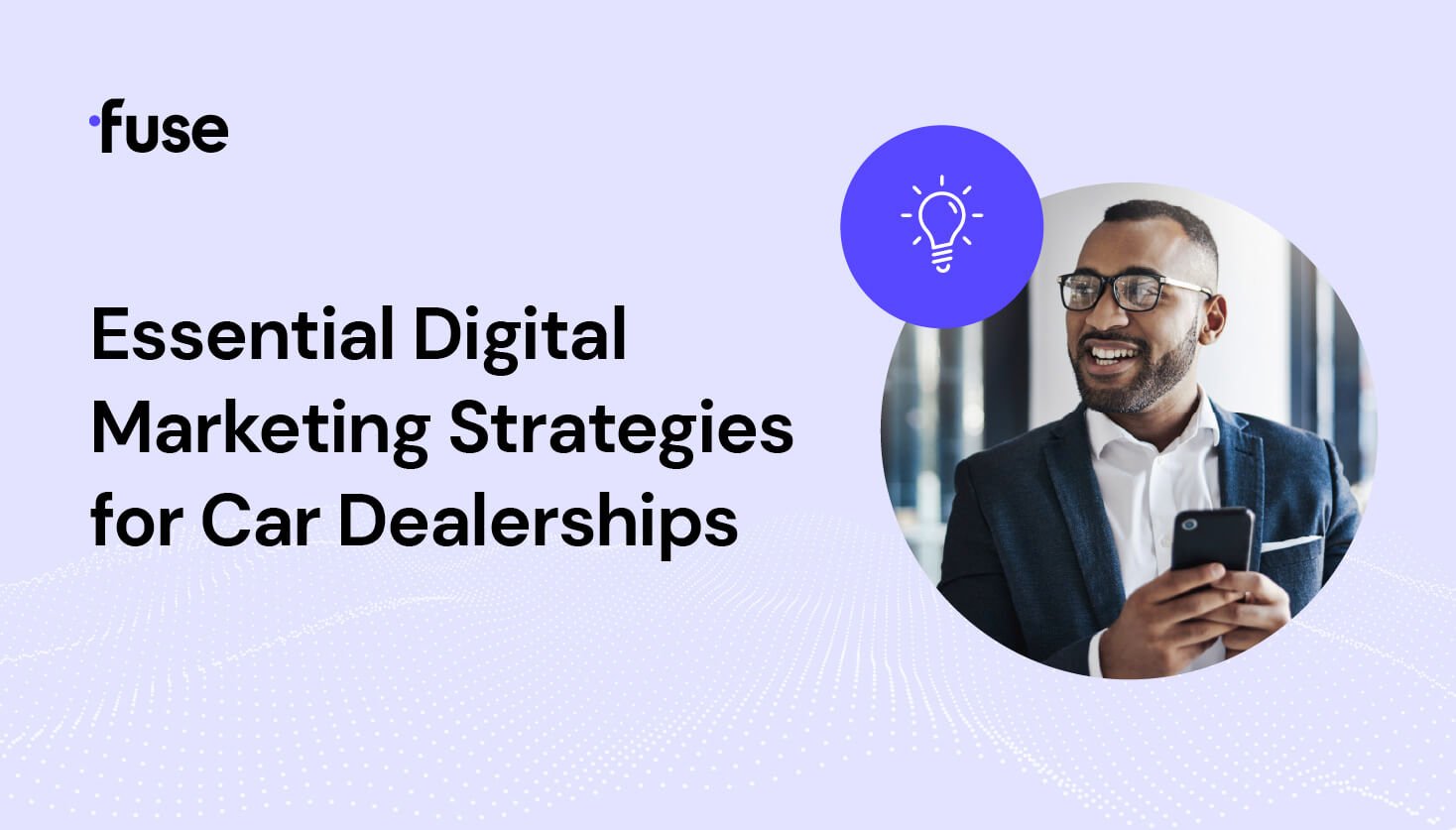
By: Tom Ryan 14 minute read
The times, they are a-changin' — especially when it comes to dealership marketing . Retail automotive marketing today is both fast-paced and cutthroat. The good news? By implementing the digital marketing strategies for car dealerships discussed in this article, you can gain a competitive advantage and be better positioned to ride out market fluctuations.
But first, let’s take a look at the current expectations surrounding the car-buying-and-selling experience. After all, marketing is but one part of the journey!
Why the Digital Experience Is More Important Than Ever
Compared to last year, twice as many dealers surveyed for the 2022 Capital One Car Buying Outlook think their customers are conducting nearly every aspect of the car-buying process online — from researching vehicles and selecting preferred makes and models to researching local inventories and understanding pricing, financing, and monthly payment options.
They’re not wrong. According to Cars.com consumer survey results, 38% of shoppers expect to complete the entire car-buying process online, with another 38% intending to purchase a vehicle in person but complete all paperwork online, saving them hours at the dealership.
How Much Does Online Presence Matter to Consumers?
When online reviews became a thing, some businesses tried to obtain as many positive reviews as possible while removing negative ones (or at least tried to drown them out with positive ones). Some went so far as to pay for positive reviews or have employees write reviews.
Consumers are a lot savvier now: they have a tendency to ignore one- and five-star reviews in favor of reading two-, three-, and four-star reviews. In other words, if a business has all (or mostly) glowing reviews, consumers are suspicious as to whether those reviews are real. No business can please all customers all the time. So people expect to see a healthy mix of positive and some negative reviews .
68% of people trust a brand more when it has a mix of good and bad reviews.
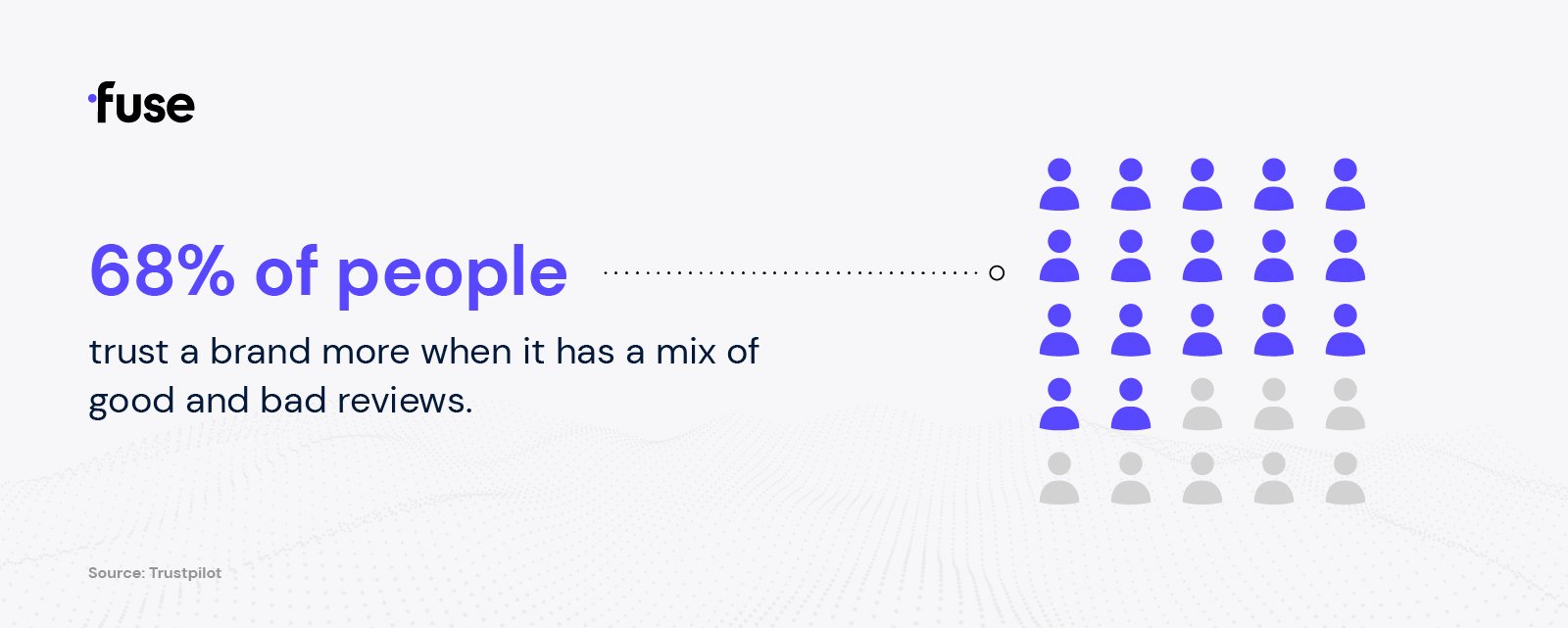
However, there is a sweet spot. In a 2021 survey, only 3% of respondents said they would consider using a business with an average star rating of two or fewer stars. In 2020, that percentage jumped up to 14%, so having the right balance of online reviews is carrying even more weight.
In addition, a Fan & Fuel survey reveals that written reviews carry more clout than stars or number ratings. And how businesses respond to those reviews matters, too.
Not only do 68% of car buyers rely on reviews to make an informed decision, but 50% of reviewers expect a response to their review within 7 days . Consumers also tend to view brands that respond to every review to be 1.7x more trustworthy than those that don’t. So, as you can see, consumer expectations are going up regarding how a business conducts itself online — and car dealerships are no exception.
>> Sign Up for Email Updates - Get Great Content Like This Delivered Right to Your Inbox
4 Phases of the Car Buyer’s Journey
For consumers, the process of buying a car seems similar to the process of purchasing other retail products and services. However, the car-buying process may span a longer period of time and involve more research — largely due to inventory scarcity and the sizable cost of the purchase. Not to mention that competition for car buyers today is fierce!
Given how much digital marketing has changed the approach to business in the last few years, the basics of the car-buying process still apply. They may just be handled a little differently. When putting together a dealership marketing plan, it's essential to account for pandemic-accelerated consumer preferences, a longer sales cycle, and the competition while addressing all phases of the car buyer's journey , including:
The Awareness Phase
In the awareness phase of the sales cycle, the car buyer experiences a "problem”. This doesn't necessarily have to be a problem — it can simply be a want. So maybe the problem is the desire to have a more reliable or updated vehicle. Or, it can be a need — like requiring a bigger vehicle to accommodate a growing family. The buyer then starts to gather information to better understand their wants and needs.
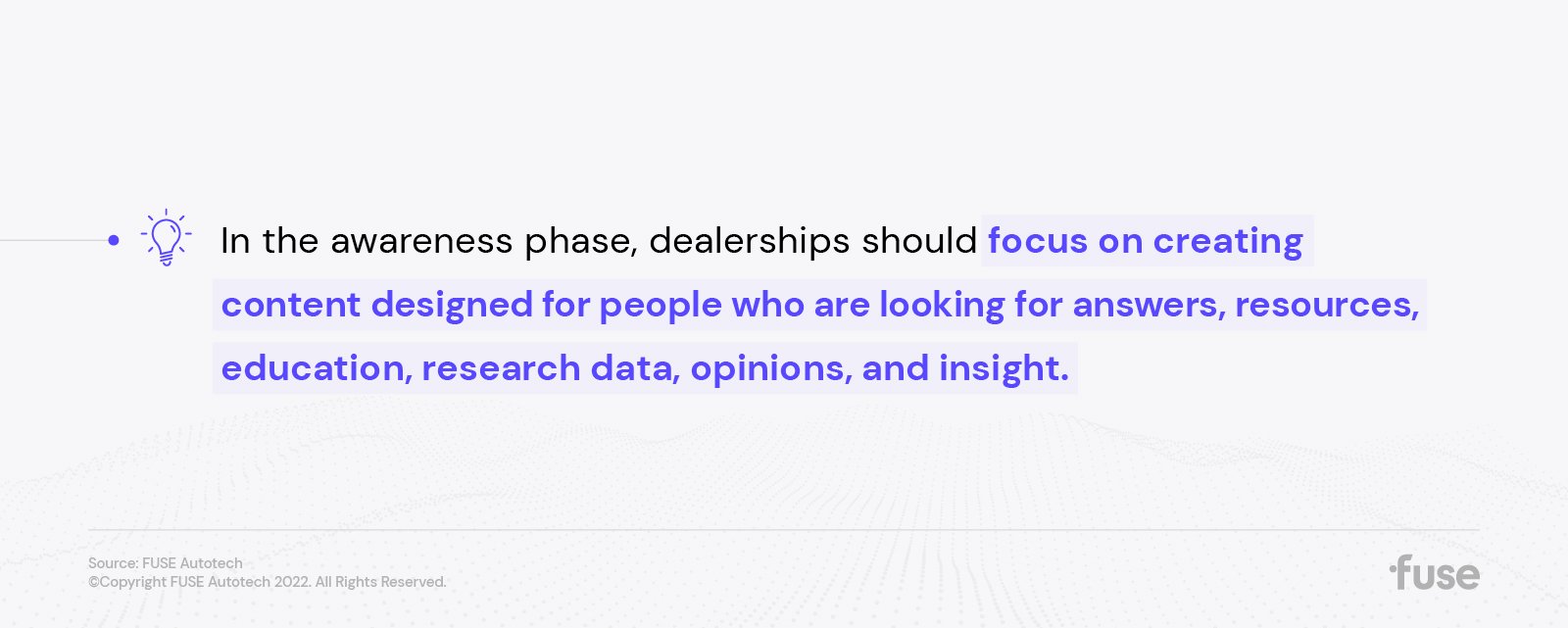
In this stage, dealerships should focus on creating content designed for people who are looking for answers, resources, education, research data, opinions, and insight.
The Consideration Phase
At this point in the process, the car buyer has defined their “problem” and is now actively looking for a way to solve it. They are convinced they need a bigger/more reliable/updated vehicle and are actively identifying their options.
Consider publishing dealership content comparing similar vehicle makes and models to attract car buyers in this stage.
The Decision Phase
The buyer has narrowed down their choices and makes a final purchase decision in this phase. In other words, it's time for the car buyer to apply for financing or head to the dealership for a test drive.
Clearly, this phase is one of the most vital. In fact, according to a Cox Automotive Car Buyer Financing Journey Study , over a third of the time spent by consumers in the car shopping process is dedicated to financing activities. This is also the stage where relationship management by the sales team normally kicks in.
The Delight Phase
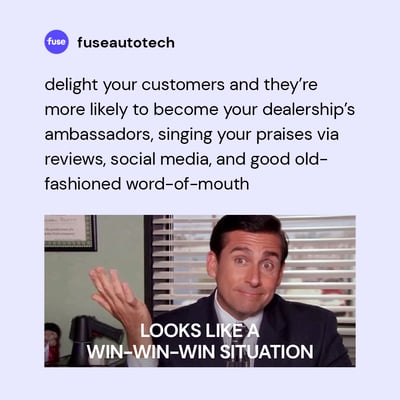
This phase is often missed in the traditional buyer’s journey map. It can also be viewed as the customer retention and loyalty stage. The customer has purchased a vehicle, but the cycle isn't over. This is the time to continue the relationship with follow-up communications and ongoing efforts to encourage service and repeat business.
It's simple, really. Delight your customers, and they’re more likely to become your dealership’s ambassadors, singing your praises via reviews, social media, and good old-fashioned word-of-mouth.
>> Download the Guide - Driving Dealership Customer Satisfaction and Profits with the Modern Retail Approach
5 Car Dealership Digital Marketing Strategies for 2022 and Beyond
How cars are bought and sold isn’t the only thing changing in the retail automotive industry. The way consumers think and act on the information they find online during the buyer’s journey is evolving, and car dealership digital marketing strategies must adapt accordingly:
1. Be Transparent
When we talk about transparency, we’re not talking about holograms. We’re talking about being open with customers and following through on brand promises. For example, how you collect and use customer data. If you say you aren’t going to sell their information but prospects start getting random calls from third-party companies, their trust will plummet — and so will the value of your brand.
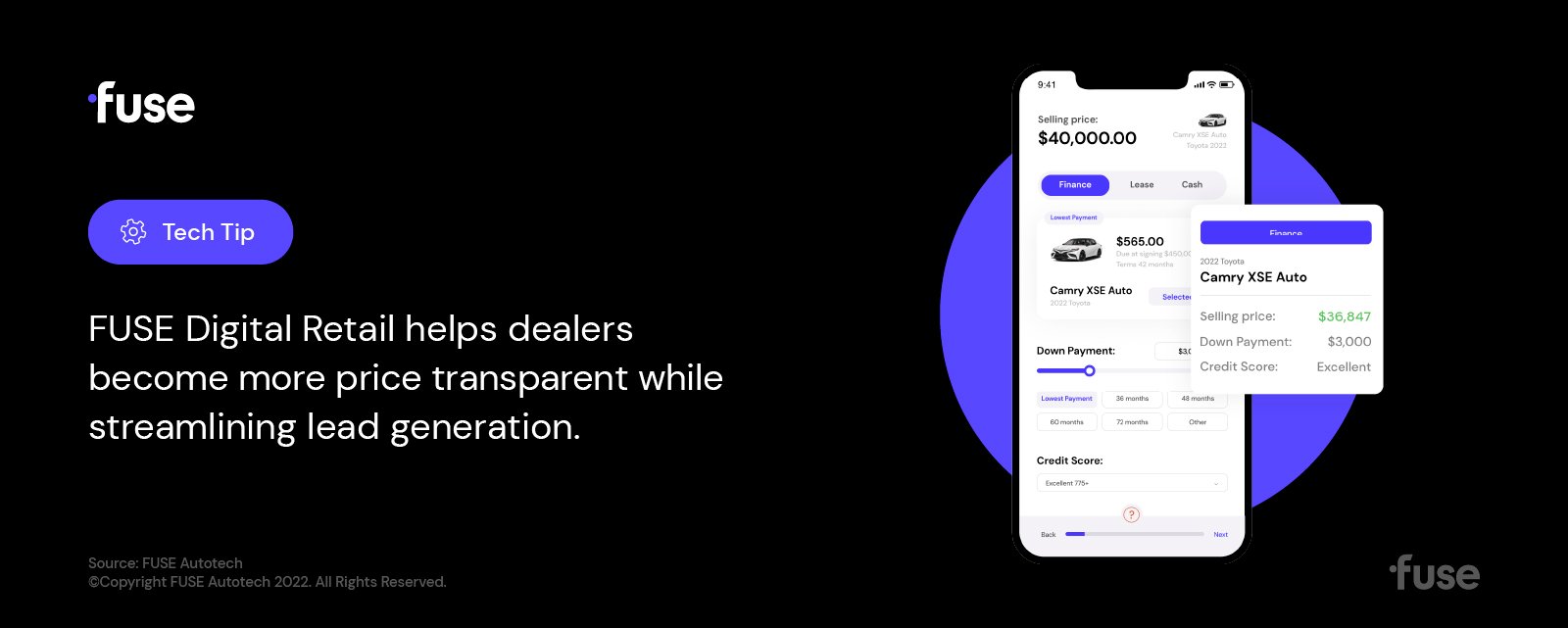
Digital retail technology can help dealers become more price transparent while streamlining lead generation. An excellent digital retail solution should mirror the familiar navigation and processes used outside automotive. For example, adopting no-haggle pricing and providing specific payment and financing details before requiring prospects to share extensive personal information is one way to build trust with consumers through transparency. When you present customers with multiple lending options, they feel like they have choices and control versus, “here’s your price, here’s your payment, now fill out the credit app.”
Automotive digital retailing also works seamlessly with the single-point-of-contact sales model , which is becoming popular among consumers and new entrants to the automotive industry. In this model, one person ushers the customers through the entire buying journey, which allows dealers to offer a more personal, transparent experience.
Genuine transparency can be uncomfortable for some at first, as it involves throwing open the doors to the inner workings of the business, revealing a dealership’s true goals, values, and prices. However, dealers who have embraced transparency — especially price transparency, like Walser Toyota — are reaping the benefits .

2. Be Everywhere
A trend accelerated by the pandemic, digital-forward buying and selling , has gone from leading edge to mainstream. Visibility in the digital realm is a must to drive dealership sales, especially as more and more car buyers start their research online.
Search Engines
It is in every dealership's best interest to claim and set up a profile with Google Business Profile (GBP). In fact, according to BrightLocal’s Insights Study , car dealerships get the highest number of calls and website visits via GBP than any other industry. The best part? GBP is free, and you can manage your profile from Google Search and Maps to reach even more leads and customers.
We all know that search engines are a way for people to search for pretty much anything. But for dealerships, search engine marketing is another valuable tool for driving traffic to their websites and, ultimately, foot traffic to their physical stores. Dealers can pay to have their listings appear at the top of the search results or create web content to rank organically. There are also a plethora of dealership search engine optimization strategies for ranking higher in these organic search results.
As stated above, online reviews — and the right mix — are mission-critical for every dealership. The #1 priority is Google, followed by social media and Dealer Rater . According to Search Engine Journal , Google appears to favor businesses with high volumes of positive reviews, placing them in the coveted Map Pack positions at the top of the organic local search results. These Map Pack positions appear in search results more than 30% of the time, and their links get over 70% of the traffic from organic search.
Social Media Platforms
When researching before buying a car, many car shoppers make the rounds online to see what each dealership has to offer. That includes websites, business profiles on review sites, and social media. These platforms allow you to add video, which is an excellent selling tool for dealers . Video allows you to create a bond with customers. It provides a way to highlight a vehicle's features in a way a photo can't accomplish.
It also helps you reach people who would rather watch or listen to something than read about it. Video lets you cover your bases.
65% of people are visual learners, 30% are auditory learners, and 5% of people are kinesthetic learners.

A " native ad " is content written to match the editorial content in the publication. It is often written like an article but is paid for by an advertiser. Native ads in car enthusiast publications could help boost your dealership’s sales.
Display Ads
Make sure you’re leveraging all aspects of Google, including the Google Display Network. It can truly open doors for dealers by providing access to millions of prospects as they browse websites, apps, and Google-owned properties like YouTube and Gmail. A display campaign is one option you can choose when setting up Google Ads. Google Vehicle Ads and a new pilot program for Google Vehicle Listings are great options for dealerships to explore.
Another type of digital advertising that’s gaining traction is the use of GPS or RFID technology to create a virtual geographic boundary, called geofencing . Special software triggers a response when a mobile device enters or leaves a specific area. This can be especially useful to capture leads in your surrounding area.
It's funny how things come back around. Those who thought commercials had gone the way of Blockbuster will be surprised to know they're making a comeback. Consumers are becoming more accepting of viewing commercials to watch shows for free. As more streaming entertainment options come online, people have more options from which to choose. This may be a good thing, but costs can add up when all of these different options charge a fee. OTT advertising on Roku, Hulu, Amazon Video and Fire TV, and Sling, among others, is yet another way to reach car buyers.
Podcasts
Any opportunity to get your name out there as an authority is a good thing. For the best, most targeted audience, reach out to local podcasts about guest appearances or seek out sponsorship opportunities. If you're not a local podcast listener, a quick search can help you find out which ones are the highest-rated and how to sponsor an episode.
Mobile Phones
Potential car buyers are driving by your dealership daily with their mobile phones in tow, utilizing mobile apps like Waze and Google Maps for turn-by-turn navigation guidance and real-time notifications regarding traffic, hazardous road conditions, and police presence. Each month, more than 90 million U.S. consumers use Waze. Google Maps boasts 154.4 million monthly users. Thus, ads on Waze and Google Maps can be highly effective tools to add to your marketing toolkit.

Managed Chat
Adding a chat feature enables engagement between customers and sales teams so they can capture leads in real time. I know we're promoting many other channels for capturing leads. However, a dealer's website is still at the center of any successful dealership marketing plan. And while that website is the digital hub, some dealers are choosing to forego website form completions for lead capture in favor of managed chat or messaging sessions . Doing so allows salespeople to follow up right away. Because nobody likes to fill out forms and wait for a call. That doesn’t fly in today’s face-paced, digital world.
Email Inboxes
Believe it or not, email still exists — and it works ! Plus, it’s cost effective. You don’t always need a flashy new email campaign to find success: the right strategy wins out in the long run.
Take, for example, this email marketing case study for a Ford and CDJR dealership. As a result of sending nine follow-up emails over a 14-month period, email engagement contributed to more than 150 vehicle sales. Just be sure to use your dealership’s first-party information , or you risk harming your email deliverability and IP reputation.
In fact, in a world that's becoming more and more "cookie-less," having quality first-party data is more important than ever. Companies like FUEL by Cars.com sell this kind of data, but the best data is always your own .
3. Be Ready to Follow Up
It can be a full-time job keeping up with all the online business and leads. Every dealership needs a dedicated team to handle these critical tasks, such as a strong Business Development Center ( BDC ) or salesforce who can streamline the process.
4. Be Willing to Listen
Your customers are treasure troves of information. Don't be shy about sending out surveys and asking for testimonials to bolster your business and gain insights on how you can improve.
5. Be Prepared for Change
Shortages and high costs have created a new industry landscape that all dealers have to address to remain competitive. Being armed with these essential digital marketing strategies for car dealerships can help you navigate the ebbs and flows and come out ahead.
Get in touch today to find out how Fuse can help your dealership compete.
>> See How Fuse Transact Works - Watch the Video Now
Shift sales into high gear.
Experience the future of financing for yourself. Schedule a demo today.

Related Resources
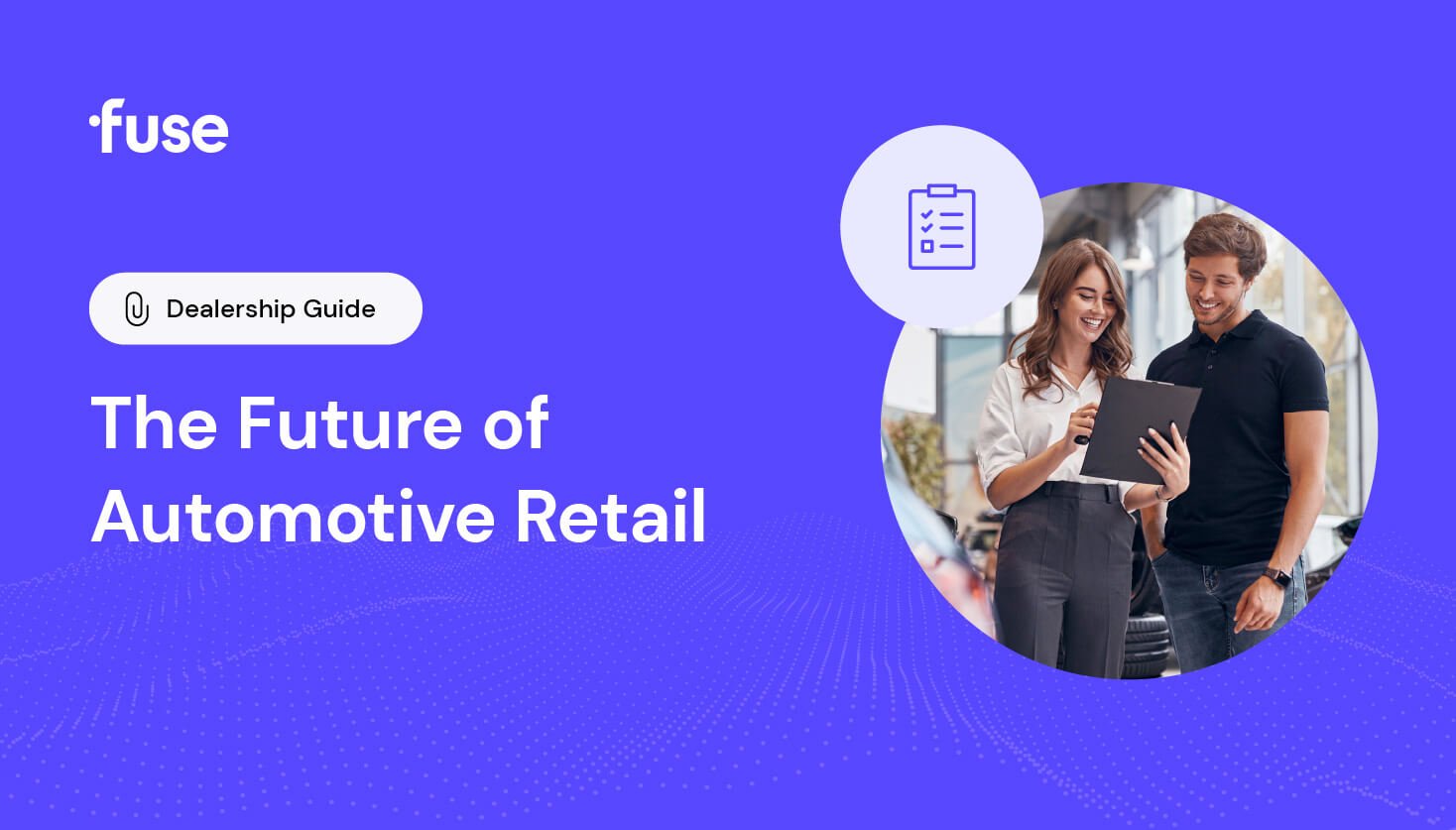
The History of Automotive Retail and a Guide to the Dealership of the Future
Today’s electric and hybrid cars appear nearly unrecognizable when compared to the first gas-powered car models created in the 1880s. The same cannot be said for the actual process of buying a...
10 min read
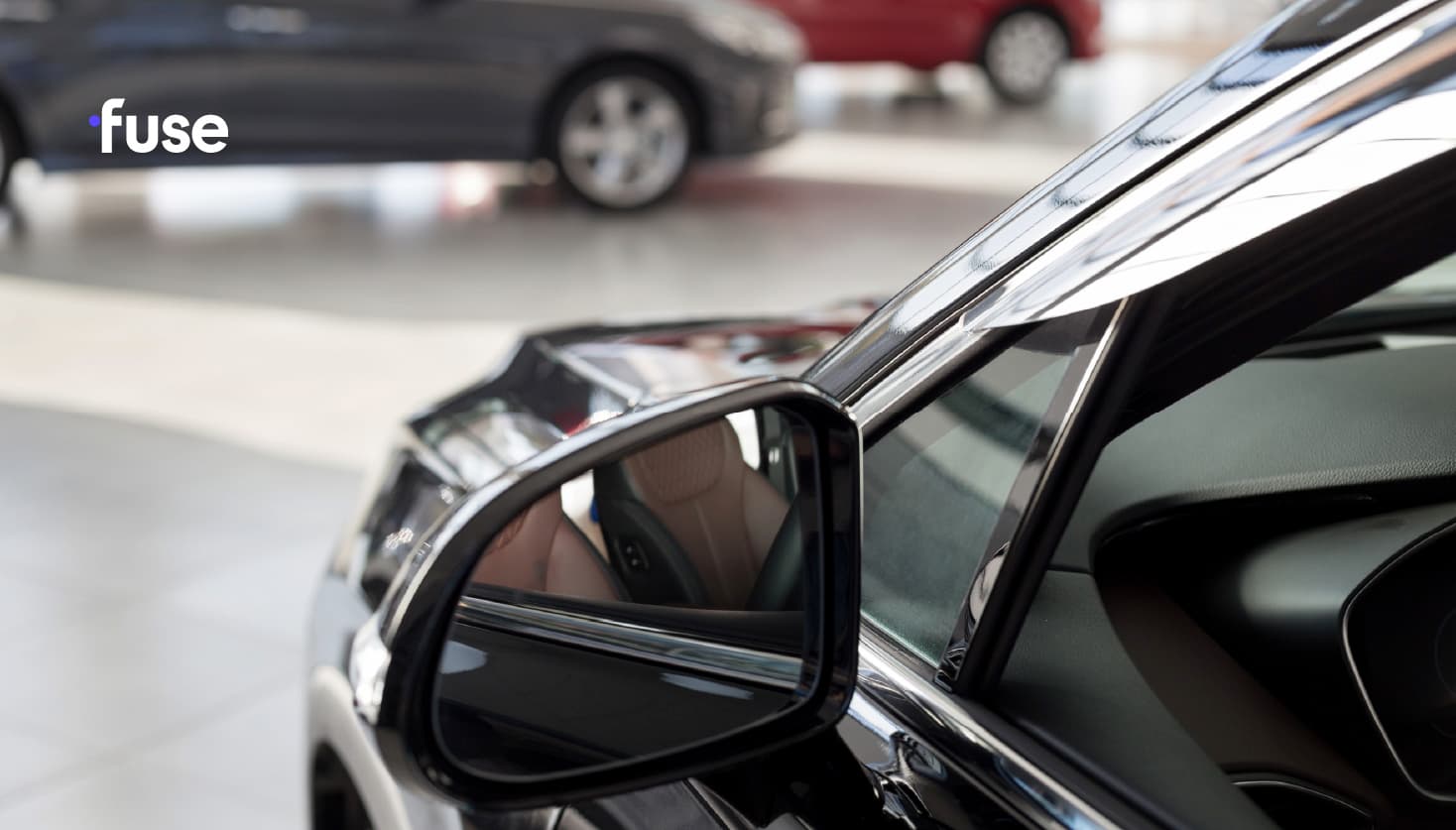
Solved: How to Build Sustainable Dealer Profitability
With retail automotive dealers coming off two years of record profits, now is the time to position your dealership for sustained profitability when the market inevitably normalizes. Let’s take a look...
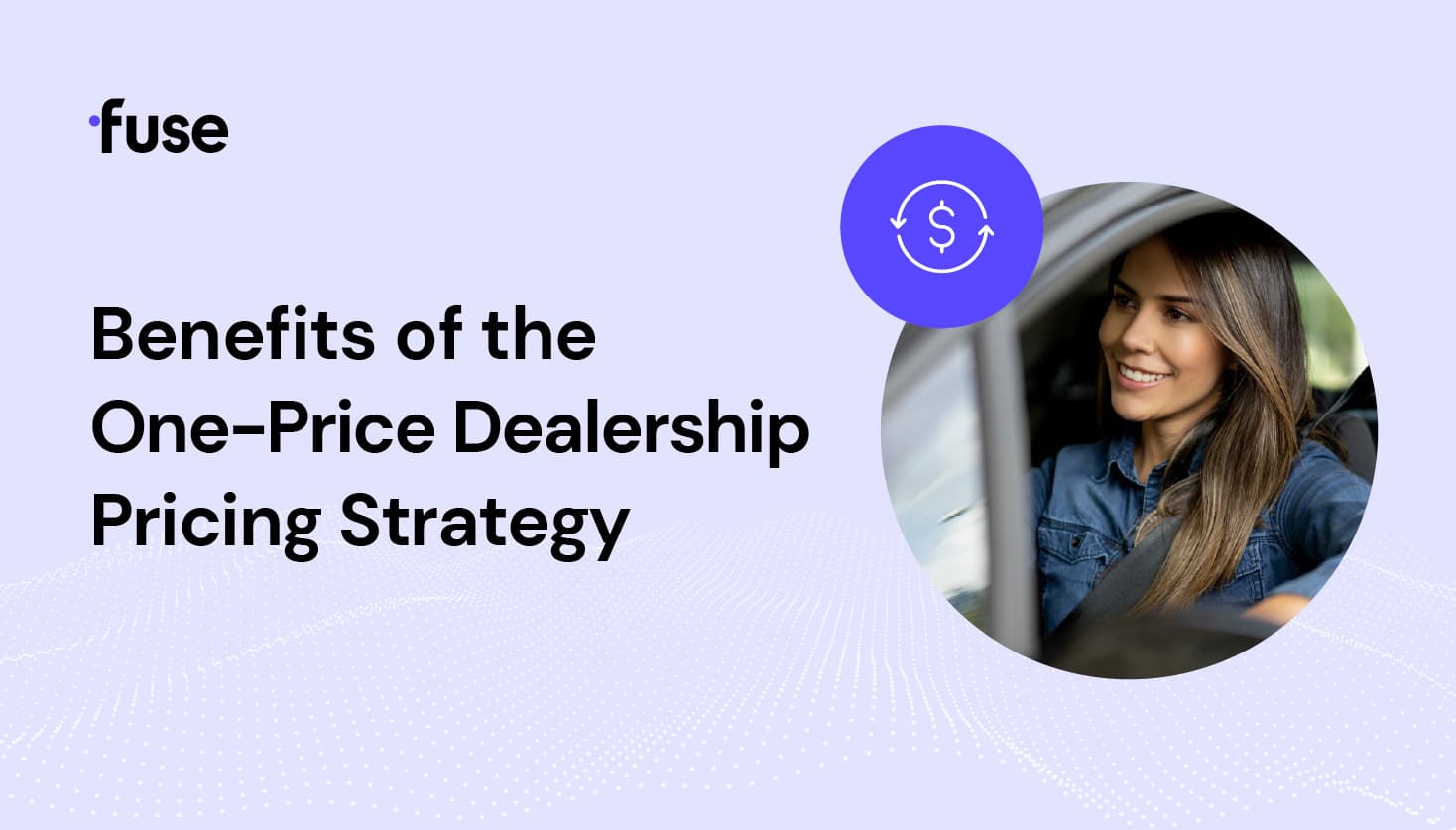
Dealership Pricing Strategy: Understanding the One-Price Model
When buying a new vehicle, consumers are often left wondering whether they got the best deal. Today’s car buyers want a streamlined, transparent shopping experience without having to haggle over...
Streamlined, sleek, and incredibly fast, Fuse is your all-in-one solution to selling cars in-store and online in 30 minutes or less.
- Cookie Policy
- Privacy Policy
Get Started
- New Customer Registration
Copyright 2024 Fuse Autotech, All rights reserved.
- All Solutions
Fleet Solutions
- SuperVision
Vehicle Claims
- XpertEstimate
Vehicle Repair
Vehicle Solutions
Additional Solutions
- Our Customers
- All Resources
- Digital Media
- Industry Insights
- Product Resources
- Auto Finance
October 10, 2022
Ultimate guide to digital marketing for car dealerships in 2022
Data Management
Market Insights
Product Knowledge
Selling vehicles isn’t like it used to be. In the past, you could depend on a steady flow of potential car buyers after placing a few ads on the radio or in print. Today, customers take a more active role in the buying process. Instead of visiting the dealership, they’re doing online research. That’s why it’s imperative to have a marketing strategy—especially a digital marketing strategy—to guide potential consumers to your car dealership.
In this guide, we’ll explain what digital marketing is, discuss why it’s important, and provide several digital marketing strategies to help you reach more customers and boost your sales.
What is digital marketing?
Digital marketing is a multifaceted approach to promote services, goods, and brands using the internet and electronic media. It relies on various channels, such as mobile apps, websites, social media platforms, and instant messaging, to improve customer engagement.
Essentially, if a marketing campaign involves online or electronic communication, it’s digital marketing.
Why is digital marketing important for car dealerships?
There are many benefits to implementing a digital marketing strategy for your car dealership. Here are some of the advantages:
Increase online visibility
The first organic (unpaid) search result in Google Search has an average click-through rate (CTR) of about 28%. This means that if your website link is in this top spot, you are likely attracting more potential customers.
If your car dealership relies only on conventional marketing strategies, it’s time to make changes. While radio, TV, and billboards play an important role in marketing and sales, their impact has lessened in today’s environment. Consumers now spend most of their time online, so engaging with them there will boost your sales.
Personalize the experience
Digital marketing allows you to market the right products to the right customers. And tailor your actions to provide better value to your audience. For instance, when a potential car buyer visits your site, allowing them to personalize their experience will help you better meet their needs. This may be through a chatbot feature, newsletter subscription sign-up, or by publishing relevant and browsable content so viewers can find answers to their questions and solutions to their problems on their own.
Engage with customers directly
Social media is a great platform to ensure engagement with your potential buyers or target audience. Social media platforms can help you engage potential buyers and create a community where they can ask questions, voice their concerns, and be part of a conversation.
By responding to specific questions, your car dealership can be seen as a knowledgeable and trustworthy market leader. This can lead to potential customers being more likely to buy a car from you, as a bond of trust has been established—a bond that may be lacking between your competitors and potential buyers.
The fact that you can immediately and directly engage with your target audience allows for valuable feedback opportunities from prospective buyers. This allows you to continuously improve your digital marketing strategies as your target audience evolves.
5 Digital Marketing Strategies Your Car Dealership Should Consider
Here are some of the best digital marketing strategies to help you attract and retain today’s connected car buyers:
1. Email marketing
Email marketing continues to be one of the most effective digital marketing strategies. In fact, it has the highest return on investment of all kinds of marketing, averaging about $42 in return for every $1 spent .
And personalized emails convert better. Research conducted by G/O Digital revealed that about 35% of car buyers prefer emails based on their interests. Further, 28% said they would click on a car dealership email if it includes a model, color, or style they’re interested in.
With today’s sophisticated data sets, you can segment prospective customer audiences based on a wide range of selects, including their current car’s make, model, and Black Book value, those most likely “in the market” for a new car, and other demographics, such as hobbies, income, and more.
2. Social media marketing
A study conducted by the CMO council revealed that 23% of buyers talk about purchasing a new car on social media and about 38% say they’ll consult social sites prior to purchasing. So, if you’re not posting and advertising on social media platforms, like Pinterest, Instagram, Twitter, and Facebook, you’re likely missing out on opportunities.
An effective social media marketing strategy includes sharing useful, relevant, and interesting content on various social channels several times a week. It also includes engaging in conversations on your pages, posting inventory and happy customer photos, responding to reviews, and making your dealership contact details easily accessible.
3. Search engine optimization
Search engine optimization (SEO) refers to the process used to improve the viability and visibility of your website through online searches. . Implementing good SEO strategies will, in time, increase the likelihood of your website being served to people searching for car dealerships. According to Google, 95% of car buyers use digital research as a source of information . In fact, twice as many begin their search online than by visiting a dealer. So if your website isn’t performing well and isn’t one of the top displayed sites through Google or other search engines, you’re losing 95% of potential opportunities.
Perhaps the two most important tactics of a strong SEO strategy are high-quality, keyword-focused content publication and link building. While it may take time for search engines to recommend your website over others, you will no doubt improve the quality and quantity of your site traffic, thereby increasing the likelihood of your website getting discovered by people looking for a new car.
To create relevant content using the right keywords, you must understand your target audience. For example, if you want to attract potential buyers searching for California car dealerships, consider including terms like “automotive car dealers in California, “auto car dealership in California”, or “car dealerships near me” within blog posts or on your website pages. But to really improve the quality and relevancy of your content planning, use a keyword research tool to best identify and discover new industry-related keywords. Many of these tools are free and easy to use and will help you determine the right keywords, including Spyfu and WordStream.
4. Mobile optimization
Mobile devices changed how buyers research cars they want, as well as how they discover new or different vehicles. A study commissioned by Facebook revealed that 71% of consumers use their phones during the vehicle purchasing process, and about 58% said that in the future they only intend to use their smartphones for all their vehicle research.
A mobile-first and responsive dealer website is more crucial than ever. Google and other search engines rank websites on the overall page experience. This includes, among many other factors, the usability of a website on a cellphone and the page load time. Ensuring your website is optimized for mobile devices increases your SEO rankings and chances of gaining new customers.
Here are a few tips to implement yourself or pass to your web developer:
- Test your website: Consider testing your site pages on several devices to learn page loading times, whether the content is legible and accessible, how well the design and features work on smaller screens, and if the navigation is easy to use.
- Use CSS to make your site responsive: Responsive websites automatically and smoothly adjust the layout and flow of content based on the size and resolution of the device. You can use CSS to implement media query ranges, also called responsive breakpoints, so browsers load different webpage layouts depending on the device.
- Choose a responsive website theme: Because responsive sites perform better on all devices, consider installing a new responsive theme when designing a new site. To determine if a theme is responsive, access a demo before installing it. Theme demos often include previews of how pages will render on different-sized screens.
5. Video marketing
Video marketing refers to the strategic use of videos to promote and inform about services or product inventory and to boost engagement on digital and social channels.
About 66% of marketers say they’ll either increase or maintain their spending on video this year. By its very nature, video marketing better captures viewers’ attention and is often more engaging compared to other mediums, such as imagery and text. In fact, according to a study by Google, 64% of people who used YouTube while purchasing a car were influenced by it. That’s more than magazines and newspapers.
Here are a few tips on creating effective video marketing at your car dealership:
Know what your audience wants in the video
When you organize each video, consider what your audience would like to watch. For example, if you’re filming a tour of your dealership, consider asking yourself questions like, “What areas of the dealership are customers interested in?”, “What do customers want to know about our dealership?”, or “What questions do buyers have about our dealership?”. When planning each video, always keep customer needs top of mind.
Showcase more than your dealership’s inventory
While your auto inventory may be your dealership’s focus, buyers want to know more about your dealership’s values, policies, team, and how you can help them after the completed sale. Instead of only filming walk-throughs of every new vehicle, consider capturing everyday life on the lot and introducing key team members on the floor and in the service department. You’ll educate and build relationships with future customers.
Stay on brand
Is your dealership customer-centric and friendly? Or are you known for a more serious buying experience? Whatever the brand personality, make sure to highlight this when recording. Keeping a consistent brand voice allows your dealership to capitalize on its brand reputation and share it with new audiences.
Keep it short
People know no longer have the interest or attention span to watch several five-minute videos in a row. Thus, when creating video, keep it short. Videos that are up to two minutes long get the most engagement. After two minutes, there’s a significant decrease.
Accelerate your car dealership’s operations now
Understanding your buyers is the first and most important step in developing successful digital marketing strategies. Through a combination of social media, email, website, and video marketing tactics, you will improve your car dealership’s online visibility and reach a more engaged, interested audience. If you want to improve your digital marketing strategy, consider using Solera’s AutoPoint . This robust suite of solutions connects all the dots of the vehicle’s lifecycle. It offers every tool you need to promote sales, launch effective digital marketing campaigns, supply proper documentation, provide maintenance support, and improve customer retention. Reach out to us at Solera today and let us work with you to create a digital marketing strategy that will help you rise above the competition.
Share this article:
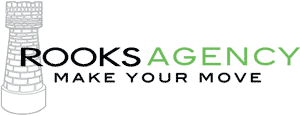
Case Study: Nissan Now
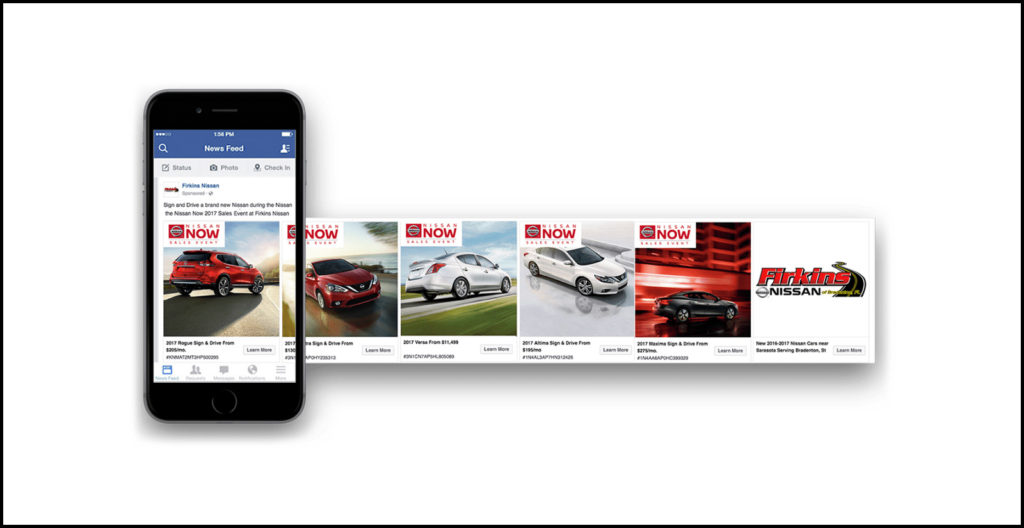
Explore the intricacies of car dealership marketing as we dissect our case study on Nissan Now. With our expert knowledge and experience, Rooks Agency unveils the process behind crafting impactful social media campaigns for automotive businesses.
Create a social media campaign that would create both upper and lower funnel buying activity for a “Nissan Now” campaign.
Because Facebook boasts a large active user base and Nissan offers a diverse product range, we could define our target audience as almost anyone over the age of 18. However, launching a campaign to such a broad demographic would not be cost-effective. The agency needed to find and target the best and most likely Nissan prospects as well as match the right product to the right person.
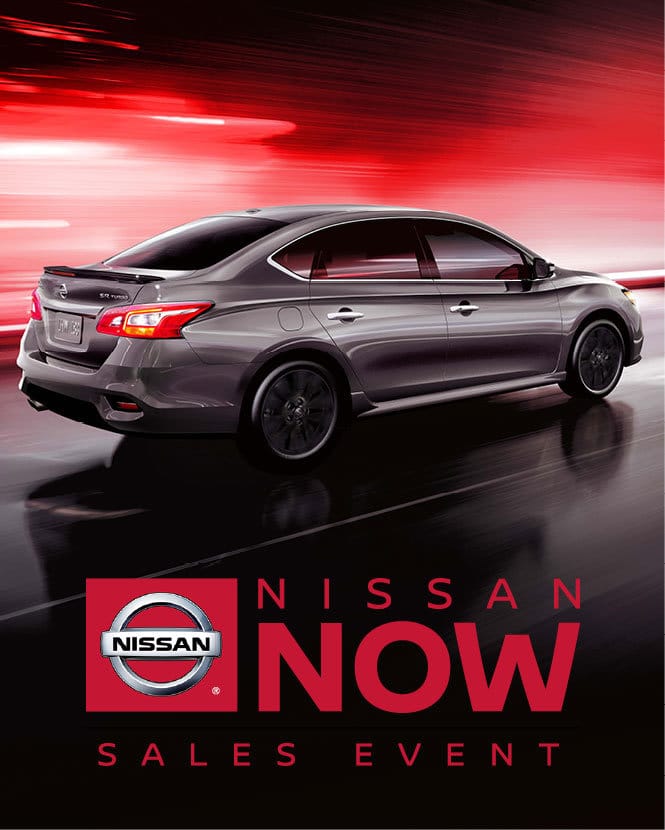
Believing our top prospects owned a Nissan in the past, Rooks Agency developed a Facebook custom audience using the current database. To expand upon that our team developed a Facebook “Look-a-Like” audience using existing customer data to find other potential customers who have the same interests and patterns.
After establishing the potential targets, we initiated the launch of a Facebook carousel ad displaying the full line of Nissan products with attractive Sign and Drive lease offers.
As each individual interacted with a particular offer, we directed them to product pages specific to the ad they engaged with.
Utilizing Google Tag Manager the prospect’s device was “tagged” based on the web pages they visited. Once tagged, they moved into our “lower funnel” marketing effort and we were able deliver vehicle specific ads based on the product or products of interest. These “lower funnel” ads were continuously running video ads designed to reinforce the prospects interest.
As part of a fully integrated car dealership marketing campaign, these social media advertising efforts helped produce a large increase in vehicle sales.
Ready to drive your car dealership’s success? Contact Rooks Agency today and let our expertise fuel your social media marketing journey!
Similar Posts

Automotive AdWords – Top 3 Ways You Are Getting Ripped Off
Discover the pitfalls of Automotive AdWords marketing in our video blog, as we unveil three common money wasters plaguing the industry. Ready to learn more?
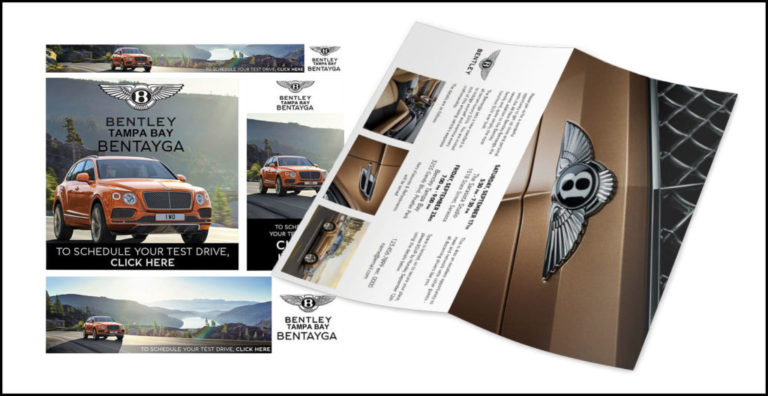
Case Study: Bentley Bentayga National Launch
Objective Create a targeted marketing campaign to introduce the all-new 2017 Bentley Bentayga to its most likely prospects. The campaign needed to provide an upscale “concierge” feel that aligned with the expectations of the ultra-luxury client. Challenges The Bentayga marks Bentley’s first SUV addition to its vehicle lineup. With the price point of the Bentayga…
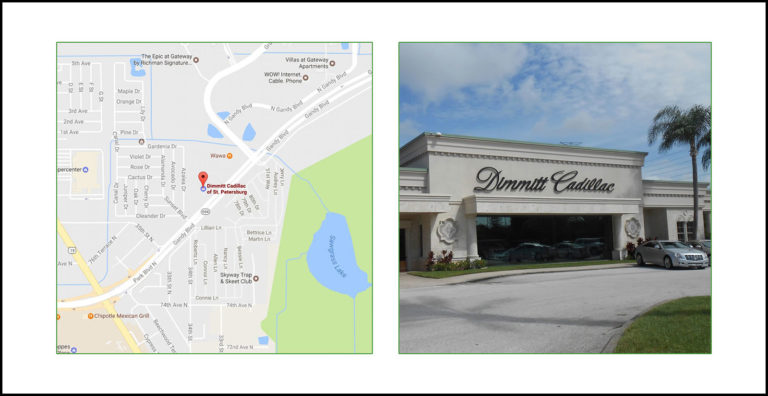
Case Study: Cadillac AdWords Campaign
Embark on a journey through the world of car dealership marketing as Rooks Agency unveil the strategic insights and innovative tactics driving success in this dynamic industry. Objective Create a comprehensive AdWords campaign that avoids DMA overlap and eliminates territory conflict between two Cadillac stores that were owned by the same group. In addition, eliminate…
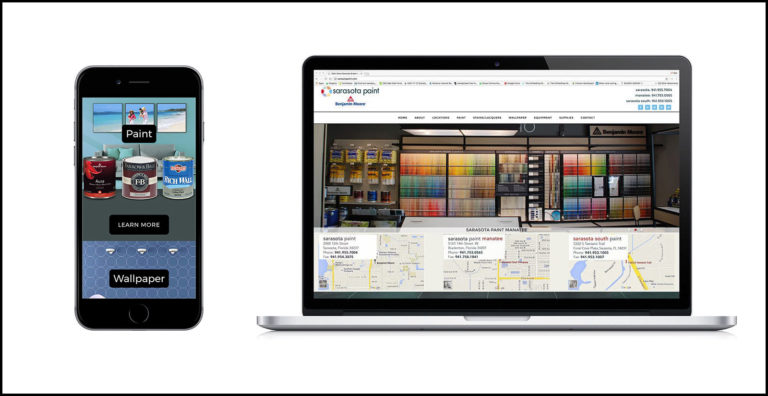
Case Study: Authorized Benjamin Moore Retail Website Design
Explore how Rooks Agency transformed an authorized Benjamin Moore retail store website, well-optimized for SEO and Google Ads Campaigns to attract customers and boost sales. Objective Create a retail store website that would primarily feature Benjamin Moore Paints as well as allow the retailer to supplement the paint offerings with wallpaper and paint sprayer products….
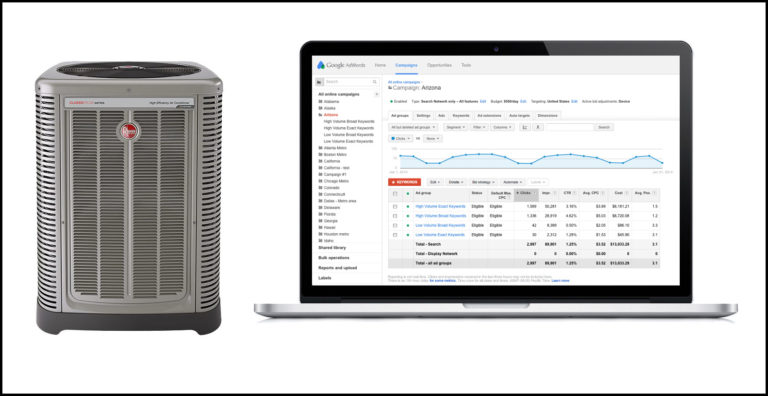
Case Study: Rheem Regional Google Ads Execution
Objective Create a highly effective Google Ads campaign for A/C Warehouse, the area’s largest Rheem distributor. Challenges The client serves the entire Tampa Bay Area. However, pricing varied from area to area as well as services. Although the digital budget was substantial, achieving a strong ROI on Google Ads remained crucial. Solution By creating 14…
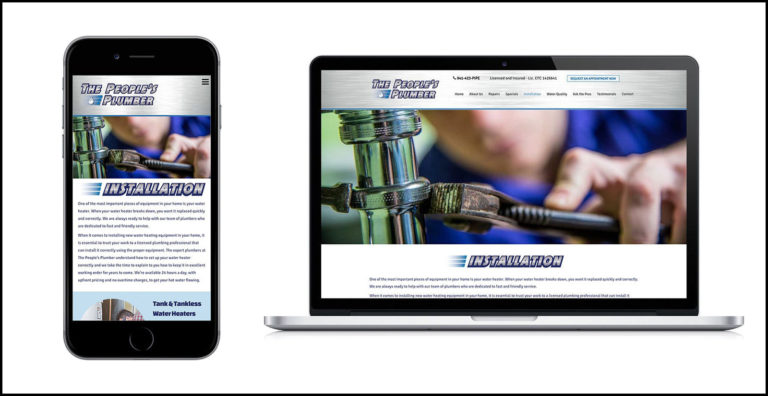
Case Study: The People’s Plumber
Discover how Rooks Agency transformed a local plumbing business with a custom plumber website, designed to enhance online visibility and attract more customers. Objective Launch a complete branding package and digital campaign for The People’s Plumber. Challenges: The business did not have an existing website, logos, or marketing materials. The client wanted a “shiny metal”…

< Blogs
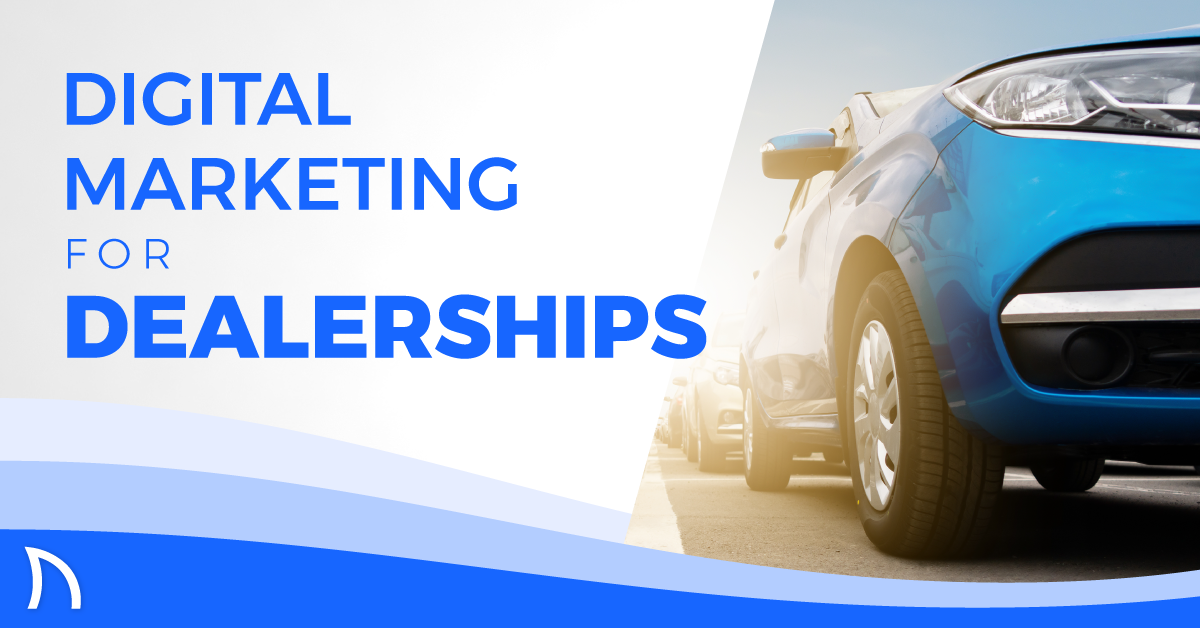
Digital Marketing for Dealerships: How to Increase Auto Sales Through Online Ads
There are about 17,000 new car dealerships in America right now, and every single one of them is vying for more customers in a heavily-saturated market. As improvements to vehicle manufacturing extend the life of our automobiles and new sources for purchasing cars grow at an increasing rate, dealerships are put in an even more challenging position as they aim to increase their prospect lists. Though free test drives, warranty promotions, and chocolate chip cookies make for nice perks, the days of winning a new customer’s business from fringe benefits alone are long gone.
Stats from V12Data suggest that car buyers spend 59% of their time online researching, and third-party platforms account for the most used websites for car shopping (used by 78% of shoppers). This means that over half of prospective customers are already close to making up their mind before entering a dealership, and a dealership’s website or online catalog is less commonly viewed than a third-party platform’s catalog. It’s no wonder new sales reps at car dealerships can have such a hard time getting their client portfolio started!
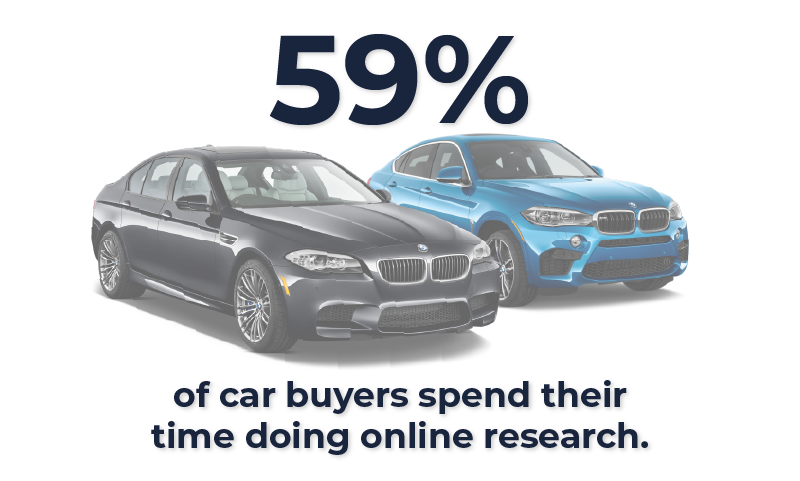
The automotive industry is known for pushing the envelope on technological advancements, yet is still pretty far behind when it comes to driving in new leads and prospects through digital technologies. With so many opportunities lingering on search engines and social media platforms for car (and truck) dealerships to grow their sales pipeline, we postulate that digital marketing can help thwart off the impending downturn that faces many automotive dealers at this moment. Maximizing one’s advertising dollars through Google Ads, Facebook Ads, and other digital marketing practices is a proven way to generate more leads for car and truck dealerships. Here’s the proof:
A Case Study from a Premium Car Dealer in Fargo, ND
Almost a year and a half ago, we were approached by one of the premium car dealerships in our local community who was in need of assistance with their digital advertising. Though they had been doing digital marketing for years, they weren’t achieving great results, they lacked the proper measurements for success, and they were having some issues representing their brand appropriately. Our team of sharks was eager to jump in the waters and help them out.
We offered a highly-targeted digital strategy that relied on Google AdWords, improving advertising through Facebook, and offering dynamic remarketing. On Google, we deployed Search Ads that targeted lower sales funnel users searching for new and used cars. Through Facebook, we targeted ready-to-buy users and promoted our client’s message of “vehicles for any budget” to counteract inaccurate public perceptions. Finally, we used dynamic remarketing to reach recent website visitors with vehicle inventory they had viewed.
The results? The organization experienced a 22% increase in percent of cars sold in their first year, set 12 new records for cars sold per month (12 out of the 16 months), and beat their previous annual year record of cars sold by over 150 cars.

Through employing a more strategic approach to digital marketing, continuously optimizing and improving upon accounts, and working with our experienced team of digital strategists and creatives, we have provided consistent value to this local dealership and it’s also a part of what’s prompted us to write this blog. We see such an opportunity for additional car dealers, truck dealers, and other automotive dealerships to benefit from digital advertising – and we hope this article will help be the extra push you need to give it a try for yourself (or by using our team’s expertise!).
Why Should Auto Dealerships Try Digital Advertising?
If you’ve come across this article, it likely means that you’ve been struggling with your existing advertising and are looking for something new. Congrats: step one is an acknowledgement that a problem exists. Though traditional forms of advertising (radio ads, billboards, sponsorships, etc.) have their time and place, we feel that digital marketing through Google, Facebook, and other online platforms allows a wonderful opportunity to maximize one’s advertising budget and provide additional transparency. Here are a few of the key reasons that your auto dealership should think about going digital:
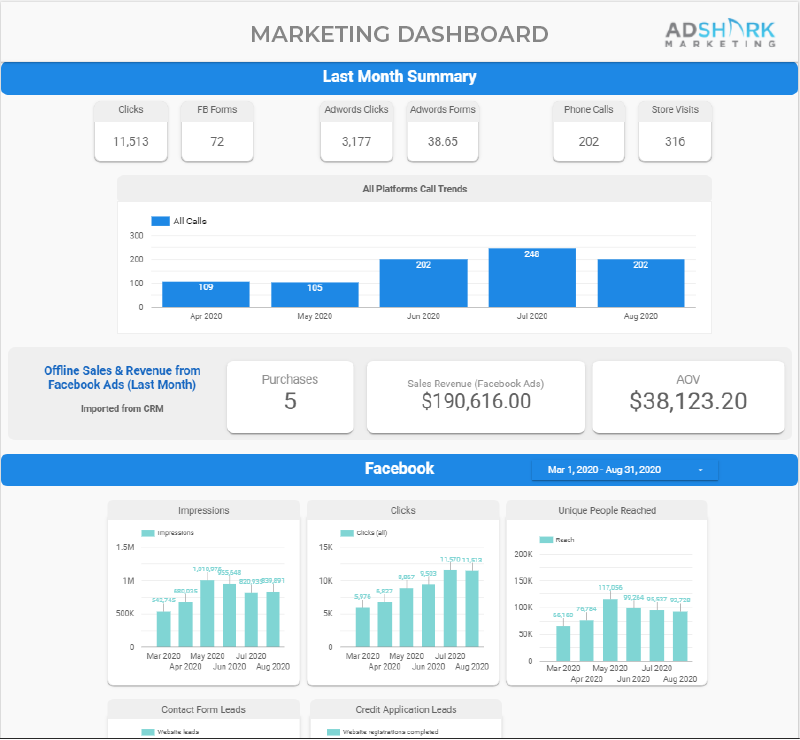
- Increased Transparency : how often have you looked at your marketing expenditures and said “I’m not sure what this did for us.” For many traditional forms of marketing, it’s sort of a guessing game. You can send client surveys to see where they heard about you (which will be largely ignored or misrepresented), and you’ll sometimes get clients who say “hey, I saw your ad in that magazine,” but there is always a lot of guesswork when trying to determine an ROI. With digital – this problem no longer exists. Not only do advertising platforms like Google and Facebook provide you with stats showing your total spend, total leads, and cost per lead, but many digital ad agencies (like us) will provide you with personalized dashboards that host all of your advertising results which can be viewed in live-time, or talked through at weekly or monthly meetings. All of the guesswork is eradicated – you’ll know exactly how many opportunities and sales came from your digital marketing dollars.
- Better Targeting of Customers: if I had a dollar for every billboard I’ve driven by that doesn’t pertain to me, I could probably buy my own billboard. Yet, I find myself buying clothing off Facebook or Instagram ads all the time. This isn’t a coincidence; data is collected on (almost) everyone’s online activities, and advertisers are able to approach those who fit their profile. Depending on the medium, you can target a prospective client based on their search activity, the websites they visit, their job title, interests, and more. The targeting for customers can get extremely granular, which will bode well for your advertisements – making sure that they are almost exclusively seen by those who have an interest in the cars, trucks, parts, or service specials you’re selling.
- Financial Viability: of course, you can set your own budget, so I won’t claim that digital advertising is a cheaper option than a traditional marketing tactic. But I will say that you’re in the driver’s seat (car pun intended) with how much you spend, and your dollars can go a lot further in garnering impressions and leads. With almost every online advertising option, you’ll only pay for the clicks you get. So for every dollar you spend, you can rest assured that eyes have seen your specials, viewed your web pages, and considered your car dealership. At AdShark, we like to say that we can help maximize your budget and keep you from wasting your money . So even if you’re not spending less money on advertising, you’re at least spending your money more intelligently.
Which Online Mediums Should I use to Advertise my Automotive Dealership?
You’re either convinced that you need to start your digital marketing strategy, or you’re almost convinced. Good deal. Now the conversation shifts to the mediums that should be used by auto dealers to reach their prospective audience and generate more traffic. Listed below, I’ll go through a variety of our top picks for car and truck dealers to begin their online marketing efforts.
Social Media

If your dealership doesn’t have active Facebook, Twitter, LinkedIn, and Instagram accounts – I’d advise that you stop what you’re doing right now (reading this blog) and hop over to those sites and get your accounts created. But, if you’re among the over 70% of US businesses that have a social media footprint already, you should instead focus on how you can better optimize your social media efforts to increase your reach and drive more traffic. The first differentiator to make is the split between “organic” social media and “paid” social media.
Organic social media refers to the content that is posted without any advertising dollars backing this. Here, you can share the unique parts of your business including content related to who you are, what you do, and why it matters. For a dealership, we’d advise not limiting this to sales-related content (promotions & deals, only), but rather show off the team of sales reps with employee spotlight posts, talk about new features in the 2021 models, and post visual content that will help humanize your brand and inspire an audience to stay engaged.
Paid social media is where some expert help can be beneficial. With all the ins and outs of Facebook advertising (and Instagram, Twitter, LinkedIn, Pinterest, and more), it can be a lot for your administrative team to try to launch a successful advertising campaign. A team like AdShark Marketin would be able to help you create relevant and engaging ads that would drive leads while staying within the stringent parameters related to advertising on these mediums. Also, digital agencies can help with the most challenging part: targeting the correct audience.

The second spot we would advise for you to devote your online energies would be Google. It’s the most powerful and widely-used search engine, with over 3.8 million searches happening per minute across the globe. Keyword Planner (a tool from Google) suggests that over 550,000 monthly are searching “honda civic” and 246,000 are searching “toyota corolla” alone. Imagine how much of that audience you could capture as a dealer! First things first, let’s take a look at the different facets of Google that may be worth your time.
PPC advertising on Google refers to any of the campaigns you can launch through Google AdWords. The term PPC stands for “pay per click” and can be used to describe bidding on Google keywords, launching remarketing campaigns, running display ads, endeavoring in Google Shopping ads, or working through a variety of other activities in which you get charged any time someone clicks your ad and is directed to your site. It’s a great way to reach a new audience and drive more web traffic, as well as get conversions on contact/lead forms.
SEO, on the other hand, is usually used to describe how you can optimize your website to show up for organic results. The goal is to have you show up on one of the first pages of Google’s search results when somebody searches a term like “car dealership near me.” Through a variety of onsite SEO practices (like updating title tags, H1s, text content, and technical SEO), teams like ours are able to help optimize your website to show up higher in search rankings. That way, the more people who are searching for a specific product or service that you sell, the better the chance is that they’ll land on your site (instead of a competitor’s).
Google My Business is a way to show up better for local searches. I would advise that any dealership take the time to make sure that your Google My Business is live and accurate, and is filled with as much content as possible to register for searches. Having a well-designed GMB page can help you get more phone calls, website visits, and overall interest from local prospects.
Other Online Platforms
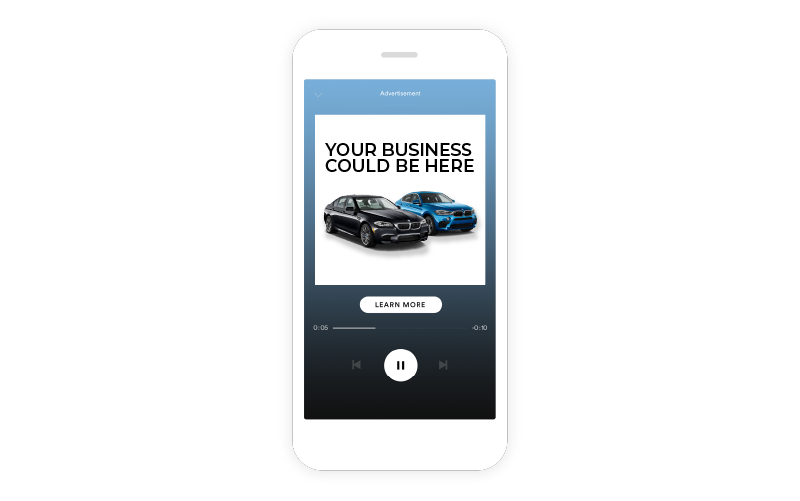
For additional advertising opportunities online, you should also become familiar with YouTube (both pre-roll and display ads) and Bing (a growing search engine that can offer some cost advantages when compared with Google). With the world turning to focus more of their energy on streaming platforms (Spotify, Hulu, etc.), there will also be more opportunities for you to leverage viewership on those platforms. Ultimately, everyday is different in the world of digital marketing. There are new technologies, new best practices, and new mediums that businesses should stay educated on. Or, you can always entrust your digital advertising to a third party , which we would be happy to communicate with you more about.
Okay, I’m ready to try digital marketing for auto dealership. Now what?
Perhaps this article has merely served to reinforce what you already know – digital works, and it can for your dealership, too. Still, I understand that there are some steps that need to be taken to transition your advertising over to digital mediums. The following steps can serve as a basic checklist that will help you get prepped for what you may need to do to embark on your digital advertising journey.
- Step 1: Determine Budget. We’d advise starting low… scale it up once you achieve success. Perhaps, you start at around $3,000 per month that you’re willing to put in the digital arena. From there, you can break it down further and determine what amount you’d like to allocate to Google, what amount you’d like to allocate to Facebook, and where else you can put a few dollars. As you receive more return on your investment (in the form of additional qualified leads, and/or better web and phone traffic), you can then pitch the case for an increase of budget. The more you spend, the more you stand to gain.
- Step 2: Identify the Right Personnel. Do you have the staff to take this on internally, or do you need a third party source? If you need third party help, look for an agency that specializes in digital advertising – not a general marketing group that offers digital on the side. You will want data-driven, results-oriented groups that can offer you transparency, and that has the case studies and client experience to help you along the way.
- Step 3: Choose Your Channels . You may need some help from the experts to determine what makes the most sense for you. If you determine that you’ll be doing Facebook advertising, it may require you to set up an Ads Account or Business Manager. Other social media platforms have their own requirements in getting going, too. You’ll also want to create audiences (or work with your third party to do so) that can highlight the prospects you’re wishing to target. Diversifying your spend into a few different online mediums can be an effective first measure to get rolling, as it will allow you to see which is the most financially viable for your business. Within platforms, you can also run a/b tests to see which headlines, copy, target markets, or other factors garner the best results.
- Step 4: Determine Which Metrics Matter. Do you only care about impressions? Is website traffic or phone calls the most important for you? Would you prefer to capture leads through contact forms that you can pass along to your sales staff? For lead generation campaigns, which are the most common amongst auto dealerships, we advise that you pay close attention to your Cost Per Conversion (which describes the amount of dollars it takes to get a lead) as a good starting point. The lower cost per conversion, the better; but only if the leads that are coming in are good, qualified leads. So, what do you care to learn about? Have that conversation in the early days so you can do a good job of tracking (or having your third party do the tracking).
- Step 5: Optimize. The biggest difference between a successful and a mediocre online campaign is how often you are optimizing your campaign. Make sure that you make the necessary adjustments (including adding of “negative keywords” for phrases you don’t want to show up in the search results) to your campaign in order to maximize your dollars spent and get a higher quality of lead. This may see you revising your target audience, copy, terms you’re bidding on, and more. (Note: this can be the most challenging part for a beginner with digital advertising. Feel free to drop us a line if you need to know more about our optimization process).

Before I leave you, I wanted to share a little story about myself. When I was 22, I was driving along Main Avenue in Fargo when my front right tire completely fell off. Turns out it was an issue with an upper control arm and a ball joint, and it was going to cost me more to replace than the car was even worth. I was completely new to car shopping, and just needed to find a dealership that was convenient and could get me what I needed in short order. I searched “car dealership Fargo” on Google, and chose the first dealership result I could find. I visited the shop, started a lease that day, and now am on my third car from this same dealership. Online advertising for dealerships in the automotive industry can work; I’m the living proof.
We’d love to have a chance to talk with you more about what our digital agency can do to increase your leads and generate more revenue for your dealership. Feel free to fill out a contact form , or reach out to me directly ( [email protected] ) to talk in greater detail about the work we can do. Thank you for reading!
Ready To Grow?
Let's Talk!

- Mastermind Platform Overview
- Mastermind Platform Integrations
- Dedicated Consultative Support
- Dealer Case Studies
- Loyalty & Retention Solutions
- Maximize the Service Drive
- Conquest New Customers from Competitors
- Adapting to Inventory Challenges
- Mastermind Blog
- Increase Loyalty & Retention
- Conquesting Competitors
- Working the Service Drive
- Acquire More Used Cars
- Marketing Best Practices
- Professional Development Tips
- Optimize Your Digital Retailing
- Future Trends & Data Analytics
- Mastermind at a Glance
- Leadership Team
Need Support?
Call us at +1 800-801-0018 or fill out form below
This site is protected by reCAPTCHA and the Google Privacy Policy and Terms of Service apply.

Information that supports what we can do for you
- Webinars & Podcasts
- Ebooks & Whitepapers
- Infographics
- Case Studies
- All Resources
View all Case Studies
Case studies toyota dealer achieves market leading retention rates, case studies toyota dealer’s data driven path to success, case studies toyota dealer builds a data driven conquest program, case studies toyota dealer revs up their service-to-sales process, case studies driving dealership loyalty with personalized intelligence, case studies improving auto dealership customer loyalty, case studies using predictive analytics to identify qualified leads, case studies improving dealership sales team engagement & close rate, case studies increasing dealership efficiency with customer intelligence technology, case studies leveraging data to increase car sales, case studies increasing car sales with predictive marketing, case studies how gillman honda became the #1 dealership using predictive analytics, case studies boosting car sales, satisfaction, loyalty & referrals, case studies leveraging mastermind to increase car sales by 62%.
Sign up to receive our industry trends and insights newsletter.
Introducing Spin 360! First 500 signups will get 25% off ||
Benefits, Strategies & Tips for Successful Car Dealership Marketing
No image to upload ? Pick one
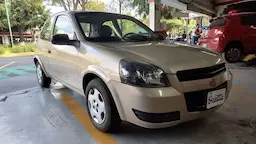
Table of Contents
Customer purchasing trends have changed; they are adjusting where and how they spend. Unless you change car dealership marketing, your brand will suffer. Hence, building a brand is important for dealerships wanting to sell. Car dealerships must have a brand to remain relevant to their customers. Car dealership digital marketing and having a presence across channels are important. This will help create visibility and retain potential customers because many people now spend time online researching before purchasing. Car dealers in the US spent $8.19 billion in 2021 on car dealership advertising. However, attracting the right customers is tough with increased competition for automotive marketers. Creating an automotive dealership marketing strategy will provide you with tremendous benefits.
What is Car Dealership Marketing?
Car Dealership marketing refers to strategies that are intended to grab the customer’s attention and promote products or services. It thus becomes important to creatively develop campaigns that connect buyers to what they are looking for at every step. Car dealership online marketing helps you connect to these customers and engage them with your brand. As a result, you ensure the customer gets what they want while also making a sale.
Digital marketing for car dealerships will help you reach a wider audience and improve sales. Shoppers nowadays don’t go from dealership to dealership to check out cars to purchase. They do their own research online and don’t rely solely on the information provided by the auto dealership salesperson.

Top 20 Marketing Tips and Strategies for Automotive Dealerships?
The number of car dealerships is continuously growing which leads an intense competition. To stay ahead of the competition and stand out among them. They can follow some car dealership marketing strategies to engage customers, enhance their online presence, and increase their sales. We have mentioned the top tips, strategies, and car dealership marketing examples below:
SEO optimization directs potential consumers to used car dealers’ websites. Most consumers research search engines, before making an actual purchase. Therefore, SEO turns out to be the most powerful strategy for dealerships to market themselves. Investing in SEO helps dealerships rank themselves on search engines, so consumers can find them easily on online platforms.
Email Marketing
Email marketing is a great platform to educate your consumers. Dealerships can also connect with their clients who purchased a vehicle or had their vehicle serviced from them. They can collect user’s email addresses from their websites by adding a form page. They also need to make sure to target interested groups of clients for the specific email. Additionally, dealerships can send emails to attract new buyers with their attractive offers and advertisements.

Customer reviews
To boost your sales, social proof of satisfied customers can result in the strongest in- car marketing tool. Dealerships can publish testimonials and reviews of their happy clients on the websites, and social media platforms to attract new customers. Customer reviews also help buyers to build trust in your dealership. Additionally, posting positive reviews can help dealerships to build their reputation in this competitive market.
Building partnership
Dealerships can build partnerships with a financing company. It will help them to promote their business and attract new customers. Additionally, it will help buyers to find a financing solution. It will help dealerships to create long-term relationships with their clients.
Host events
Hosting events is a valuable way to engage with your existing and new customers. Special promotions can help dealers to increase their sales and generate new leads. Organizing events like marketing for dealership anniversaries and delivering some attractive offers can help dealers earn maximum profit and marketize themselves.
Attend local events
Dealers can attend local events to boost their presence. They can also sponsor local events like sports teams, and trade fairs to increase their brand awareness. Therefore, it leads to attracting a wider audience and makes you stand out from your competitors in the market.
Referral bonus
Dealerships can offer some incentives or referral bonuses to their past clients. Past clients who refer your dealership to their friends, family, or their knows. Dealerships can reward them with exciting gift cards, discounts on their next purchase, services, and maintenance.
- Video Marketing
Dealerships can create informative video content to post them on their platforms like social media, and YouTube. Most buyers prefer to view videos like test drives, and overviews of the vehicles. Dealers can create knowledgeable videos on trending topics, to divert traffic to their websites.
Bid on competitor keywords
Dealerships can search trending keywords and can create a flawless car dealership campaign to attract a wider audience. Buyers prefer starting the car purchasing journey online. Dealerships that optimize trending keywords are more likely to engage with users who are looking for the best dealerships locally.
Dealerships can write informational blogs related to their automotive. Blogs will help dealerships to provide detailed information about their business to their potential customers and blog readers. Dealerships can include comparison, pros and cons details in their blog because users often search for their general knowledge. Therefore, it can lead to a future client.
Build a website
Car buyers start their purchasing journey online. Therefore, to spread awareness, dealerships need to create a flawless website for themselves. They can include high-quality images with a virtual car showroom to make their website look more appealing and professional. Building a website helps buyers find your dealership online, and it becomes a point of contact for the car buyers.
Know your buyers
Understanding the preferences and requirements of your targeted customers can help dealerships boost their revenue. There are plenty of car models available in the market. However, knowing your customer’s choices will only help dealerships to make a sale.
Dealerships can offer some freebies or giveaways to their customers. This will help to create long-term relationships with your customers. Dealerships can offer giveaways or freebies like car museum tickets, free car washes, or music concert tickets.
Invest in paid ads
Dealerships can create powerful and attractive paid ad campaigns to attract local car buyers. Running ads will help individuals who are looking to upgrade their car or looking for a trade-in to find your dealership. Paid ads also help to generate more leads and create awareness of your business.
Social media marketing
Social media platforms like Instagram, Facebook, Twitter, and TikTok will help dealerships connect with their targeted customers. Car dealership social media marketing is an effective tool to build brand awareness and a will efficient source to generate qualified sales leads. Additionally, dealerships can run advertisements and share engaging content to attract a wider audience.
Exceptional customer service
Personalize your dealing efforts according to the customers, as only some customers are looking for the exact vehicle. Some people prefer luxury vehicles; others may be interested in features; others may be concerned with price, mileage, or safety. Understand your customers through their buyer personas, and include them in the car dealership marketing agency plan through personalized marketing such as emails, offers, or ads.
Offer test drives and events
Elevate the test drive experience to create a lasting impression on potential customers. By meticulously crafting an experience, a car dealership marketing case study showcases the unique features and benefits of your products or services, you’re not only instilling confidence but also igniting a desire to own what you have to offer.
Implement chatbots and AI technology
Staying updated on technology and tool advancements helps dealerships deliver strong marketing strategies. Dealerships can introduce chatbots on their website for user assistance. Chatbots help dealerships to provide excellent customer service 24/7. Additionally, chatbots can help dealerships to streamline the process, and automate repetitive tasks.
- Answer fast when people contact you
Swift responsiveness to inquiries and leads conveys your commitment to excellent customer service. Timely replies demonstrate respect for your customers’ time and reflect your dedication to addressing their needs promptly, enhancing their overall experience and trust in your brand.
Benefits of Car Dealership Marketing
Discovering what your customers want is a sure way to success. When you invest in a marketing campaign by learning what the customer wants, you can decrease your work and prevent overspending. Here are some benefits of good auto dealership marketing:

The power of social media
Many people use social media and are active on at least one platform, such as YouTube, Facebook, or Instagram. Your presence on these platforms ensures a bigger audience seeing your car listings. Marketing on social media also allows you to specify location and target demographics, thereby increasing brand awareness, sales, customer attention, and engagement.
Before that, researching your competitors will also provide you with the right insights to optimize your strategies. Also, develop content according to search engine pages so that when a customer enters a search query for cars, they land on your website. You can also link your website to your social media accounts so that people who spend the most time there can easily find you. Customers will be able to navigate directly to your website with a click.
Cost-Effectiveness
Marketing your car dealership on social media is less costly because what can be marketed on Instagram can be marketed on Facebook too.

It also reaches a wider audience and targets specific customers across locations, unlike radio and television. Hence, creating dealership marketing strategies that work can prevent overspending on a marketing budget.
Access to Customer Insights
Online marketing a car dealership allows businesses to track their performance, see how customers interact with them, and whether they reach their target customers. It is vital for your business that you improve the customer’s experience by knowing what type of cars they want. Moreover, the insights will help you discover new markets, grow your business, and customize your marketing campaigns accordingly.
Targeted Marketing
Embarking on a marketing campaign provides you with a powerful means to precisely target the customers aligned with your offerings. Through optimization and customization tailored to individual preferences, your efforts become not just relevant but remarkably impactful. This approach, in turn, yields improved returns on your investments and cultivates a strong foundation of customer loyalty.
Increases efficiency
Some tasks are repetitive, such as reaching out to customers and emailing them, and a simple tool can automate all of this. Equipped with advanced capabilities, this marketing tool possesses the ability to not only schedule posts but also seamlessly engage customers through the integration of a chatbot. Additionally, it facilitates the delivery of personalized services to customers, thereby enhancing operational efficiency and streamlining interactions for a more effective and satisfying customer experience.
Importance of Dealership Marketing
In the overall success of your dealership business, marketing plays a crucial role. To attract potential customers, dealerships can advertise and promote their products and services. To drive more sales, and build credibility and trust with your customers, dealerships can run effective marketing strategies, which will also help to stay ahead of their competitors. Dealership marketing requires a deep understanding of the target audience. Therefore, they need a car dealership marketing plan and have to implement marketing strategies carefully. To attract a wider audience, dealerships need to identify the unique selling points of their dealerships. Dealerships can identify their USPs and highlight them with a creative marketing strategy for their targeted audience.
The dealerships need to choose wisely, what marketing strategy first for their dealership and targeted audience to drive more sales.
Tips for a Successful Car Dealership Marketing Campaign
Many people will research online before purchasing a car, which is a challenge as competitors are fighting for their attention. To reach the target audience effectively and drive up sales, dealerships must focus on their marketing efforts. Here are a few car dealership marketing ideas for a successful dealership marketing campaign.
Recognize Your Target Audience
This is so important that it sits at the top of our list. Customers will have different interests, and their preferences and needs will vary. Dealerships need to consider this and optimize their channels accordingly.

Have a great website
In addition to knowing about the target audience, it is great to create a website. Your website is responsible for conversions. This is because it will be the first thing your customers see. Having a seamless and personalized experience while they are looking for products that benefit your business is important. So, if you don’t maintain a digital presence, your offline presence won’t matter either, and you will have missed a huge opportunity.
Ensure that the site loads fast and has quality images. Customers should be able to get all the information about the car, such as make, model, fuel efficiency, price, and other features, from the website. Also, ensure your website is mobile-friendly, as many people now shop and research on their smartphones.
Update Your Online Presence
It is equally important to keep updating your website. If your website gets too old, it will disappoint the customer. Ensure that your online presence is professional and relevant to your business. You also should track your performance to see how your car sales marketing strategies are working to ensure that you are putting your efforts in the right place.
Have good online reviews
Customers will naturally skip a dealership with low ratings and reviews. It is necessary to go beyond the three-star mark; however, do not fake reviews or ratings. This will also automatically be considered negative by the search engine.
Active engagement with customers is pivotal. When they share a glowing five-star review, expressing genuine gratitude is essential. Similarly, when encountering a negative review, promptly responding and proactively addressing the concerns showcases your commitment to resolving issues. This responsive approach ensures customers feel valued, trusted, and heard, fundamentally shaping your business’s trajectory in the realm of automotive dealer marketing.
KPIs to Measure Dealership Marketing Success
Key Performance Indicators (KPIs) play a pivotal role in gauging the effectiveness of your dealership marketing efforts. Here are crucial KPIs to assess your marketing car dealership success:
1) Website Traffic
In the realm of car dealer marketing, your website remains an indispensable marketing tool. By meticulously monitoring the traffic it attracts, you can gain valuable insights into both your online visibility and the efficacy of your strategies.
2) Lead Conversion Rate
While generating leads is essential, measuring how many of these leads actually convert into customers provides a clear picture of your marketing campaigns’ impact on driving sales.
3) Cost per Lead
Calculating the cost per lead is essential in evaluating the efficiency of your marketing budget. Furthermore, it indicates how much you’re spending to generate each potential customer.
4) Customer Satisfaction
Satisfied customers, undoubtedly, are more inclined to evolve into repeat buyers and enthusiastic brand advocates. By conscientiously monitoring customer satisfaction levels, you gain a tangible indication of how effectively your dealership’s comprehensive marketing and dedicated customer service align with and meet customer expectations. This insightful analysis not only informs your strategies but also solidifies your position in the competitive landscape, ultimately contributing to sustained growth and success.
5) Marketing ROI (Return on Investment)
To gain valuable insights into your marketing strategy, firstly, determining the return on investment from your marketing efforts is crucial. Subsequently, this analysis helps you understand whether the resources invested are translating into tangible results in terms of sales and revenue.
6) Tracking Sales and Revenue Metrics
Ultimately, tracking actual sales and revenue is a definitive measure of your marketing success. Furthermore, monitoring sales trends and revenue generated directly from your marketing campaigns provides a concrete assessment of their impact.
7) Monitoring Customer Satisfaction and Retention
Monitoring customer satisfaction and retention rates provides a valuable window into the enduring success of your marketing endeavors. Moreover, contented customers are statistically more inclined to make repeat purchases, solidifying their role as loyal patrons of your brand.
8) Analyzing Website Traffic and Online Leads
Beyond just website traffic, moreover, analyzing the quality of leads generated online gives you a better understanding of the effectiveness of your online marketing strategies.
9) Measuring Advertising and Marketing Effectiveness
Assess the performance of distinct advertising and marketing channels to discern their impact. Subsequently, identify which platforms are driving the highest levels of engagement and conversions. Through this process, this crucial analysis provides valuable insights that enable you to fine-tune and optimize your marketing endeavors effectively, ensuring maximum impact and returns.
10) Evaluating Inventory Turnover and Aging
Monitoring inventory turnover rates and aging helps you manage stock levels efficiently. It ensures that your marketing efforts are in sync with inventory movement and sales trends.
By giving due attention to these essential KPIs, consequently, you can holistically evaluate the success of your dealership marketing endeavors. Additionally, this practice empowers you to make well-informed decisions and consistently fine-tune your strategies. As a result, you can drive towards the attainment of optimal and exceptional results.
Tools to Accelerate Your Marketing Efforts
In today’s fast-paced digital landscape, effective car dealership marketing materials requires more than just creativity and strategy – it demands the right tools to amplify your efforts. This collection of tools presents a comprehensive range of resources aimed at enhancing various aspects of your marketing strategy. Let’s explore these tools that have the potential to reshape your marketing approach and boost your brand’s reach and impact.
Whether you’re seeking to revolutionize visual content creation, optimize email campaigns, or analyze web performance, this guide will delve into both free and paid options that can significantly elevate your marketing game.
How Spyne Can Help with Car Dealership Marketing?
Research states that 90% of people consider images extremely important in the car buying process. However, only 89% of used-car dealers use high-quality, studio-grade photos on their websites. This means car images that look bad impact the customer experience, take longer to sell, and stay on the lot longer, leading to higher costs. This affects your business growth.
Spyne helps you showcase your cars with studio-grade photos without needing a studio or photographer. You can choose from more than 100 showroom backgrounds and customize the image according to your preference.
Spyne also allows you to showcase cars from all angles and create 360° spin car videos for an immersive customer experience. It also masks the number plate, tints the windows, and removes the reflection. You can also enhance interior images.
In this rapidly evolving landscape, those who masterfully blend tradition with cutting-edge innovation will seamlessly navigate their journey toward enduring triumph, fostering unwavering customer allegiance along the way. In the dynamic and rapidly evolving landscape, those who adeptly master the delicate balance of blending time-tested tradition with revolutionary cutting-edge innovation are poised to seamlessly navigate their transformative journey towards resounding and enduring triumph. Car dealership marketing strategic approach not only fuels unwavering customer allegiance but also paves the way for an unparalleled competitive edge, all along the remarkable trajectory of progress.
Q. What strategies do car salesmen use?
The best and most effective way to sell is to know the customer. Customers know what they want to buy because they spend most of their time researching online. So a salesperson does their best to get to know the customer and what features they want in a car and then goes from there. They also treat every customer respectfully, equally, and as valuable. Staying true and being honest with pricing and what your dealership offers is the mark of a good salesperson.
Q. What are some engaging video ideas for auto dealerships?
Video marketing is one of the best tools to engage and connect with your audience. This is because customers get to see you and your brand. You can talk about all features with just an image or a post. Some car marketing ideas on how to do that:
- Create a meet-the-team video.
- Showcase the behind-the-scenes of your brand.
- Answer FAQs
- Share a story.
- Show interviews with industry experts
- Showcase your showroom.
- Make a customer appreciation video.
Q. How to do digital marketing for cars?
Digital marketing is an inexpensive way to get customers, which results in increased sales. These car dealership digital marketing strategies work wonders for your business.
- Leverage SEO
- Use customer testimonials and put them on the website.
- Make use of Google Ads.
- Pay-per-click advertising
- Optimizing your website for mobile
Q. How do car dealerships attract customers?
Here are 8 methods you can use to grab the attention of customers.
- Make use of Facebook Marketplace.
- Send a personalized email.
- Give incentives.
- Have a strong online presence.
- Partner with local businesses.
- Hold barbeques or other free food events.
- Be honest and have patience.
- Try giving incentives for referrals.
Q. What are the marketing strategies for new car dealerships?
We have mentioned some marketing strategies that new car dealerships can implement in their business to market themselves below:
- Invest in SEO
- Personalized marketing
- Event marketing
- Share great stuff online
- Encourage customers to leave reviews
- Use ads on the internet
- Make test drives awesome to sell more
- Send helpful emails or texts
- Get noticed locally
Q. What are the marketing strategies for used car dealerships?
We have mentioned some used car dealership marketing companies strategies that dealerships can implement in their business to market themselves below:
- Know your market
- Extend your search area and location
- Be transparent about pricing
- Provide online selling
- Invest in video marketing
- Leverage social media
- Emphasize team training
- Make it user-friendly for buyers to contact you
- Focus on building customer loyalty
- Reengage past customers
Q. How to market a car dealership?
Auto dealerships can utilize tactics to market themself engage your potential customers, reach a wider audience, and increase your sales.
- Build your online presence
- Leverage (SEO) search engine optimization
- Share high-quality content
- Invest in digital ads and paid search
- Offer a smooth test drive experience
- Provide clear pricing and financing options
- Respond ASAP to leads
- Make it easy for potential customers to contact you
- Encourage your leads with a texting sequence or an email
- Tap into local marketing strategies
- Leverage SMS for marketing or sales follow-up
Q. How to increase sales at a dealership?
Dealerships can increase their sales and earn maximum revenue by following the tips we have mentioned below:
- Build strong product knowledge
- Establish a strong online presence
- Develop excellent customer service skills
- Be responsive and follow up
- Offer competitive pricing and incentives
- Create a positive showroom environment
- Utilize referrals and customer testimonials
- Personalize your interactions
- Don’t oversell
- Leverage software
Q. What is the best advertising for a car salesman?
Car salesman can focus on building trust among their potential clients. They should focus on building long-term relationships with their clients. Additionally, they can create informative videos for their social media to engage a wider audience.
Young, enthusiastic, and curious are the three words that describe Spyne’s content team perfectly. We take pride in our work - doing extensive research, engaging with industry experts, burning the midnight oil, etc. Every word we write is aimed at solving our readers’ problems.
Try For Free !
Related blogs.
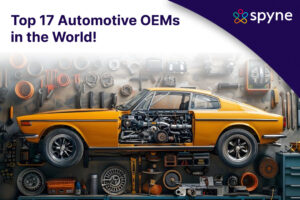
What Is Automotive OEM? OEM vs Aftermarket Parts
The global automobile industry is in a state of thrilling
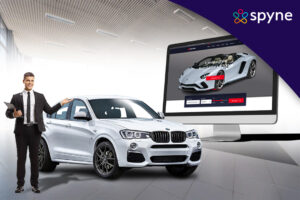
Car Salesman Advertising Strategies to Drive More Sales
Tired of hearing refusals from car buyers? No worries, in
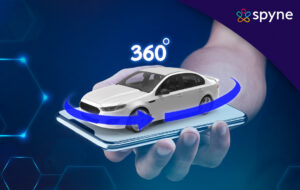
Find the Top Features of 360 Automotive Solutions
The automotive vehicle dealership landscape is undergoing a revolution with
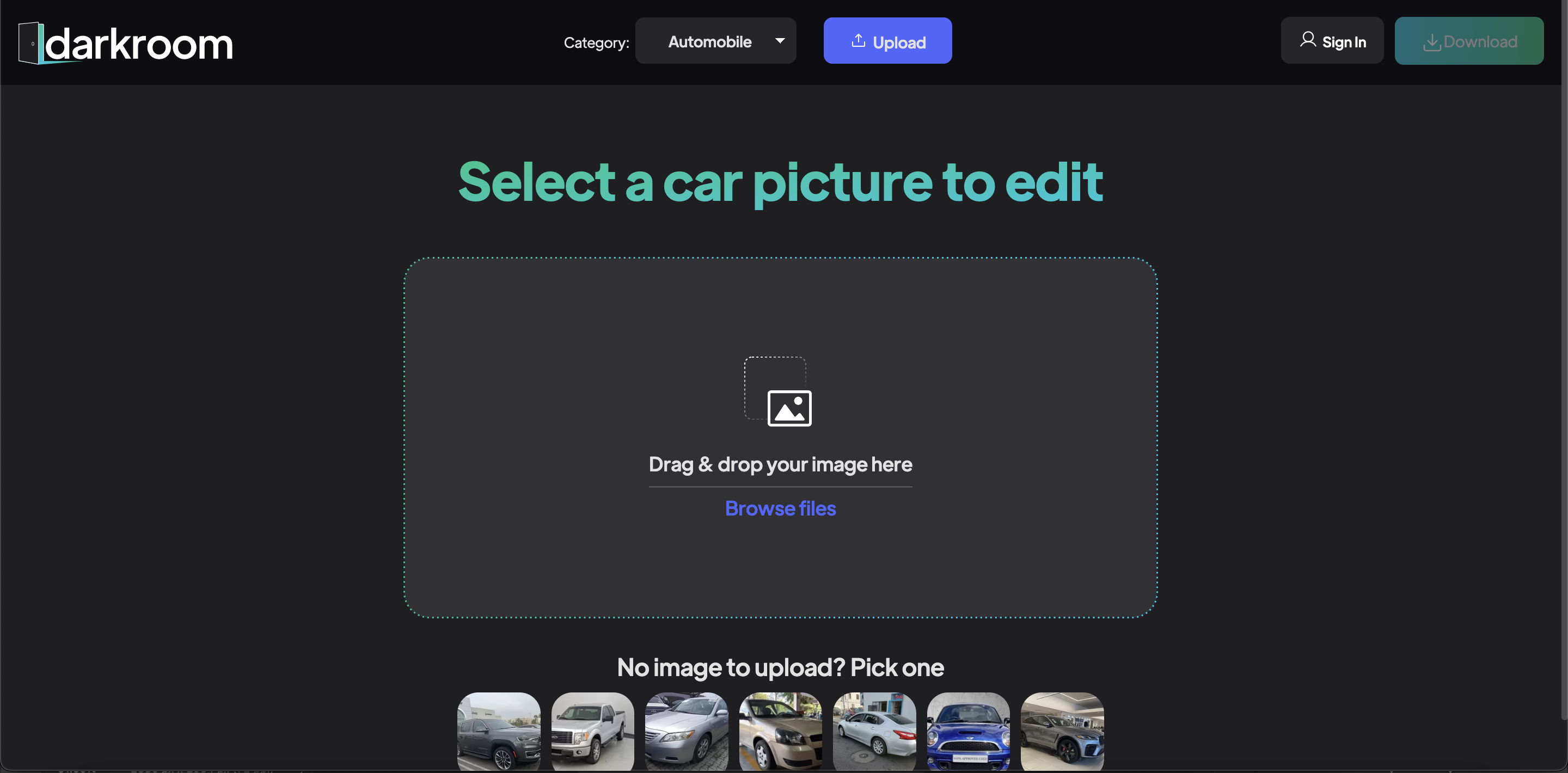
Book a demo
Create high-quality catalogs at the click of a button

Spyne is a deep tech company helping businesses create studio-finish catalogs
Virtual Studio
Dealerships
Marketplace

Bring the studio to your cars.

Start your Free Trial Now!
Just drop in your details here and we’ll get back to you!
Car BG Replacement
Car BG Removal
Car photo editing
Car Catalog Maker
Number Plate Blur
Car Merchandising
Image Enhancer
Android App
Developer Hub
Cookie Policy
Terms of service
Privacy Policy
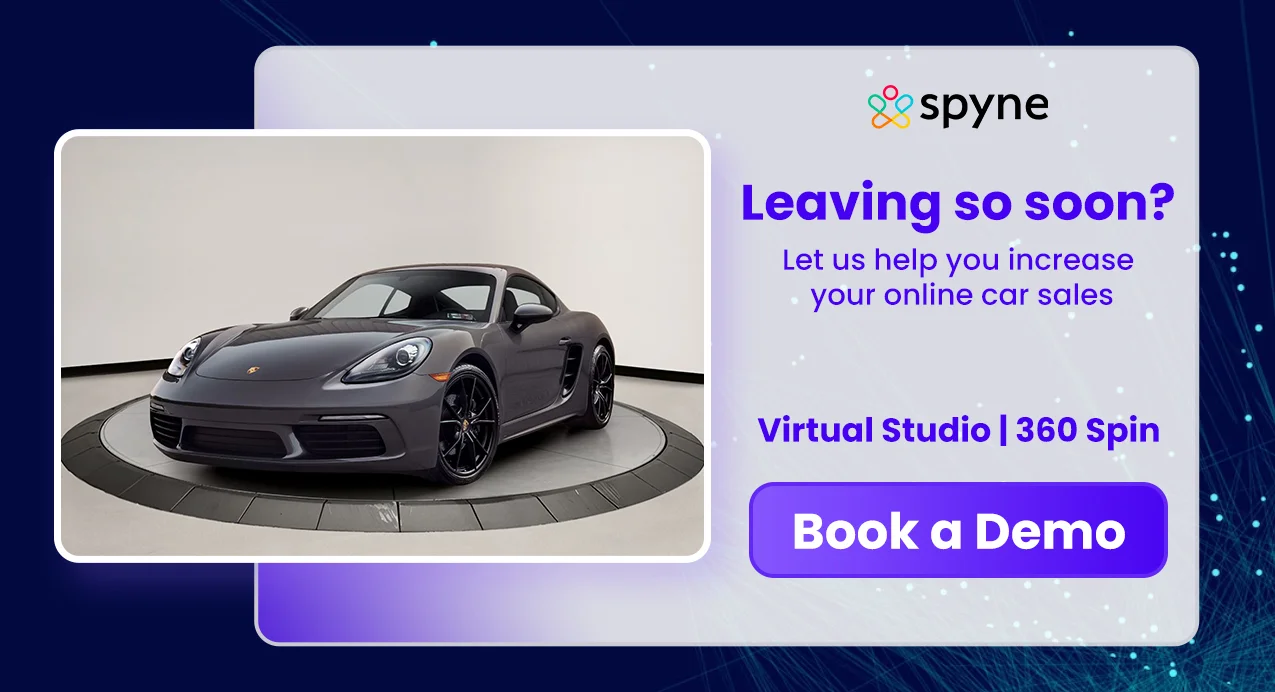
- Starter Package Signup
- Growth Package Signup
- Premium Package Signup

How Programmatic Marketing Can Drive Sales for Car Dealerships:
a case study.
As a person looking for ways to effectively market for a car dealership, you’re always looking for ways to drive sales and grow your customer base. In today’s digital age, programmatic marketing has emerged as an incredibly effective tool for reaching potential customers and increasing revenue. In this case study, we’ll explore the benefits of programmatic marketing and share key audience targeting strategies that can help car dealership general managers maximize their sales, and finally look at some common statistics comparing traditional marketing versus programmatic marketing.
Benefits of Programmatic Marketing for Car Dealerships:
Precise Targeting: Programmatic marketing enables you to reach specific audience segments based on demographics, online behavior, and other factors. This ensures that your ads are seen by the right people who are more likely to be interested in your offerings.
Cost Efficiency: Programmatic advertising allows you to set a budget and bid on ad placements in real-time, ensuring that you’re only paying for ads that reach your target audience. This can lead to better ROI compared to traditional marketing methods.
Real-Time Analytics: With programmatic marketing, you can track the performance of your campaigns in real-time, making it easier to optimize your targeting strategies and improve your results.
Improved Customer Experience: By delivering relevant ads to your target audience, you can create a more personalized experience for potential customers, increasing the likelihood of them engaging with your dealership.
Key Audience Targeting Strategies for Car Dealerships :
In-Market Car Shoppers: Focus on individuals actively searching for new or used cars online, visiting comparison websites, or engaging with other local dealerships.
Geographic Targeting: Prioritize potential customers within driving distance of your dealership, ensuring your ads reach the right local audience.
Demographics: Tailor your campaigns to attract specific demographic segments based on your inventory and typical customer base.
Behavioral Targeting: Analyze online behavior to identify potential customers who are likely to be interested in purchasing a car.
Vehicle Ownership: Target individuals with older vehicles or expiring leases, increasing the likelihood that they’re ready to purchase a new car soon.
Life Events: Target individuals experiencing life events that often lead to car purchases, such as recent college graduates, newlyweds, or new parents.
Competitor Conquesting: Reach potential customers who have shown interest in or visited competing dealerships, attracting buyers who are already considering a used car purchase.
Retargeting: Re-engage users who have previously visited your website or engaged with your online ads, encouraging them to revisit your dealership.
Programmatic marketing presents a powerful opportunity for car dealerships to reach their target audience and drive sales more effectively. By leveraging the precise targeting capabilities of programmatic advertising, you can ensure that your marketing budget is spent on reaching potential customers who are most likely to be interested in your offerings. Embrace these key audience targeting strategies to optimize your campaigns and maximize your dealership’s sales potential.
If you’re ready to take your dealership’s marketing efforts to the next level, consider partnering with Game Changer Media Group that specializes in the automotive industry. With our expertise, you can develop and execute data-driven campaigns that will deliver real results for your business.
How are the results ??
Car dealerships that use programmatic marketing can experience various improvements in their advertising efforts. While specific results may vary depending on factors such as targeting strategies, ad creatives, and market conditions, some common statistics for car dealerships leveraging programmatic marketing include:
Increased conversion rates: Programmatic marketing can lead to higher conversion rates due to the precise targeting and personalization capabilities. Dealerships can experience a 20-40% increase in conversion rates by using programmatic advertising compared to traditional marketing methods.
Better ROI: Dealerships utilizing programmatic marketing often see a better return on investment (ROI) due to the improved cost efficiency and targeting capabilities. It’s not uncommon for dealerships to see an ROI improvement of 30-50% compared to traditional advertising methods.
Lower cost per acquisition (CPA): By targeting the right audience and optimizing ad placements, programmatic marketing can help dealerships lower their cost per acquisition. CPA reductions of 10-30% are common when compared to traditional marketing methods.
Higher click-through rates (CTR): Programmatic ads are more likely to resonate with their target audience due to their personalization and relevance. This often leads to higher click-through rates, with CTRs increasing by 20-40% compared to traditional advertising methods.
Greater brand visibility and awareness: Car dealerships using programmatic marketing can experience increased brand visibility and awareness. This can result in an uptick in website traffic, foot traffic to the dealership, and overall engagement with the brand.
Improved customer retention and loyalty: With the ability to retarget and engage with previous customers, programmatic marketing can help improve customer retention and loyalty rates. Dealerships using retargeting strategies may see a 10-20% increase in repeat business.
Enhanced ad performance tracking: Programmatic marketing provides real-time analytics, which allows dealerships to track their ad performance more accurately. This enables them to make data-driven decisions and optimize their campaigns for even better results.
It’s important to note that these statistics are general trends and may vary based on factors such as the dealership’s market, budget, targeting strategies, and ad creatives. To achieve the best possible results, dealerships should continuously test, optimize, and refine their programmatic marketing campaigns.
Ready to supercharge your dealership’s marketing efforts with programmatic advertising? Get in touch with our team of automotive marketing experts today for a free consultation and discover how we can help drive more sales and grow your customer base. Don’t miss out on the opportunity to transform your dealership’s marketing strategy – contact us now!
904-415-6600
15 car dealership marketing and sales strategies to drive revenue

Today’s consumers are taking a more active role in the car-buying process. They are researching online, asking for recommendations, and conducting multiple test drives before converting. As a result, strong car dealership marketing and sales strategies have become more vital than ever.
Benefits of auto dealership marketing and sales
An effective automotive marketing strategy will help your dealership attract more customers and boost revenue. Below we break down some of the major benefits of investing in a solid marketing and sales strategy.
- Generate more leads and customers
- Boost overall revenue
- Build brand awareness
- Reach a wider target audience
- Stand out from the competition
- Improve customer engagement
- Establish trust with your customers
15 car dealership marketing and sales strategies to help sell more vehicles
1. build your online presence .
Cars are expensive, which makes the buying process a bit longer and more complex. However, the reality is that most buyer journeys start online. In fact, 95 percent of automotive shoppers go online to find dealerships and answers to their questions. As a result, the best place to start is by building an online presence.
This includes building a credible, easy-to-use, and visible website. However, you should also make business profiles on social platforms, directories, and review sites.
Creating this rock-solid online presence will ensure that customers looking to buy cars are aware of your dealership and the offerings you have.
Here’s a list of places you should consider having a presence:
- Google Business
- DealerRater
2. Leverage search engine optimization
Twice as many car buyers start their research online than at a dealership. As a result, it’s important to invest in a strategy to boost the visibility of your auto dealership on search engines.
SEO is a popular digital marketing strategy used by big and small businesses to do just that. Deploying SEO best practices will drive traffic to your website and improve the likelihood that your website will show up on the first page of Google, Bing, Yahoo, and more.
Being on the first page of the Google SERP greatly increases your potential to reach more prospective buyers. In fact, research shows the first five organic results on Google account for 67.6 percent of all clicks.
Here are a handful of SEO best practices to keep in mind:
- Write quality content that targets relevant keywords that buyers search
- Write unique content that stands out; don’t rehash the same content over and over
- Optimize your content title and title tag by including your keyword
- Improve your website’s loading speed
- Provide captions for all images and describe those images using alternative text
Overall, to rank higher you need a solid content planning strategy, strong content, and a user-friendly website.
3. Share high-quality content
Content goes hand-in-hand with SEO and is a great automotive digital marketing strategy. Post informative, well-written, and well-researched content to your dealership’s website. Answer common customer questions, build comparison shopping guides, or write content that your customers search for. This will help you become a trustworthy source of car information.
For example, you could create a listicle on the most reliable cars on the market today, an article on ways to improve the longevity of a vehicle, or compare and contrast several SUVs you have on the lot.
Regularly publishing high-quality online content will help you establish trust with prospective buyers, boost traffic to your website, and encourage more buyers to visit your dealership.
4. Encourage customers to leave reviews
The reality is that reviews influence customer behavior. Research suggests that car shoppers are five times more likely to visit your dealership if it has positive customer reviews. As a result, a great marketing strategy is to encourage satisfied customers to leave reviews. Getting reviews boosts your online reputation and overall brand reputation.
One of the best ways to encourage reviews is simply to ask! You can ask customers in person, over the phone, or via text after a purchase.
Here is an example of a text message you could send to your customers to encourage a review.

In addition to asking for reviews, it is a best practice to respond to reviews. This includes replying to negative reviews as well as positive reviews. This will help you build customer brand loyalty. In the following example, you’ll see the luxury car dealership Ferrari of San Francisco reply to its customers.

5. Invest in paid search and other digital advertisements
As previously mentioned, the car-buying journey often starts online. That’s why auto dealers should invest in paid search and other digital ads to get more customers.
The reality is that customers will often search for simple phrases such as “cars for sale in San Diego” or “top dealerships near me.” A local paid search advertising strategy allows you to target keywords like this to get your website or ad at the top of search engine results pages. This will ensure your dealership gets in front of people in the market for a new car.
For example, when Googling “cars for sale near me” Google Search ads appear first. You can see this in the screenshot below.

In addition to paid search, there are other paid digital mediums to consider. This includes leveraging paid social media ads. This strategy allows you to get more leads when done correctly. That’s because it delivers the right message to the right person at the right time.
A few paid advertising channels to consider:
- Google Display Network ads display ads on the high-traffic websites customers browse.
- Facebook ads target leads with banner ads or sponsored posts.
- Yelp ads allow you to appear first in directory listings or ‘best’ lists.
- Youtube ads reach customers with video advertisements.
- Instagram ads reach customers with sponsored posts or stories.
- Twitter ads allow you to reach customers in their newsfeeds.
6. Perfect the test drive experience to close more deals
The test drive is an important part of the car buying process. It can help move customers from the consideration phase to the buying phase. Plus, it allows the car to sell itself.
But, there are several considerations to keep in mind to ensure the test drive helps you close more deals. Below we break down a few of those considerations.
- Offer unaccompanied test drives. One survey found that 63 percent of consumers would prefer to take a test drive without a salesperson present. This makes them feel more comfortable and able to test the car without distractions.
- Provide an upfront cost. No one wants to play a pricing game or feel like they are being taken advantage of. That’s why it's important to provide the cost of the vehicle upfront to the potential buyer.
- Offer a discount after the test drive. Incentivize a potential customer to buy after the test drive by offering a discount. For example, you could offer a dollar-off discount for customers that buy on the same day of the test drive.
- Don’t use the test drive time as a full-on sales pitch. By the time a customer goes to a dealership, they have researched a lot about the car. In these circumstances, you’ll want to act as a trusted advisor rather than a salesperson. Don’t use the time for a full-on sales presentation to convince customers to purchase the car. Instead, ask if there are questions you can answer.
- Space out test drives. Ensure customers don’t feel rushed during the test drive process. Instead, space out test drives so they have ample time to consider the car.
7. Provide clear pricing and financing options
Cars are a big ticket purchase, meaning that cost is top of mind for customers. Plus, many customers may trade in their vehicles as well, which makes pricing nuanced in the industry.
That’s why providing clear, fair, or upfront pricing options can help your dealership stand out. In fact, a study from Cox Automotive found that the top dealership differentiators are: transparent pricing and competitive finance rates. Because pricing is so important, many dealerships have turned to an upfront, value, or one-price strategy. This means that the vehicle is sold at a price that’s non-negotiable. This pricing strategy has helped some dealerships attract customers who are weary of the traditional car buying process and negotiating.
Bob Lanham, the Head of Automotive Retail for Meta, says that this one-price strategy is especially helpful for dealerships that sell to younger generations. That’s because these generations are more likely to pay more just because the buying experience is better.
Another pricing strategy that works is to spend time analyzing and adjusting vehicle pricing to the market. This ensures the consumer always views the pricing as fair.
Plus, you’ll want to provide a quote for any trade-ins as quickly as possible so customers understand how much it will cost them.
8. Respond ASAP to leads
When it comes to buying a car, prospective customers are likely to reach out to several dealerships at once to schedule test drives, understand pricing, or gather more information.
The faster you respond to inquiries, the more likely you are to turn them into a customer.
In fact, a study by Lead Connect found that 78 percent of customers select the company that responds to their inquiry first. And Harvard Business Review found that the chance of qualifying inbound leads is 60 times higher if you reply within one hour. Business texting is one great way to reach out to prospective customers quickly. That’s because most texts are read within three minutes and get a response in 90 seconds. The average email response rate is 3.5 hours. Plus, studies show that 80 percent of Americans don’t answer the phone if it is from an unknown number.
Here’s an example of a quick text you could send a lead after they filled out an online form.

9. Put an emphasis on team training
Although most customers conduct research online first, 95 percent of purchases still occur at an auto dealership, according to Hyundai. This makes the in-person car buying experience a vital part of your sales strategy. Ensuring your team delivers this exceptional experience starts with training.
The reality is new car buyers conduct extensive research before making a decision. As a result, your sales team must know more than the customer to help close the sale. Effective training ensures that your employees are knowledgeable about the brand and cars. This includes being able to answer customer questions promptly.
10. Make it easy for potential customers to contact you
Ensure that when customers want to reach out or schedule a test drive, it’s hassle-free.
One of the best ways to make it easy on buyers is to offer them many options to reach out. This includes letting them contact you via email, phone, text message, and form fills.
In the example below, Mossy Toyota in San Diego offers customers the option to live chat, text, call, or fill out a form on the website.

11. Nurture your leads with an email or texting sequence
Although people may be looking at new cars, they likely aren’t ready to buy on the first visit to your website. A study suggests that there are actually 24 touchpoints before a customer buys a vehicle.
As a result, one best marketing and sales strategies for auto dealerships is to nurture your leads. You can use an email marketing strategy or sequence to help turn interested customers into paying ones. For example, you could create a series of emails that share helpful information with your prospects. This includes sharing blog posts, comparison articles, and more.
Additionally, if a lead consents to receive texts from your dealership, you could also use the channel to check in and see if they have any questions. You can also share links to helpful articles via text.
The key is making sure you follow up with potential customers since the car-buying process is lengthy and requires multiple touches.
12. Focus on building customer loyalty
IHS Markit, part of S&P Global, found that a third of all new vehicle registrations in 2020 were from loyal customers. This suggests that a top priority for auto dealerships should be on retaining existing customers.
You can build loyalty and retention in several ways. This includes being human in your interactions, reaching out during the most relevant moments, responding promptly no matter the channel, creating a loyalty program, and more.
To encourage loyalty, dealerships could offer customers a free oil change each time they purchase tires, offer gift cards for referrals, discounts on vehicle maintenance, or free car washes.
Overall, dealerships should focus on building relationships with past customers. This will create long-lasting customers who want to come back to purchase their next car from you or come to you for a particular service.
13. Reengage past customers
This strategy goes hand in hand with building relationships and loyalty. But another good sales strategy is to reengage past customers.
For example, a dealership could proactively reach out to past customers a few months before their lease is about to expire to tell them about new cars they have on the lot or their options for buying out the vehicle.
Reengaging past customers gives your dealership an opportunity to upsell or cross-sell to boost sales.
14. Tap into local marketing strategies
Don’t be afraid to tap into more local marketing strategies as well. This includes sending out mailers to customers in your service area or using newspaper ads. This can help you build awareness and drive customers to showrooms, car lots, service centers, or your website.
Mailers come in many forms. For example, you could send out a magnet with your contact information, a postcard promoting a recent deal, or a personalized letter.
The example below shows a personalized letter you could send to customers about trading in their vehicle for a new model. This example is from Auto Mail Mall .

You could also promote a new deal in a local newspaper to encourage customers to go to your dealership.
15. Leverage SMS for marketing or sales follow up
Business texting is a powerful tool for car dealerships. Not only does it allow for personalized marketing, but it also enables car dealers to stay in touch with potential customers and respond quickly. That’s because it allows you to reach customers on their mobile devices, where the average person spends more than four hours a day .
Using SMS to supplement your other marketing channels can help your dealership stand out from the competition. You could use it to promote future sales, send a unique offer, share your current inventory, or alert customers to a new service offering. SMS marketing campaigns perform seven times better than email marketing campaigns. Plus, the average click-through rate CTR for links in text messages is about 9 percent, which is higher than other channels like Google Adwords and Facebook which are about 1 percent.
It also is a great tool to help you speed up your sales cycle. You can use it to respond instantly to prospects after they fill out a form online and move buyers through the sales process with follow-ups that are seen. In fact, texts have a 98 percent open rate and a 45 percent response rate. This SMS open rate is four times greater than email and the SMS response rate is eight times higher than email.
The bottom line
To sell more cars, it's important for auto dealership marketers and salespeople to generate leads and create a great car-shopping experience. Consider using the strategies on this list to help your dealership get more customers and improve the overall experience.
To learn about how texting can be used to improve the car sales process, read our blog here . To learn more about how SMS can improve your automotive marketing campaigns, read our explainer here .
You can also start a 14-day free trial on Textline by clicking here . No credit card is required.
Start texting now
Earn commission for referrals, recommended reading, the fundamental salesforce sms integration guide.
Get our ultimate Salesforce SMS integration guide to learn how to text from the powerful CRM tool and why you should.
9 patient acquisition strategies for medical and dental practices
Here are nine strategies that will help you get new patients through the door of your medical or dental practice.
The sales tech stack to scale for success
Here's an overview of the sales technologies that will help your team scale for success.
App Overview
Integrations, platform solutions, plans & pricing.

Epic Productions LLC

- get a quote
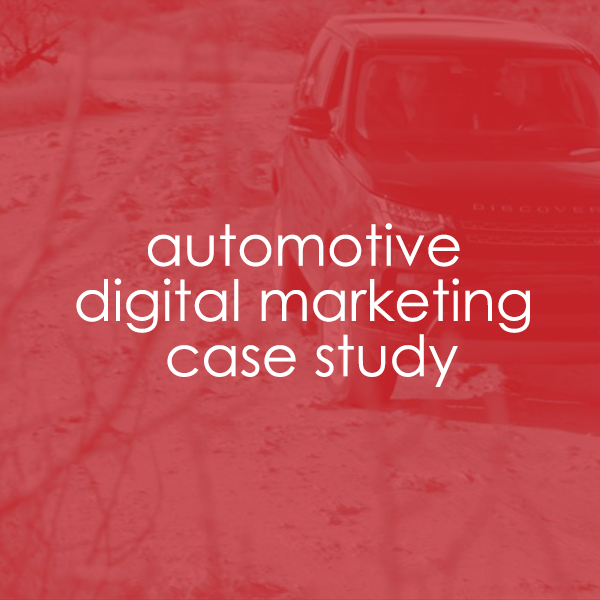
Automotive Digital Marketing: Thoroughbred Nissan Case Study
When it comes to automotive digital marketing, Epic has been around the dealership advertising track a few times. A client of ours who has passed the finish line in first place year after year is none other than Thoroughbred Nissan in Tucson, Arizona. We have been lucky enough to work with this awesome car dealership client for several years now and we are constantly researching ways to upgrade their automotive marketing strategy.
Developing an in-depth automotive digital marketing strategy to increase overall brand awareness and increase in-store visits plus website traffic takes a cohesive approach. That being said, this dealership marketing plan needed all the bells and whistles to rank above the local competition and most importantly, be the #1 Nissan car dealership in Tucson.
In this case study, we break down how we created an automotive digital marketing strategy through SEM and automotive SEO efforts . From concept to execution, learn more about how we helped Thoroughbred get a head start in their automotive marketing.

AUTOMOTIVE DIGITAL MARKETING CASE STUDY
The first step.
COMPETITIVE RESEARCH
Before developing an automotive marketing strategy, our digital team pulled some numbers and did a bit of competitive and local research. Being that we picked up where a national automotive marketing agency left off, it was essential to know what was being done in the past and the current results they were generating.
Conduct A Competitive Analysis
Our client’s competition generated 200% more organic traffic prior to our automotive digital marketing plan. Through a solid competitive analysis, we were able to understand their strengths and weaknesses.
Understand Search Volumes/Trends
After understanding the competition’s organic presence, we knew exactly what search terms and keywords to prioritize. This is not a one size fits all solution, strategy is key as some keywords are easier to rank than others.
MARKETING STRATEGY
THE GAME PLAN
Digital Marketing
After discussing the multitude of options via Google, YouTube and social media marketing, we created an online advertising strategy that was optimized to increase brand recognition, promote monthly specials, and outrank local competition. With the combination of pay-per-click search ads bidding on related search terms, display banners to captivate audiences during their online research, video ads to increase awareness, and social media marketing efforts to peak engagement, we had a solid plan that had the full package.
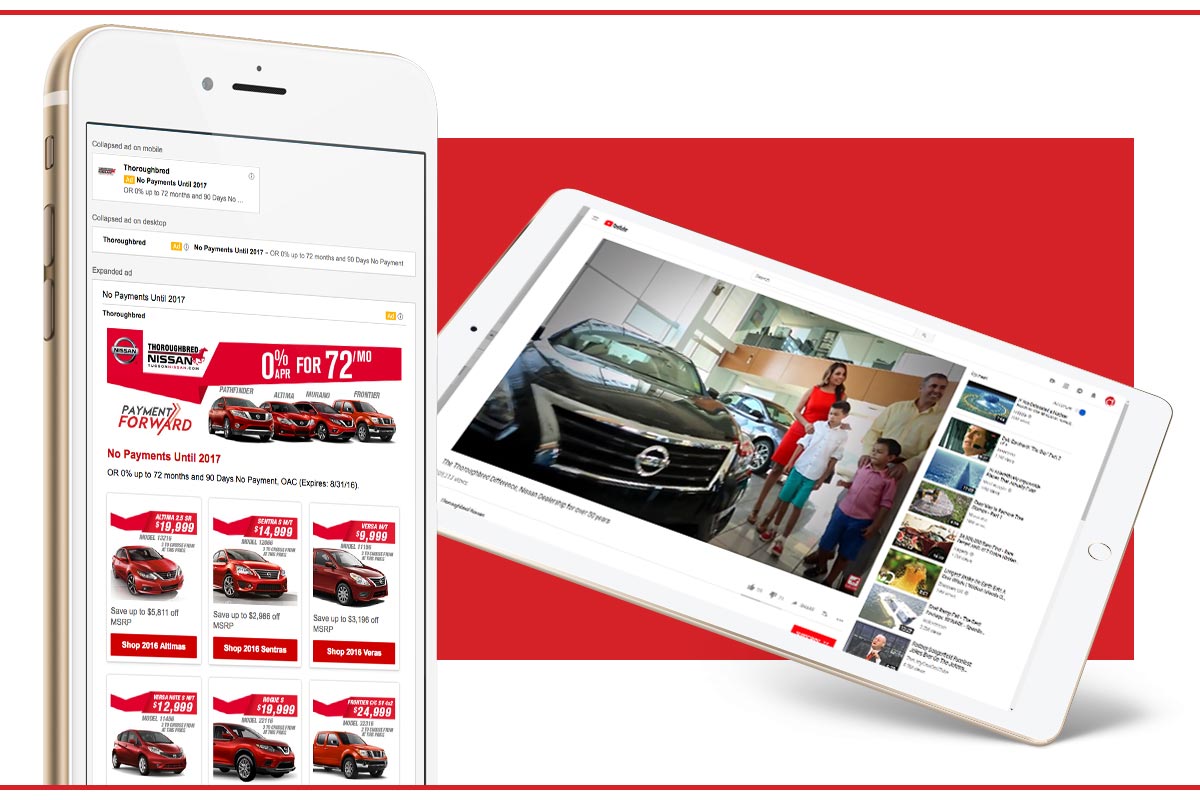
Video Production
This automotive digital marketing strategy also consisted of capturing a library of video content to use for years to come. Being the top video production company in Arizona, car dealership videos are a niche we excel in. The goal was to create several videos that can be used for their online marketing efforts and their YouTube ads, to place on various pages of their website, and to grow their YouTube channel. Take a look at this corporate video we created for Thoroughbred to showcase their family-focused vision.
Another important step in this dealership marketing strategy was to increase their organic rankings and organic traffic. There are two ways to show up in the search engine results page (SERPs), you can pay to be there or show up organically. This phase consists of finding search terms that potential car buyers are looking for online and capitalize on them by incorporating them into your website. By effectively seeking out those search terms and keywords that Thoroughbred’s customers were searching for, they are now on the first page of Google for multiple keywords including nissan tucson , nissan car dealerships , nissan used cars tucson , and many more.

2018 vs. 2019
Comparing this strategy from 2019 to 2018 and making changes and upgrades along the way, Thoroughbred has seen a 322% in website conversions. These website conversions consist of in-store visits, contact forms, pre-approval forms, and much more. Overall, by utilizing this strategic online marketing campaign, our client has reaped the benefits of tremendous results and increased return on investment (ROI). The magic in these numbers comes from the constant campaign analyzation and staying on top of the trends as well as staying on top of what the local competition is doing. Automotive digital marketing takes consistency, an unique approach, and an experienced team of digital experts to see 0 to 60 MPH results.
Are you ready to take your dealership online marketing efforts to the next level? Looking for a few auto dealership marketing ideas to see what would work best for you? We’re here to help! Reach out to us to get a full marketing strategy that will get rid of inventory and increase sales.

Car-dealership Case Study
by yourbusinessmarketer | Jan 25, 2022 | Case Studies
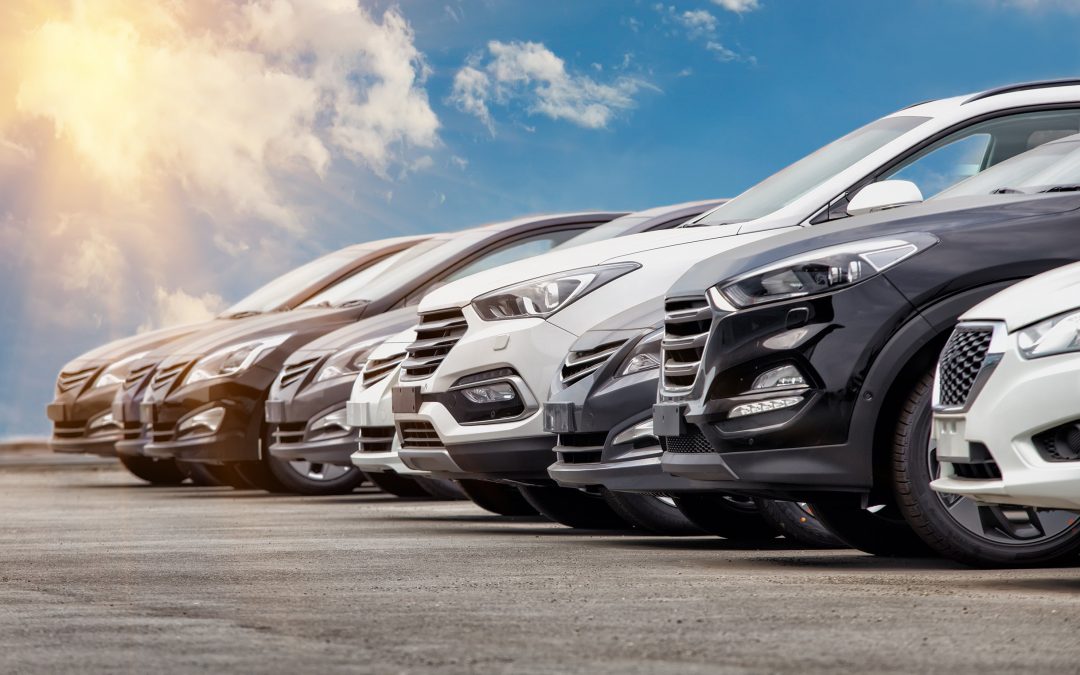
Newly Opened Pre-Owned Car Dealership Profitable within 75 Days of Launch. Focus on all-encompassing Digital Marketing Strategy
When running a car dealership, the day-to-day operations and time involved with customers and employees alike can make it extremely difficult to focus on growing the business. The cost of gaining market share in a competitive industry can be a challenge. When opening they brought in YBM from the initial stages to discuss a strategy so they could focus on the day to day operations. With a clear budget and targets required to meet sales goals throughout the next 12 months, we were able to develop a marketing plan for the long term. While the plan would be adjusted week by week or month to month with the constant communication, the overall strategy was solid and led to continuous revenue growth long term. Initially through driving general traffic and brand awareness, with long term goals of finding ideal customers and engagement.
The APPROACH
While a big challenge to start from nothing, it was also a strong position to build everything as efficiently and effectively as possible. We focused on the best channels that would bring traffic, while also implementing a long-term plan for ongoing growth through SEO. We were able to produce an all-encompassing digital strategy that focuses on a fast ROI and steady flow of customers, while also growing their presence for long-term revenue growth as well.
Our approach is always to listen first and analyze. Marketing is not a one size fits all approach. Through collaboration and listening to clients’ needs, we are able to develop the most effective strategy that ensures their goals are met.
THE CHALLENGE
Starting an unknown business in a highly competitive industry such as automotive is no easy task. Car buyers are less loyal and savvier than ever with the amount of technology at their fingertips. YBM was brought in with extensive previous knowledge working with car dealers and advanced digital marketing techniques to produce the most results for the least amount of money (something this dealership did not have a lot of to start with). Along with this, the dealership had a good size of three salespeople who needed a steady flow of customers to hit their monthly goals, as well as make a good living.
Another key analysis point was focusing on their current competition. There are 5+ major competitors in the market that are spending significantly on digital marketing (many upwards of $50k+ per month). We needed a savvy plan that could make us compete with a fraction of the budget. It all came down to the best marketing mix to obtain a strong ROI in the least amount of time.
THE SOLUTIONS
Once we had analyzed the competition and who the ideal customers were for the client, our long term marketing strategy involved the following:
> Generate leads quickly and ongoing to ensure their sales staff is busy.
> Grow a solid base of repeat and referral customers through advanced targeting and engagement techniques.
> Establish a long term organic presence through reviews and SEO growth strategies
Key Performance Metric were tracked closely to ensure optimal success, while adjusting for business demand
First 6 months results.
Unique Visitors: 13,558
Online Leads Generated: 3,300
Social Media Leads Generated Per Month: 350
Average Cost Per Social Media Lead: $7.07
Overall Traffic Growth (Year two vs Year one): Total 237k visitors: 40.5%
FIRST YEAR RESULTS
Automobile Sales: 264
Average Monthly Revenue Generated: $275K
Average ROI from marketing spend: 19X
Gross Revenue Growth Per Vehicle (Year Two vs Year One): 34%
Overall Revenue Growth (Year Two vs Year One): 28%
Recent Posts
- Chevrolet Dealership Case Study
- Home Services Case Study
- Insurance Case Study
- February 2022
- January 2022
- August 2021
- October 2019
- February 2019
- October 2018
JavaScript seems to be disabled in your browser. For the best experience on our site, be sure to turn on Javascript in your browser.
It looks like you may be using a web browser version that we dont support. Make sure you're using the most recent version of your browser, or try using one of these supported browsers, to get the full Logotech experience

Already using one of these browsers but still having issues? Contact our Support or continue anyway
We're Hiring Promotional Product Experts!
- Create an Account
Talk to a specialist
- Logotech Blog
- All Posts by Logotech
Case Study: Using Promotional Products for Car Dealerships
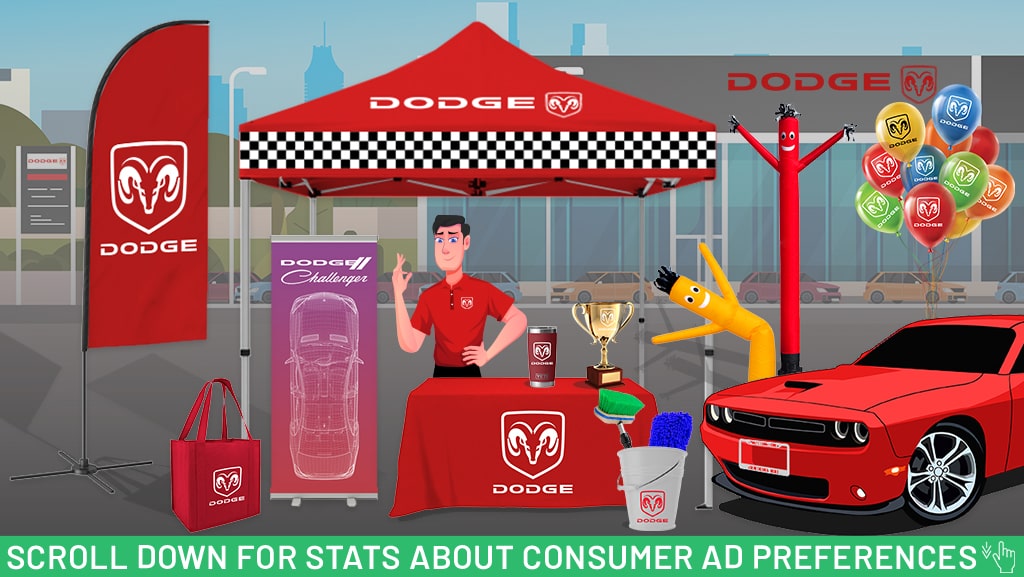
Learn How Your Dealership Can Stand Out with Custom Products!
Public recognition and visibility are essential to every brand. In crowded industries, having a well-known logo can turn a local business into an established brand! Brand recognition is especially vital when it comes to auto dealerships. Auto manufacturers like Ford and Chevy have built-in brand recognition from decades of success, but building an established brand specifically for your dealership is crucial. When car shopping, 75% of car buyers intend to purchase from the first brand on their mind. When you consider most towns and cities have multiple dealerships for the same manufacturer, the imperative is clear: brand awareness is king in the auto industry!
There are many conventional methods for car dealerships to promote their brand. Click here to read our article about the top promotional strategies for dealerships! Advertising in mediums like television, newspapers, and radio are the most popular ways for auto dealers to attract new customers. Everyone's seen some version of the classic dealership ad– a salesperson telling the community to "come on down!" for unbeatable prices with a catchy slogan. Dealerships also use online advertising, like social media and Google advertisements, to get their brands noticed. However, many dealerships forget about one method for boosting brand awareness: promotional products!
Using Promotional Products for Car Dealerships
Promotional products make a fantastic addition to the marketing campaign of any business. While custom-branded merchandise isn't the first marketing method we think of, it can be one of the most effective forms of advertising! Promotional products are the favorite form of advertising among men and women of all ages, and they significantly boost the likelihood that consumers will do business with the advertiser (see the statistics at the bottom of the article for more info). 88% of consumers who received a promotional product in the past year can recall the advertiser's name. Furthermore, 85% of consumers say they have done business with a company as a result of receiving promotional products ! When you consider the low cost of promotional products relative to other forms of advertising, it's a no-brainer.
At Logotech, we offer a massive catalog of products to get your brand noticed! We've curated a specific selection of products for car dealerships designed to get more customers on your lot. What's more, we have the results to show for it!
In this case study, we'll share the story of our relationship with one of our top dealership clients. For anonymity, we'll refer to them using an assumed name: Titan Motors. We've been working with Titan for nearly a decade, watching them grow from a fledgling dealership to a community staple. In that time, Titan used many of our custom dealership products to increase brand visibility and boost sales! We'll explore several orders they placed, reviewing the dealership's goals, the custom products we produced, and the results achieved. As you'll see, promotional products are versatile marketing tools with seemingly limitless applications! Join us as we travel through the story of our relationship with Titan Motors.
Making Contact and the First Purchase
We first made contact with Titan almost a decade ago! At the time, they were an emerging Ford dealership with a small staff and less than 100 cars on the lot. As a newer dealership, they needed ways to maximize their brand presence in the community. If there's one thing we know at Logotech, it's how to get brands noticed! Titan contacted us via phone and was put in touch with one of our expert account managers. They helped Titan find the perfect products and customization options for their dealership.
The Initial Products
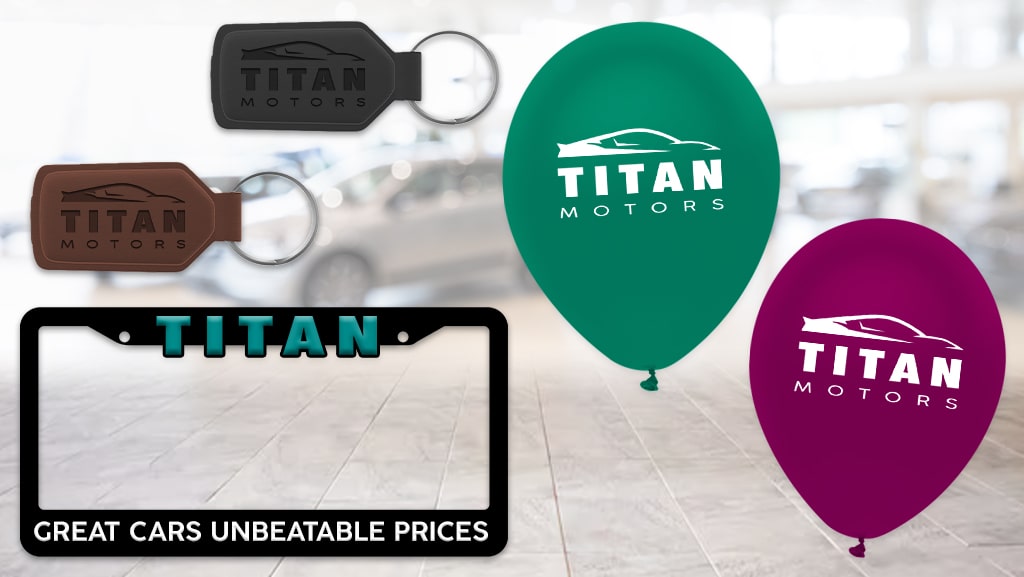
At Logotech, we firmly believe there are a few branded products that every dealership should utilize. Titan was only looking for business cards initially, but after some deliberation, we decided on a package including license plate frames, keychains, business cards, bumper stickers, and reusable branded balloons . These products create an excellent starter package for any new dealership!
For starters, custom-branded license plate frames are a must-have for a dealership. For every car you sell, you should install the customer's plates with a branded frame. This easy practice gives your brand visibility all over the roads! Titan selected our chrome-faced license plate frames with sleek black lettering for their dealership.
Next on the docket were the custom keychains , another essential for automotive brands. Keychains can be given away for car purchases, new hires, service appointments, and other events. The dealership didn't want anything flashy, so we settled on rectangular keychains made from leather, expertly embossed with Titan's logo. From there, we designed custom business cards and bumper stickers and selected reusable balloons to denote sales!
Reception and Results for the First Products
Titan Motors is one of our most loyal clients, and the first purchase experience must've been a big reason why. The dealership received their order within two weeks and was thrilled with the quality of the products. When we checked back in a few months later, we were told the general manager was delighted with the visibility the license plate frames provided, and he believed they were the cause of a small boost in sales! We love hearing this from our clients. About six months after the initial order, Titan placed a reorder for more license plate frames, keychains, and business cards.
The Showroom Makeover
Fast-forward a couple of years, and we were talking again with the dealership about custom products. This time, they had decided the dealership's interior needed a makeover and wanted to maximize their name and logo throughout the showroom. With our massive variety of branded products, that was no problem!
Products for the Showroom
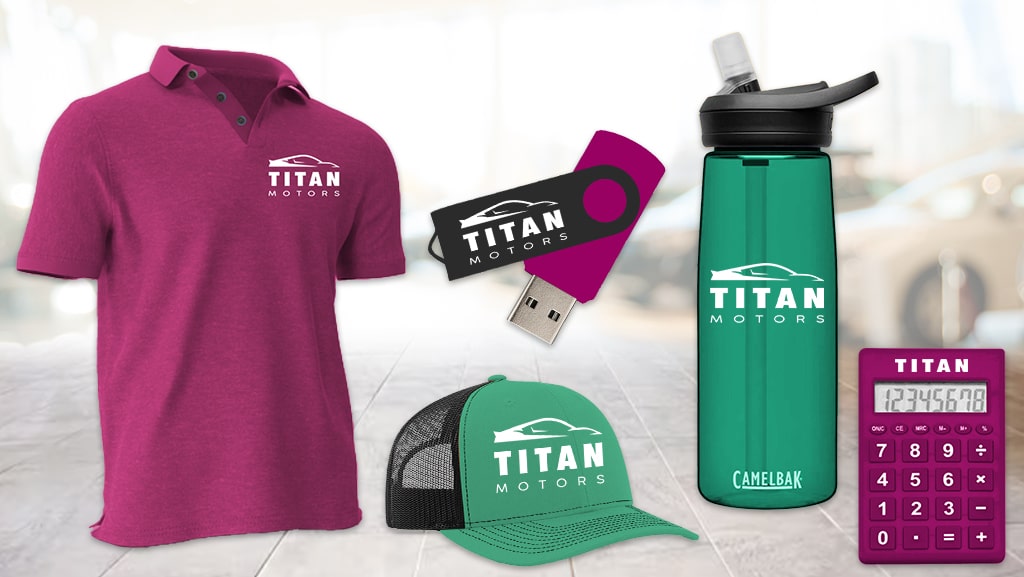
Titan wanted custom apparel, so we helped design hats, polo shirts, t-shirts, and hoodies for their staff. We also produced various office supplies– pens, calculators, mousepads, and post-it notes– with Titan's logo and phone number. Office supplies like pens are an incredibly effective marketing tool, as they are one of the most popular forms of promotional products.
Our team also had some product suggestions to spruce up Titan's showroom. We produced floor mats for their entryways, ensuring their logo is the first thing every customer sees in the showroom. Another great way we chose to amplify the brand was with branded water bottles! The car-buying process can be lengthy, and offering customers a bottle of water is a great way to set a friendly tone. With custom-branded water bottles, you add an air of sophistication to the dealership while boosting brand visibility.
Finally, we suggested another excellent idea for any dealership– branded flash drives for customer documents! With every car purchase, there is a ton of paperwork to be signed– the dealer bill of sale, the car purchase agreement, the odometer statement, and more. Eliminate the hassle by uploading the signed documents to a branded flash drive! Customers will be impressed with the high-tech solution and think highly of the dealership. For Titan, we went with an on-the-go USB drive, giving their customers the option to view documents using their phone or computer.
Reception and Results for the Showroom Products
Once again, the dealership was thrilled with the products they ordered! Our point of contact at the dealership let us know that the flash drives for customer documents were a major hit. Since this order, we've filled several reorders for their custom water bottles, flash drives, and office supplies.
Sponsoring an Event at the Dealership
An effective way for dealerships to spread their brand and attract potential customers is by sponsoring events! Sponsoring events like cookouts, car shows, or a free car wash gets people on the lot looking at your inventory and can boost your standing in the community. When we next heard from our friends at Titan Motors, that was the plan! They were sponsoring a BBQ-4-Charity event and needed branded products for the outdoors! Luckily, at Logotech, we carry everything you need when hosting an outdoor event: pop-up tents, table covers, chairs, advertising flags, banners, and more!
The Products for the Event
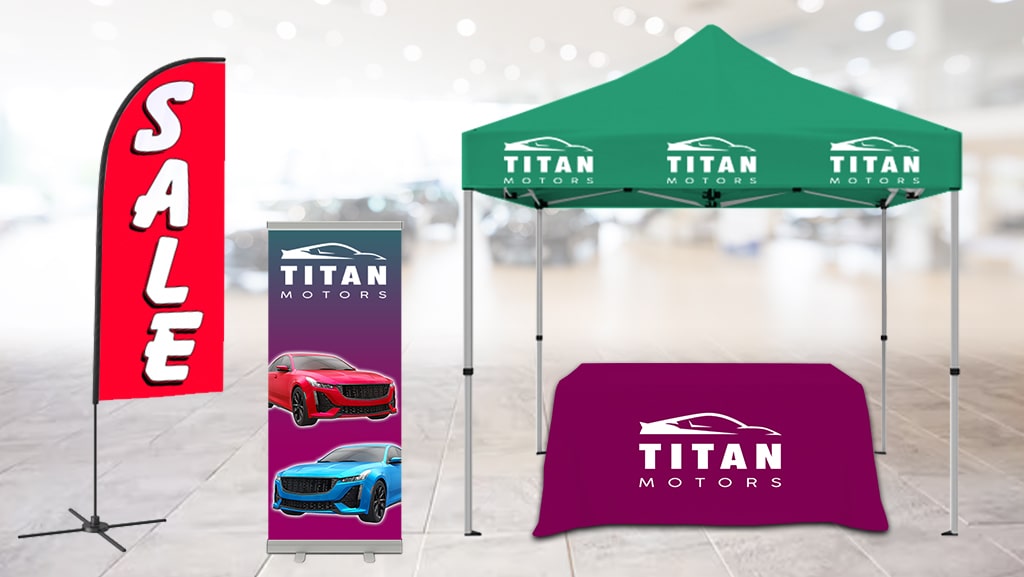
For their event, Titan wanted event tents, advertising flags, and table covers, all printed with custom designs. Their dedicated account manager was happy to help and took them through our wide range of options for event gear. They designed tents, flags, and table covers and added branded folding chairs to the order. We also suggested promotional BBQ sets for giveaways or raffle at the event, an idea they loved! All in all, we produced branded tents, flags, table covers, chairs, and BBQ sets for Titan's BBQ event.
Product Reception and Event Results
The feedback we got when we reached out after the event was stellar. The event was a major success for the dealership, and they were happy to have branded event materials they could reuse for future events. Also, the event led management to decide they wanted to improve the dealership's outdoor aesthetic. Yet again, Logotech was on the case!
Improving the Look of the Lot
One of the great things about the car dealership promotional products at Logotech is their versatility! We have hundreds of customizable products specifically designed for automotive brands. So, when Titan told us they needed to revamp the lot, we were chomping at the bit!
The dealership knew they wanted stand-in paper license plates for cars on the lot but wanted more products to deck out the lot fully. Our product specialists had several great recommendations! To create a complete branded experience in their cars, we suggested permanent outdoor balloons and teardrop banners for the lot. Titan was on board, and we got to work!
The Products for the Lot

We designed custom PolyCard license plates, permanent outdoor balloons, and teardrop banner flags, all printed with the dealership's custom designs! Custom products for the lot can serve multiple purposes. First, when customers see a decked-out lot, they think higher of the dealership. Furthermore, saturating the lot with your logo reinforces brand awareness and can catch the eye of passing drivers.
Reception and Result for the Lot Products
We made contact with Titan a few days after the order was fulfilled and found they were thoroughly satisfied yet again! They highlighted the seamless ordering process and friendly staff as their favorite things about working with Logotech and assured us we would remain their go-to for promotional product needs.
Boosting CSI with Promotional Products
The Customer Satisfaction Index (CSI) is a metric used to measure customer satisfaction with a product or service based on customer surveys. It's used across many industries and is especially important for car dealerships! Auto manufacturers receive the survey scores of every dealership they supply, and bad scores can lead to less favorable treatment and lower inventory. Therefore, positive customer surveys are worth their weight in gold!
Promotional products are a great way to boost CSI. Many dealerships gift branded merchandise giveaways as a thank you for submitted surveys. This is an excellent incentive for customers who may be too busy or indifferent to submit a survey otherwise! When we spoke with Titan Motors most recently, they were looking for a wide range of products to boost their CSI, and some products for the service department.
Since we began working with Titan, they transformed from a small dealer with 100 cars on the lot to the number one dealership in their area, selling well over 100 cars each month. This transformation made bolstering their CSI and public image a top priority! With custom-branded products for CSI and the service department, we planned to do just that.
The Products for CSI
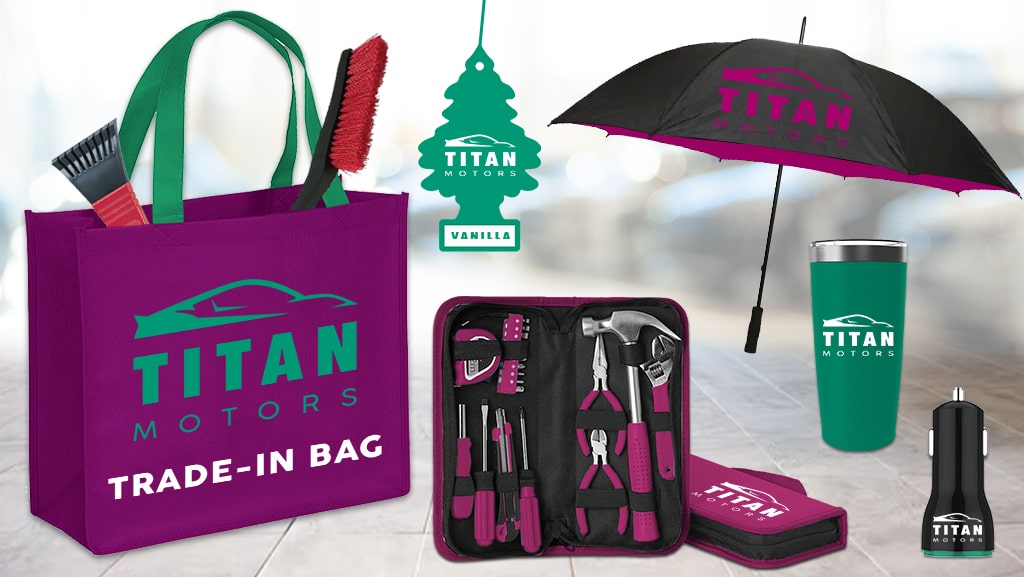
After a quality brainstorming session, they had a list of products for CSI purposes and the service department. We also helped them realize they could sell the CSI products from their parts department to generate extra revenue! The customized products for CSI were:
Umbrellas: Umbrellas are a classic promotional item for dealerships. The dealership selected a telescoping umbrella with a carrying case, and we printed their logo in full color on the outside of the umbrellas.
Emergency Car Tool Kits: Car tool kits come with tire pressure gauges, seat belt cutters/window breakers, jumper cables, and flashlights.
Travel Mugs: Travel mugs are another great choice for any dealership! Titan selected one of our double-walled vacuum-insulated tumblers, with their logo laser engraved on the front.
Trunk Organizers: Trunk organizers are a great way to help your clients keep their cars neat! Titan selected a foldable trunk organizer with handles, a popular choice.
Car Phone Chargers: Another staple promotional product, the dealership chose a car charger with dual USB slots, with their logo pad printed on the side.
Trade-in Bags: Trade-in bags are tote bags used to collect a customer's belongings from the vehicle they're trading in. Offering a branded tote bag to store these belongings is an excellent method for boosting customer satisfaction!
The products for the service department were:
Branded Air Fresheners: Leaving a branded air freshener in a customer's car after it's been serviced is a great way to boost your brand loyalty.
Seat and Steering Wheel Covers: These disposable covers are placed on the seats and steering wheels of cars in your service department. Then, when your mechanics are working on the car, the interior is protected!
Disposable Floor Mats: These paper floor mats are placed over the carpets of cars in your service department, keeping the carpets clean throughout service.
Reception and Results
The CSI and service department products were a big hit with the dealership! Our contact at Titan told us that since they introduced gifts for submitted surveys, they had seen a significant uptick in submissions. Plus, in the few weeks since the products were delivered, they had sold a few car tool kits from their parts department! They had put the service department products to use as well. It was great to achieve another success for our friends at Titan.
The Bottom Line
With that, the journey of the relationship between Logotech and Titan Motors comes to the present day. As you've seen, promotional products have massive versatility as marketing tools for car dealers. Whether you need to establish your presence in the community, host an outdoor event, improve your dealership's aesthetic, or boost your CSI scores, promotional products can give your business a lift toward those goals.
At Logotech, we offer the widest range of promotional products for car dealerships with the best prices! We have a dedicated team of promotional product experts, and we specialize in helping brands stand out. Create an account on our website today, and one of our account managers will contact you to start your order. Experience the power of automotive promotional products with Logotech!

- All Posts by Logotech (626)
- 100% Custom Products (375)
- Awareness Campaign (8)
- Client Stories (10)
- Event Marketing (3)
- Ideas & Tips (107)
- Logotech-4-Good (30)
- Product Information (19)
- Technology (138)
- LogoTech 4 Community (19)
- Press Release (1)
- Resources (4)
- Who, What, Where, When, Why and How? (84)
- Opinion (1)
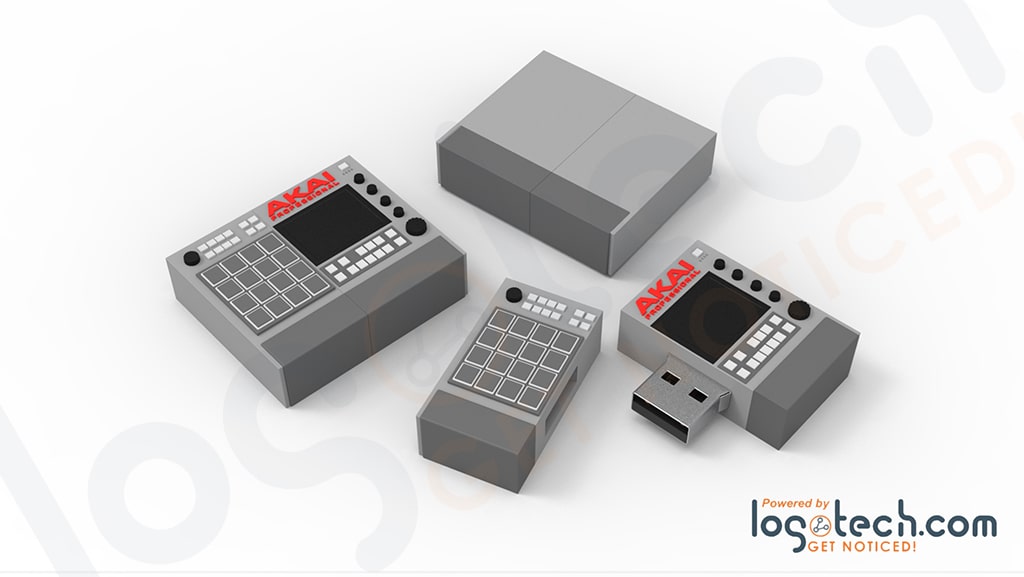
Please fill out a very quick form, and we will reply in no time! Name Email Phone Company Name url Quantity Please Select... 25 50 100 250 500 1000 2500+ Size Please Select... S M L XL XXL XXXL 128MB 256MB 512Mb 1GB 2GB 4GB 8GB 16GB 32GB 64GB 128GB 256GB 1000 MAH 2500 MAH 4000 MAH Message Submit
Thank you for submitting your request. Your Personal Account Manager will get back to you in no time at all.
Here is some useful information while you are waiting:
- Upload your logo now and we will make a free digital sample of your requested product.
- Complete your Logotech profile and you will get a 25$ credit towards your first order.
Thank you! We look forward to working with you.
As dramatic disruption comes to automotive showrooms, proactive dealers can benefit greatly
Dealers are operating in an increasingly disrupted environment, creating the need for dealers to review their own operating model, identify and unlock operational efficiencies, and discover new ways to operate in a digital, omnichannel environment. Over the past five years, we have worked with dealer groups, individual dealerships, and OEMs to study the impact of disruptions on automotive retail and the traditional dealer model; this article synthesizes our perspective on the space and its likely evolution. While we see several challenges to dealers and the traditional automotive-retail model, we also see opportunities for dealers to pivot the model in one of four ways to succeed in the new reality, including centering it on one of the following: luxury brands in tier-two cities; geographic scale and increased scope; ecosystem platform development; and less disrupted, rural markets. But no matter which future model dealers chose, now is the time to lay the groundwork, build the required capabilities, and capture near-term opportunities.
Stay current on your favorite topics
Automotive retail is changing.
Retailing is changing fast for many car dealers—and their bottom lines. Average dealership operating profits plunged from 8.9 percent in 2015 to 1.7 percent in the first half of 2018, while gross profits fell from 3.3 percent to 2.4 percent over the same period. Dealership sentiment is also shifting from optimism to pessimism based on the most recent industry research.
Two forces are limiting dealer profits. First, automakers continue to boost incentive pressure as they face growing price competition and thus squeeze the margins of their dealer networks. Second, third-party digital channels for research (for example, Autotrader, CarGurus, Cars.com, and TrueCar) and digital vehicle purchases (for example, Carvana, Shift, and Vroom) are increasing vehicle pricing transparency and enabling consumers to make product comparisons easier, thus limiting the ability of dealers to capture margin on the vehicle and to influence customers’ buying behavior.
Dealer margin pressures multiply
Likewise, used-car retailing is also digitizing rapidly as disruptive new entrants (such as Carvana, Roadster, Shift, and Vroom) launch price-competitive business models that simplify the buying and selling experience for consumers. Compounding the problem, dealership organizations continue to face operational challenges that include high turnover rates and consolidation pressures. As a result, dealer profits have decreased over time, and most dealer stocks are underperforming the market (Exhibit 1).
Dealers have historically relied on revenues generated by vehicle service work and financing and insurance (F&I) to offset the profit pressures and accordingly have grown their business in these areas. For example, F&I as a percentage of new- and used-vehicle gross profits increased from about 45 percent in 2015 to roughly 53 percent in 2018, driven by greater emphasis among dealers on F&I products (for instance, service contracts) as well as compression of vehicle margins. At the same time, dealership-parts-and-service-profit contributions continue to advance, with their share of total gross profits expanding from 45 percent in 2015 to over 49 percent in 2018. However, dealerships will likely soon reach the limits of further growth in these areas as automakers apply increasing pressure on parts and service and F&I penetration reaches a saturation point.
Disruptions to accelerate quickly
We believe the disruption of automotive retailing is just beginning and will accelerate rapidly in the coming years mainly due to the following three developments (Exhibit 2):
- Four automotive industry megatrends—autonomy, connectivity, electrification, and shared mobility (ACES)—will reshape the overall automotive ecosystem . At the same time, the digitization of the customer experience and dealership franchise dynamics will cause changes to automotive distribution in the short to midterm. Influenced by evolving consumer expectations, these trends will occur in parallel and mutually reinforce one another. For example, the increasing availability of autonomous capabilities will transform shared mobility as robo-taxis become more ubiquitous .
- Automotive retailing’s continued digitization and the growing importance of omnichannel marketing will put further pressure on margins. For example, we estimate the new-car purchase journeys will shift to 10–25 percent digital from 0 percent today, with used cars increasing to 25–50 percent digital from around 6 percent today. Used-vehicle profits could suffer due to greater price transparency and vehicle availability across markets. However, these innovations could offer better ways to serve customers and extract more lifetime value via tailored F&I offerings or the up-sale of parts-and-service contracts during vehicle negotiations.
- Disruptive and nimbler high-tech players will introduce new business models quickly, thus further reinforcing disruptions in the automotive ecosystem.
Disruptions will affect each traditional dealer profit pool
These disruptions will put additional pressure on industry earnings over the coming decade (Exhibit 3). For instance, in a “do nothing” situation, dealerships could see their total operating profit as a percentage of total gross earnings decrease to –0.3 percent due to shrinking traditional franchise dealership profit pools.
New-vehicle sales
We expect US franchise-dealer new-vehicle profit pools to decline about 9 percent during the next ten years. However, a disproportionate share of the decline will likely occur in densely populated urban areas like Los Angeles, New York, and San Francisco, primarily due to a decline of up to 17 percent in private new-car ownership and increased sales of used vehicles through e-commerce channels with lower margins.
Would you like to learn more about the McKinsey Center for Future Mobility ?
In the medium-to-long term, autonomous vehicles (AVs) and shared mobility will negatively affect new-car volumes. We believe AVs could make up as much as 13 percent of new-car sales volumes in 2030—a significant change from today. The resulting growth in fleet ownership could depress already low dealer front-end margins on new cars as well as F&I earnings.
Used-vehicle sales
The independent used-car profit pool of $16 billion today will likely decline an estimated 9 percent by 2030 as online penetration increases from around 6 percent to as much as half of all transactions. Every 1 percent increase in channel switching from in-store to online could result in an approximately $40 million decline in the profit pool due to the increased pricing transparency offered by online channels. Franchise dealers currently capture about 38 percent of the used-car market, concentrated among larger players in several subsegments. Several attackers are using digital technologies to connect buyers with used-car inventory to simplify the customer purchase journey (both connecting businesses to consumers as well as enabling consumer-to-consumer transactions); existing players experiment with the digitization of their operating model. Overall, the used-vehicle industry is heading toward further consolidation as large players continue to gain market share.
We believe e-commerce (for example, Carvana, Shift, Vroom, and traditional players enabled by software solutions), characterized by single pricing and streamlined processes, will grow more than 100 percent, taking business away from brick-and-mortar operations. Low-mileage, off-lease vehicles will represent prime digital territory due to their high quality and their prices.
Parts and service
We also project that the combined “do it for me” maintenance-service and aftermarket-parts profit pool will grow from about $40 billion to between $42 billion and $46 billion in 2030, while franchise service and parts will grow from $54 billion to between $57 billion and $60 billion, due to the growing number of cars on the road and increased parts costs. These factors should more than offset the potential impact of e-commerce (reducing part margins) and the extension of service intervals. However, by 2030, the increased penetration of battery electric vehicles (BEVs) and hybrid-electric vehicles (HEVs) will reduce car maintenance-related outlays—BEV maintenance spending is about half that of current internal-combustion-engine (ICE) vehicles.
Collision parts and service
Likewise, collision parts-and-service profit pools should grow from a combined $13 billion in 2017 to between $14 billion and $15 billion in 2030 due to increases in miles driven, which will more than offset reductions in accidents per mile, combined with an increase in the sophistication and price of parts.
Dealers need drastic business-model changes in the approaching age of autonomous, electric, shared vehicles
Leading dealership groups have so far focused on driving operational excellence and making the shift to increased F&I and parts-and-services businesses. However, to win in the rapidly evolving retail landscape, all dealerships need to adopt drastically different business models and pursue new revenue streams.
In the near term, we believe dealerships should continue to optimize the dealership footprint based on mobility trends and create multibrand showrooms focused on luxury brands to conserve real estate in large cities. It makes sense to improve the in-store customer experience as rapidly as possible, introducing digitization, making online and offline changes possible throughout the purchasing journey (a true omnichannel experience), and enabling flexible test-drive plans and other innovations. Dealers should also work to reduce operating costs via improved operating efficiency, which could mean taking steps such as upskilling sales consultants in phone and internet lead management or integrating the sales manager and F&I manger roles (within regulatory limitations).
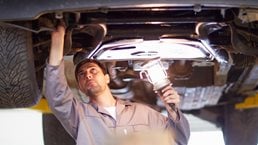
Ready for inspection: The automotive aftermarket in 2030
Potential midterm goals could include offering a seamless, digitized experience along the entire vehicle purchase and ownership experience to create stickiness and link shoppers to the dealership. Moving from a view based on vehicle or vehicle identification number (VIN) 1 Many dealer systems and processes today are focused on the VIN number or a specific vehicle, versus starting from the customer and providing a holistic view of the customer, for example, integrating all internal transaction data, service history, and average ownership time, as well as external data, like other vehicles owned or socioeconomic data, to form a holistic view of the customer and truly tailor marketing messaging and in-dealership experience. to a customer-based view for marketing and creating more personalized customer outreach will further help dealerships grow share of wallet. Companies could also expand their presence in maintenance parts to increase the average lifetime value of customers and strengthen their offering of collision services and crash parts to offer customers a one-stop shop for vehicle sales, service, and collision repair.
Dealers that take an aggressive stance on operational efficiencies and redesign in-dealership operations to cater to a more digitized customer base often capture greater sales volumes and profitability (for example, capturing larger share in or beyond territory, up to 300 basis points higher return on sales than comparable dealers). Approaches include the following:
- Extensive training regarding the management of digital leads. This includes the introduction of lead scoring, response-time optimization (with best in class measured at less than ten minutes with a tailored, personalized response), and after-hours touchpoints.
- Rigorous, data-driven performance dialogues with sales consultants and managers. While this approach is often considered basic, many dealers miss opportunities to identify the specific problems of individual sales consultants by sales-funnel stage and lack targeted one-on-one coaching and training.
- Integration of the sales-manager and finance-manager roles and sales-consultant upskilling to manage more of the process. This will reduce head count, creating a more seamless customer experience with fewer hand-overs and ultimately resulting in a shorter overall sales process. Dealers that have implemented this approach successfully have maintained F&I attachment rates and front-end or back-end gross margins while reducing head count and process times, improving customer satisfaction, and increasing sales conversion.
- Digitization of the in-dealership process. For example, this can be done with virtual trade-in appraisal, scanning of customer ID upon arrival for easy document preparation, and use of external data to create a more comprehensive view of customers). The dealership should put all available customer data at the fingertips of the sales consultants, including prior transactions and service histories, insights into sociodemographic elements, and so on, to enable a highly customized sales interaction. It also means using dealer and third-party data to reach out proactively to customers with the right marketing offer at the right time.
With the entry of new digital disruptors, customer expectations are rapidly changing. Dealers can no longer simply post their inventory online and hope for the best. Instead, they need to build the capabilities required to engage customers both online and offline via an omnichannel strategy. They must fine-tune their e-commerce solutions and enable customers to dig deeply into the offering online before coming into the dealership. Dealers should also think about their marketing spending efficiency including not just lead count but also lead quality, conversion, and customer insights provided by third parties. As the digital universe expands with online retailers and software offerings from established and newer players, dealers need to approach partnerships strategically to strengthen their digital presence and their omnichannel purchase path. 2 Consumer platforms could play an important role in realizing this approach going forward, since end-to-end digital platforms offer consumers a streamlined and tailored experience throughout the customer journey.
Models for a new retailing space
As dealers confront these changing realities, we see the potential for four new dealership models to emerge over the next decade (Exhibit 4). These models will likely center on luxury brands in tier-two cities; geographic scale and increased scope; ecosystem platform development; and less disrupted, rural markets. As these new models come to life, we expect the total dealer count and number of dealer groups to decline.
- Brand focused dealerships in tier-two cities. Dealerships pursuing this strategy will focus on luxury brands that will likely withstand more severe disruptions due to consumer loyalty and the differentiated brand and customer experience they offer. They will likely grow their presence in tier-two cities less severely affected by the trends discussed above. We would expect regional and brand-level dealership consolidation to occur, supported by strong improvements to operational efficiency and high customer focus.
- Building geographic scale and growing scope. Dealerships pursuing this strategy will look to expand their geographic scale (inorganically) by moving into adjacent geographic markets and increasing scale in their current market. They will increase the scope of their work by adding new capabilities—increasing penetration of white-label F&I products, or becoming stronger players in collision services and crash parts, for example—or forming partnerships with local mobility providers to provide services and parts. Offering a broader range of services will allow these players to offset profit losses in new and used vehicles while creating new capabilities to make the business more resilient.
Creating a platform ecosystem. During the past three years, as other retailers have experienced several pressures that automotive retail is starting to experience, successful players have focused on leveraging an in-depth understanding of their customer (including loyalty and share of wallet) and created personalized offerings to grow share of wallet instead of just number of transactions. Supported by stronger customer-relationship-management models and customer insights, retailers have developed tailored product and service propositions that appeal to different customer segments and help drive consolidation of spending with one retailer. The propositions can be effective if they are delivered in a seamless, high-transparency, high-control mobile environment with high convenience. Applying this to dealerships could include one-touch updates on current finance payments and equity position, a seamless service process, insurance management, and so on.
Dealers pursuing this strategy should consider developing a sticky platform ecosystem that allows the customers to engage online and offline seamlessly and creates opportunities to capture revenues beyond the core offering while working across a broad portfolio of brands beyond luxury OEMs. Customers should be able to access all dealership services and fulfill their transportation needs in one central location. Examples of potential consumer propositions to be developed by dealers could include creating personalized offerings based on customer loyalty, behavior, or a specific affinity group (for instance, offer concierge services to luxury customers such as pickup and drop-off for cars and increased service loaner availability). The platform would also bring benefits to customers such as automatic discounts to service and opportunities to generate revenue (for example, peer-to-peer car sharing supported by the dealer group with a free car wash and automatic refuel before the car is returned to the owner). This in turn provides a higher frequency of touchpoints with customers for the dealer to create a stickier environment. Creating a portfolio of mobility-services-related partnerships, potentially via equity stakes, will be a key part of this strategy.
Aftermarket parts could become as important as financing was 20 years ago, with captive OEM brands retaining warranty-related market share while dealers increasingly access the independent aftermarket and their own in-house white-label brands to lure off-warranty customers to replace declining used-car profits. To further participate in this parts profit pool, dealers might look to build new capabilities in parts management, for instance, a seamless parts-ordering and logistics experience to existing as well as potential new parts customers, to grow share of wallet.
- Prioritizing low-disruption markets. Dealerships with a predominately rural footprint are most likely to pursue this strategy. These players will focus on areas less affected by the emerging trends—nonurban and rural locations—and will continue to pursue a more traditional dealership model with a much slower pace of innovation. They could become customers of dealer groups who have developed parts and platform capabilities and purchase these assets rather than building them in-house.
To build a successful business model, dealers might choose to combine more than one of the outlined models, especially if they already have a diverse geographic or brand footprint and want to maximize value from existing assets and capabilities.
Dealerships must find a balance between protecting their existing business while finding growth in what is becoming a disruptive space. Experience suggests that heavily focusing on new mobility models only could be unsuccessful as the residual risk is difficult to manage. Consequently, we believe dealers should focus on growing share of wallet from customers through better insights, capturing new revenue streams in adjacent markets while implementing operational improvements and digitizing traditional segments.
Explore a career with us
Related articles.
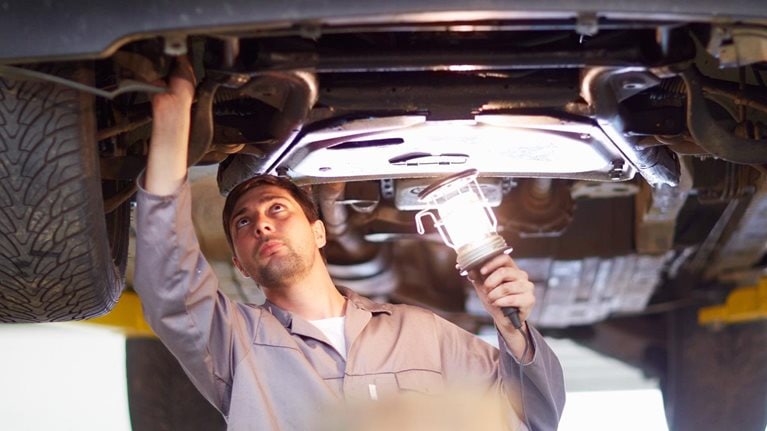
How the auto industry is preparing for the car of the future
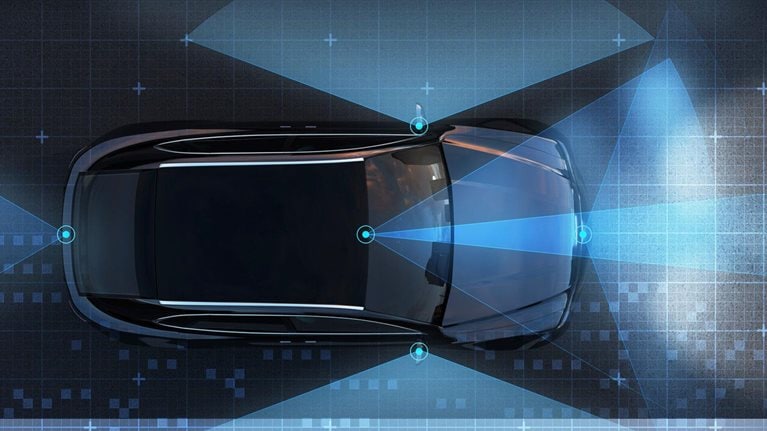
Setting the framework for car connectivity and user experience

See how digital marketing helped Lotus Cars deliver their first sales growth in 4 years worth $3M+ using content & social media tactics.
- February 18, 2023
- Case Studies
- Paul D'Ambra

Automotive digital marketing consulting
I was contracted by Lotus Cars Australia between 2016 & 2018 to provide automotive digital marketing consulting complimented with event management support. Using both go to market strategies I helped deliver incredible sales growth with a mix of marketing executions that grew the brand’s exposure in Australia in a short period of time.
Using a mix of automotive content marketing, SEO development, public relations & social media community engagement I helped to generate over $3M in sales growth of new vehicles with a marketing budget of less than $50,000.
This type of sales growth and increase in visibility can be achieved for any brand, product, service or tour in the automotive industry whether that is for cars, 4WD’s, accessories or vehicle upgrades. In this short automotive marketing case study I explain how I achieved these results
The strongest sales growth period in 4 years

It is well documented that Lotus sports cars is an automotive brand sold in Australia that has changed ownership many times in its long history. In Australia this vehicle manufacturer has been sold by different vehicle distributors over the years but never managed to achieve significant sales volumes or brand exposure. The NSW sports car dealer, Simply Sports Cars , was the top selling dealership in Australia and they secured the rights to be the distributor for the brand.
With this renewed focus they engaged me to provide short term marketing consultancy to provide what was essentially an outsourced marketing resource instead of hiring a full time employee. The benefit of doing this is the lower overall staff costs & the ability to hire a contractor with lots of marketing experience.
Their goal was simple, increase exposure for the brand in Australia and sell more vehicles but work with a very limited marketing budget.
What digital marketing did the car dealership need?
With a very limited marketing budget my brief was to leverage any asset or relationship available to generate exposure for the vehicles in their range & the unique lifestyle that is created with ownership of the brand.
Without resorting to price discounts, typical seasonal automotive industry promotions or big media spends I used a mix of;
- Website content creation
- Social media management
- Forum / online community management
- SEO development
- Lifestyle photography
to bring the brand to life with a focus on the people and the community that Lotus ownership could deliver. Instead of focussing on car specifications or highly styled photo shoots in a studio, everything presented to consumers showed the mix of people who had great fun and enjoyment from owning a Lotus and being part of the lifestyle focussed on driving events, track days and other social activities.
The local dealership was not able to make any changes or develop the global OEM website so I had to redevelop the local dealer website as the main platform to communicate with local consumers. This could be done for any dealership or reseller that has agreements in place with global brands, but has a local trading entity.
The first actions I undertook was was focussed on improving the website content marketing activities so that the vehicle ownership experience was brought to life. I placed a huge focus on including stories and photos of people enjoying the vehicles and this was shared on social media, local online forums, local car clubs and other online platforms to earn exposure in front of new audiences while engaging existing owners.
My marketing contract period lasted just over two years and didn’t require agency involvement with the bulk of the work completed in-house to reduce costs, maximise efficiency and deliver a high level of authenticity for the brand.
These are activities I worked on;
- Website search engine optimisation.
- Website content creation using a mix of photography & videography.
- Vehicle and event photography
- Social media, forum and Facebook group community management.
- Public relations management with local media & car clubs.
- Event management for vehicle displays and driving events.
- Marketing collateral creation for the showroom and events.
- Google My Business listing optimisation.
- Google Analytics & Google Search Console optimisations.
- Google Ad Words campaign management.
Do car dealers have to rely only on carsales listings to sell new or used vehicles?
Every car dealership in Sydney uses carsales to list their vehicle stock & one of the challenges is the cost because you get charged per lead. In lots of cases these could be people just browsing, so it becomes a very expensive way to sell vehicles with your cost per acquisition anywhere up to $100 per vehicle.
The reason the industry is locked into this method of operating is because this vehicle listing website has such a dominant position online. According to estimates from Similar Web it gets over 12,000,000 visits per month with its closest competitor Cars Guide getting around 7,000,000.

So what else can a car dealer do?
There are other choices to list vehicles like Gumtree and Facebook Marketplace usage has become quite popular as well, especially after they made changes to the platform to cater specifically to car or boat dealers.
A dealer’s own website could be used to combat this because with the right automotive digital marketing that includes SEO for a car dealer’s website you can get found locally for the inventory you are carrying. If you do this together with producing local content a dealership can generate local visitors from organic search who are looking for things in the niche’s they cater for.
This principle applies if you are selling vehicles, accessories, services or even tours.
No – I am not talking about reposting generic information from the manufacturer, announcements of staff birthdays or the latest seasonal promotion – but instead, you can provide deep, good quality, information about the vehicles available for sale that uses keyword rich information that answers the most pressing questions people are wanting answers for.
You can even do free market research that takes about five minutes to complete. Below is a screenshot of all the questions being asked about the Lotus Emira that was released in 2021 and very quickly there was a stack of questions being asked online about this vehicle. I took that information and wrote content on the local NSW dealer’s website that answered most of the questions, within days organic traffic grew quickly & the dealer was getting visitors from around the world, not just locally.
While overseas visitors are not high value in terms of selling a vehicle, they do help towards the site improving its ranking for lots of keywords related to the topic of this vehicle, to it means even local Australian’s searching for information will find them online and get the information they want / need to make a purchase decision.
With the rest of the website hosting lots of content about events, activities and all the other aspects of ownership it contributes towards a consumer making a purchasing decision as they can see what they are buying into. This is a different approach to a typical OEM manufacturer website that focusses mainly on products.

Want proof that it works?
Do a quick test and search for ‘ Lotus Emira in Australia ‘ , even though the content was created nearly two years ago, the local dealership Simply Sports Cars has secured first page positions on search results in amongst news websites, the OEM global website and other results.
This principle can be applied equally to other automotive businesses that sell products or services, let’s try another one like ‘ snorkel installation Sydney ‘, as of February 2023 the first result is for Adrenaline 4WD which is another automotive client I provided digital marketing consulting to. I updated their website in the second half of 2022 with improved content marketing, SEO and updated brand positioning.
Installing 4WD accessories was one of the major services they provided together with 4WD tours and selling a range of products from their shop. Although, they hardly ever got discovered via organic search, they relied on their existing customer base and locals driving past their store.
The digital marketing consultancy I provided led to a 7X improvement in their organic search results year on year, so just over 2,500 people going to their website vs 340 or so the previous year. Much like the tactics used for the Lotus car dealership, I used a combination of content marketing, SEO and keyword research to understand what consumers were looking for and how the business could satisfy those needs.

Most car dealerships rely on their OEM website templates or locally made websites to try and generate leads. Although most of these have nothing more than generic copy & the same information as lots of other websites. So they are relying on consumers to decide they want that brand or vehicle. If they took things further & provided the information that people really want to know about, they can pick up organic search traffic to their website locally and grow their volume of leads.
This can be very powerful for people who are in their initial research phases and are looking for generic things like ‘new sports car models’ or ‘latest XX product’ where a local automotive store, local dealer or business can win online exposure by providing great content about those things they sell or services they provide.
This is the very strategy I implemented for this dealership which helped generate thousands of unique page views that contributed to selling new vehicles but also create brand exposure for the manufacturer & the dealership itself. It helped to also then sell servicing, upgrades, modifications and lots of events that were completely booked out.
All of this work had long lasting effects and we didn’t rely on paid advertising.
digital marketing that can increase vehicle sales
With the same range of vehicle models, same pricing & no discounting, the Lotus brand experienced their first year of sales growth in 4 years. During the same period other brands had recorded sales declines according to VFacts data released in that year.
The car enthusiast community became more engaged with the constant flow of content marketing that I was creating which told stories about the cars, the people, the driving events and the fellowship that owning a Lotus delivered for many people.
This exact same approach could be used by any company in the automotive industry as it can be applied to products, services, modifications, upgrades or even tours. The secret is creating good quality content that resonates with the target audience and is executed well enough to earn organic search traffic to your website.
Getting this right means you don’t have to spend as much money on paid advertising and can be discovered by people searching online for the types of things that you sell. As you can see below, this dealership enjoyed more than 140,000 page views across their website.

The digital marketing I executed were all tracked and measured using Google Analytics, Google Search Console & each social media platform’s insight tools. This meant the business owners could always see the actual results being delivered with total transparency. Qualitative feedback was also prevalent from the community of Lotus owners who were highly engaged on the social profiles and local forums.
I created a huge increase in website traffic volumes with more than 140,000 page views generated across different section of the site, improved community engagement levels across all social profiles with a growth in followers, I also became the leading contributor in local own forums as well as securing TV coverage for the brand on four separate occasions.
It meant the car dealership didn’t have to rely on vehicle listings on carsales.com.au to get their leads, for the first time in years, people were discovering the availability of vehicles & driving events through social media or organic search.

Here are some highlights from my automotive marketing consultancy;
- Secured the purchase of 3 vehicles used in promotional executions.
- Secured National TV coverage 4 times for the brand with $0 investment.
- A 390%+ increase in website traffic with over 144,727 page views generated.
- More than 50 content pieces created covering all manner of sports car ownership.
- Facebook & Instagram profiles doubling in size to over 4,000 followers.
- Content pieces created that reached over 30,000 people.
- New content pages & brand communications for the local website.
- The leading contributor to the local Lotus Forum 'Aussieelises'
- Prominent community engagement via Disqus on car websites.
- Created a local journalist database & CRM system.
- Achieved review coverage for the first time in years on local websites and magazines.
- Grew event participation that led to the full time role creation for Event Management.
- Overhauled CRM system with owner vs vehicle to enable personalised emails .
- Lead and managed the annual marketing calendar.
- Engaged with local car clubs and participated in charity events like 'Soar and Roar'
- Created and managed a local intranet portal for all brand assets.
- Created direct to consumer engagement mechanisms using WhatsApp.
- Refreshed all vehicle stock and event photography for use in promotional materials.
- Created unique driving experiences like 'Challenge Bathurst' and 'Twilight Rallysprint'

The marketing consulting reviews I received from this project

Can these types of digital marketing results be continued?
When my contracted period ended I provided a list of suggestions to help the brand continue the marketing activities and build from the momentum that had been created. These included;
- A continuation of sharing stories about the people & community driving the cars.
- Avoid using cheap gimmicks or seasonal promotional discounts to sell cars.
- Maintain a presence on the local forums and Facebook groups.
- Continue attending grass roots events to engage with car enthusiasts.
- Share content across all platforms including Google My Business.
- Avoid using brochure derived wording and phrasing to maintain a more personal level of communication.
2022 Update
New website creates even more traffic growth

In late 2020 and I was engaged again as a marketing consultant for the Lotus Cars dealership in Sydney. I conducted a review of their website traffic to see how things had evolved after I left in 2018.
As you can see in the Google Analytics report above, the growth trajectory for organic search website visitors was growing very quickly heading into the end of 2018. Although they didn’t continue with the same level of digital marketing execution and the traffic volumes remained steady. New website content wasn’t being created and activity on social media as well as forum platforms had dropped off as well.
The dealership continued to trade of course, although they decided to build a brand new website together with a new eCommerce store to sell more vehicles, spare parts and modification products. The new website would also assist with the launch of a new vehicle.
As you can see in the Google Analytics report above, the new website I built delivered record levels of website visitors in a short space of time. The website even out-ranked the manufacturer’s website for certain keyword phrases as well as news sites. It proved that a local car dealer can use a marketing consultant to grow visibility for their dealership using digital marketing tactics,
More details about what I did I will explain in a separate case study.

Do you want to grow your business?
Do you want to get new customers outside of existing referrals?
Want to reduce your paid advertising spending?
Hungry for a regular flow of traffic to your website to sell products or services?
Keen on converting more 'browsers' into buyers?
I can help solve these business challenges by using clever marketing tactics and common sense. I pull everything apart to work out what is not working with your marketing activities. I'll then create a practical, action driven strategy to improve the results you are getting.
I am a marketing consultant that can help a start-up, small business owner or six-figure medium sized business to deliver incredible marketing impact. You may find yourself stuck and unsure how to execute to achieve your marketing goals.
Free marketing advice & case studies
Go behind the scenes to see real data, genuine insights in my marketing case studies explaining how real world scenarios played out.

Digital marketing for a photography business
PictureMe won multiple commercial contracts after a 300% increase in year on year website traffic from my SME digital marketing consulting

Why social media can be an absolute waste of time and energy
Social media is used by so many businesses, but it’s probably an absolute waste of time. I’ll show you why & what is the ideal alternatives to use

Should you buy a one word domain name for sale?
Read this before you waste lots of money buying a one word domain name that may be a total waste of time
Freelance marketing consultant
Paul D’Ambra is a freelance marketing consultant located in Sydney, Australia that can help a business located anywhere in the world with their marketing efforts. Using more than 25 years of experience in retail, wholesale and commercial environments.
Paul will inject energy & common sense into your marketing activities that will increase sales of any product or service. See my marketing case studies and free marketing advice .
Client area
© Copyright 2023 ABN: 77240813694
Paul D’Ambra Marketing Consultant in Australia Phone : +61 414 442 440
Case Study: Successful Marketing Campaign for Car Dealer - Increase Sales by 31% in Half a Year
by Philip W | Nov 9, 2023 | Case Study

Introduction
Working with a car dealership client was one of the most interesting challenges we had in 2023. Our main goal was to attract customers for vehicle purchases, test drives and business customers whose leases were coming to an end. In the following article, we will talk about the details of our marketing strategy and the results we achieved, i.e. increasing sales by an impressive 31% in six months.
Chapter 1: Initial Strategy
The first and key step in our cooperation was to discuss with the client his business goals. The car dealer approached us with a clear goal - to increase vehicle sales. Together we determined the profile of the ideal customer we were interested in. Our client was looking for adults, with no debts or debt collectors, who showed interest in purchasing a vehicle, were looking for a car loan or were interested in taking test drives. In addition, we offered a strategy for acquiring business customers whose leases were running out.
Ideal Customer Profile:
Without a history of debt or a debt collector.
Expressing interest in purchasing a vehicle.
Potentially interested in a car loan.
Eager to schedule a test drive.
Companies with expiring leases.
Chapter 2: Multichannel Marketing Strategy.
After determining the profile of the ideal customer, we moved on to selecting the appropriate marketing channels. Our marketing strategy was multi-channel and included:
E-mail Marketing : We developed personalized e-mails that targeted customers with an ideal profile. Our e-mails included information on offers, encouraging recipients to visit the showroom, schedule test drives or download price lists.
SMS Marketing : Together with the client, we created SMS campaigns that informed about promotions, special offers and vehicle availability. Thanks to this form of communication, we were able to reach customers more directly.
Display Ads : We launched advertising campaigns on our industry websites and on car loan comparison sites. Our ads were visible to a wide range of potential customers interested in buying a vehicle.
Call Center : Our Call Center called interested customers, offering to help them schedule an appointment at the dealership or test drive. Callers were trained to provide a high level of customer service and effectively communicate information about offers and promotions.
Remarketing : We used remarketing to reach people who visited our client's website but did not perform any desired action. This tool allowed us to keep in touch with potential customers and encourage them to return.
Chapter 3: Campaign Results
After six months of intensive work, our marketing efforts have yielded amazing results:
Customer car sales increased by 31% on a monthly basis, and this trend is increasing.
The client's website was visited by o 20 thousand More people than usual on a monthly basis. This is a significant increase in interest in the offer.
Over 1000 people downloaded price lists, indicating a large number of potential customers interested in purchasing vehicles.
The number of customers making appointments for test drives increased by about 39% compared to the period before our cooperation. This translates into more potential sales.
Chapter 4: Customer Satisfaction
Our cooperation with the car dealership not only brought an increase in sales, but also great customer satisfaction. We were able to meet his expectations and help him achieve his business goals. The client is very satisfied with the results achieved and plans to continue our cooperation from the new year.
Chapter 5: Continuing Cooperation
Our case study does not end with the results achieved. We plan to continue working with the client in the coming year. We will continue to support him in acquiring new customers, developing his offer and striving for further success in the car market.
Our partnership with the car dealership is an excellent example of a successful marketing strategy that has contributed to a significant increase in sales and customer numbers. Through a well-developed profile of the ideal customer and the use of multiple marketing channels, we have achieved impressive results. Our client is satisfied, and we are ready to continue our fruitful cooperation in the coming year. Thanks to this case study, we can draw inspiration for further activities and the development of effective marketing strategies.
Recent Posts
- Case Study: How our agency assisted a leader in the cash loan industry
- Own affiliate network with affiliate programs in affiliation
- Case Study: Affiliation during May Day. A campaign for home improvement stores
- Contact base management in affiliate marketing
- Case Study: How we increased OC and AC insurance sales using the Call Center
Recent Comments
- Uncategorized

Core Services
- Outsource to Navtark
- Case Studies
Car Dealership Website Development Case Study
- June 9, 2023
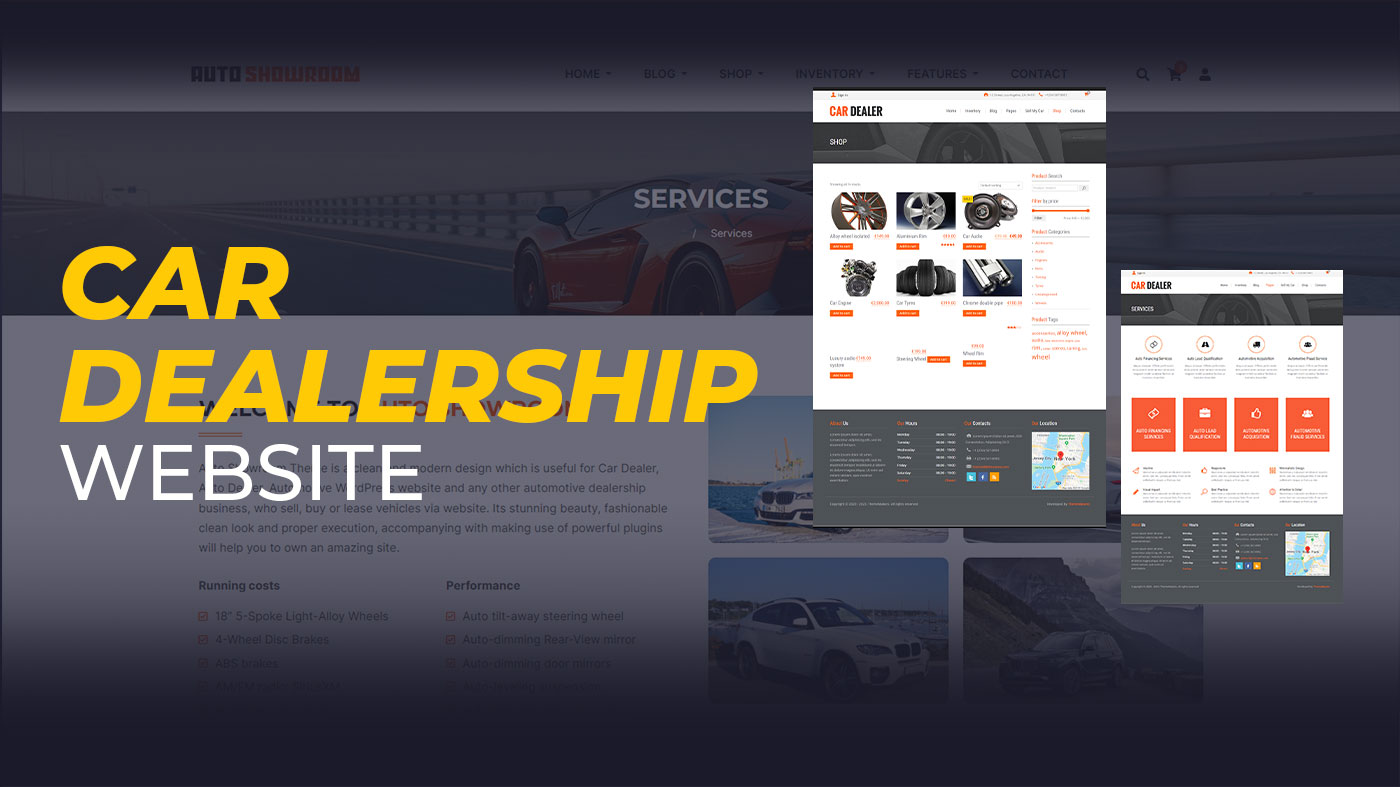
Introduction
This case study highlights the successful collaboration between Navtark, a leading web development agency, and one of its partner car dealerships. Navtark was approached by the dealership to develop a modern and feature-rich website that would enhance their online presence and drive more qualified leads. By understanding the specific requirements of the automotive industry and implementing a tailored solution, Navtark delivered a dynamic website that effectively showcased the dealership’s inventory, provided valuable information to potential buyers, and streamlined the lead generation process.
Problem Statement
The partner car dealership faced several challenges with their existing website. The website had an outdated design, limited functionality, and did not effectively showcase the dealership’s extensive inventory of vehicles. The challenges included the need for a visually appealing design, improved user experience, seamless inventory management, integration with customer relationship management (CRM) systems, and advanced lead generation capabilities.
The Challenges
- Outdated Design: The existing website had an outdated design that failed to create a positive impression on potential buyers. A modern and visually appealing design was needed to reflect the dealership’s brand and attract buyers.
- User Experience: The website lacked an intuitive and user-friendly interface, making it difficult for visitors to navigate and find the desired vehicle information. Improving the user experience was crucial to engage visitors and encourage them to explore the dealership’s inventory further.
- Inventory Management: The dealership struggled with efficiently managing their inventory on the website. It was time-consuming to update vehicle information, add new listings, and remove sold vehicles. Streamlining the inventory management process was essential to provide accurate and up-to-date information to potential buyers.
- CRM Integration: The dealership needed a seamless integration with their CRM system to capture and manage leads effectively. The existing system required manual data entry and lacked automation, resulting in potential leads falling through the cracks.
- Advanced Lead Generation: The dealership sought advanced lead generation capabilities, including the integration of online finance calculators, trade-in value estimators, and the ability to schedule test drives online. These features would enhance user engagement, provide valuable tools to potential buyers, and increase lead conversion rates.
The Solution
Navtark proposed a comprehensive solution to address the challenges and meet the dealership’s objectives. The solution included:
- Website Redesign: Navtark designed a visually appealing and modern website that aligned with the dealership’s brand identity. The new design incorporated high-quality images, interactive elements, and an intuitive layout that enhanced the overall user experience.
- User-Centric Interface: Navtark implemented an intuitive and user-friendly interface, focusing on easy navigation, clear calls-to-action, and optimized content placement. The goal was to create a seamless user experience that encouraged visitors to explore the dealership’s inventory, schedule test drives, and submit inquiries.
- Dynamic Inventory Management System: Navtark developed a custom inventory management system that allowed the dealership to easily update vehicle listings, add new inventory, and remove sold vehicles. The system automated the process, ensuring accurate and up-to-date information for potential buyers.
- CRM Integration: Navtark integrated the website with the dealership’s CRM system to streamline lead capture and management. This integration automated lead data entry, ensured timely follow-ups, and facilitated effective lead nurturing and conversion.
- Online Finance Calculators: Navtark integrated online finance calculators that allowed potential buyers to estimate monthly payments based on vehicle price, down payment, and interest rates. This feature empowered buyers to make informed decisions and increased the likelihood of lead conversion.
- Trade-In Value Estimator: Navtark developed a trade-in value estimator tool that enabled potential buyers to estimate the value of their current vehicle for a trade-in. This feature simplified the evaluation process and encouraged buyers to consider a trade-in with the dealership.
- Online Test Drive Scheduling: Navtark implemented an online test drive scheduling system that allowed potential buyers to conveniently schedule test drives through the website. This feature enhanced customer convenience and reduced administrative workload for the dealership.
The Implementation
Navtark followed a systematic approach to implement the solution:
- Requirement Gathering and Analysis: Navtark conducted in-depth discussions with the car dealership to understand their specific requirements, target audience, and branding guidelines. This phase involved gathering necessary assets, outlining the website’s structure, and defining the functionality and integration requirements.
- Design and Development: Based on the dealership’s brand guidelines and industry best practices, Navtark created custom design mock-ups and wireframes. Once approved, they proceeded with front-end development using HTML5, CSS3, and JavaScript. The back-end development involved implementing a robust content management system (CMS) such as WordPress , customizing it to meet the dealership’s requirements, and integrating necessary plugins for inventory management, CRM integration, and lead generation features.
- Inventory Management System: Navtark developed a custom inventory management system that allowed the dealership to easily manage their vehicle inventory. The system allowed for efficient vehicle listing updates, automatic removal of sold vehicles, and integration with the website’s frontend for real-time inventory display.
- CRM Integration: Navtark integrated the website with the dealership’s CRM system, ensuring a seamless flow of leads and automating lead capture. The integration enabled lead data to be automatically synchronized between the website and the CRM system, eliminating the need for manual data entry and reducing the chances of leads being lost.
- Advanced Lead Generation Features: Navtark developed and integrated the online finance calculators, trade-in value estimator, and test drive scheduling system. These features were custom-built using a combination of front-end and back-end technologies, ensuring optimal performance and user experience.
- Quality Assurance and Testing: Navtark conducted rigorous testing to ensure cross-device compatibility, responsiveness, functionality, and data accuracy. Extensive user acceptance testing was performed to ensure a seamless user experience and proper functioning of all integrated features.
- Content Migration and Launch: Navtark assisted the dealership in migrating existing website content to the new CMS. They also provided guidance on content optimization for search engines. Once all content was migrated and tested, the website was deployed to a reliable hosting environment and officially launched.
Technical Description
Navtark utilized a range of technologies and tools to develop the car dealership’s website:
- Front-End Development: HTML5, CSS3, and JavaScript were used to create a visually appealing and responsive website. These technologies ensured cross-device compatibility and an engaging user interface.
- Content Management System (CMS): WordPress was customized to provide a user-friendly platform for content management. Custom post types and templates were created to manage vehicle listings, blog posts, and other relevant content.
- Inventory Management System: Navtark developed a custom inventory management system using PHP and MySQL. This system allowed the dealership to easily update vehicle listings, track inventory status, and remove sold vehicles.
- CRM Integration: Navtark integrated the website with the dealership’s CRM system using API integration or compatible plugins. This integration facilitated seamless lead capture and synchronization, ensuring effective lead management and follow-up.
- Advanced Lead Generation Features: The online finance calculators, trade-in value estimator, and test drive scheduling system were developed using a combination of front-end and back-end technologies such as JavaScript, PHP, and AJAX. These features were integrated into the website using custom coding and plugin development.
- Hosting and Deployment: The website was hosted on a reliable and scalable hosting environment, ensuring optimal performance and availability. Security measures such as SSL encryption and regular backups were implemented to safeguard the website and user data.
The Outcome
The partnership between Navtark and the car dealership resulted in a successful website launch and notable outcomes:
- Enhanced User Experience: The new website featured a modern design, intuitive navigation, and easy-to-use interface, providing an enhanced user experience. Visitors could easily search and browse the dealership’s inventory, schedule test drives, and submit inquiries.
- Streamlined Inventory Management: The custom inventory management system simplified the process of updating vehicle listings, ensuring accurate and up-to-date information for potential buyers. The dealership could efficiently manage their inventory, add new listings, and remove sold vehicles.
- Improved Lead Generation and Conversion: The integration of advanced lead generation features, such as online finance calculators, trade-in value estimator, and test drive scheduling, increased user engagement and lead conversion rates. Potential buyers had valuable tools at their fingertips, resulting in more qualified leads for the dealership.
- CRM Integration and Automation: The seamless integration with the dealership’s CRM system streamlined lead capture and management. Automation reduced manual data entry and ensured timely follow-ups, improving the overall efficiency of the sales process.
- Increased Online Presence and Brand Image: The new website showcased the dealership’s inventory in a visually appealing manner, elevating their online presence and strengthening their brand image. The professional design and user-friendly interface left a positive impression on potential buyers.
Bottomline:
The collaboration between Navtark and the car dealership resulted in a successful website development project that addressed the challenges faced by the dealership’s outdated website. By leveraging modern design principles, a user-centric interface, a custom inventory management system, CRM integration, and advanced lead generation features, Navtark delivered a high-performing website that aligned with the dealership’s brand and objectives. The dealership experienced enhanced user experience, streamlined inventory management, increased lead generation and conversion rates, and improved brand image. The successful outcome of this project highlights Navtark’s expertise in web development for the automotive industry and their commitment to delivering tailored solutions to their partners.
Most Popular

Landscaping Firm Website Development by Navtark
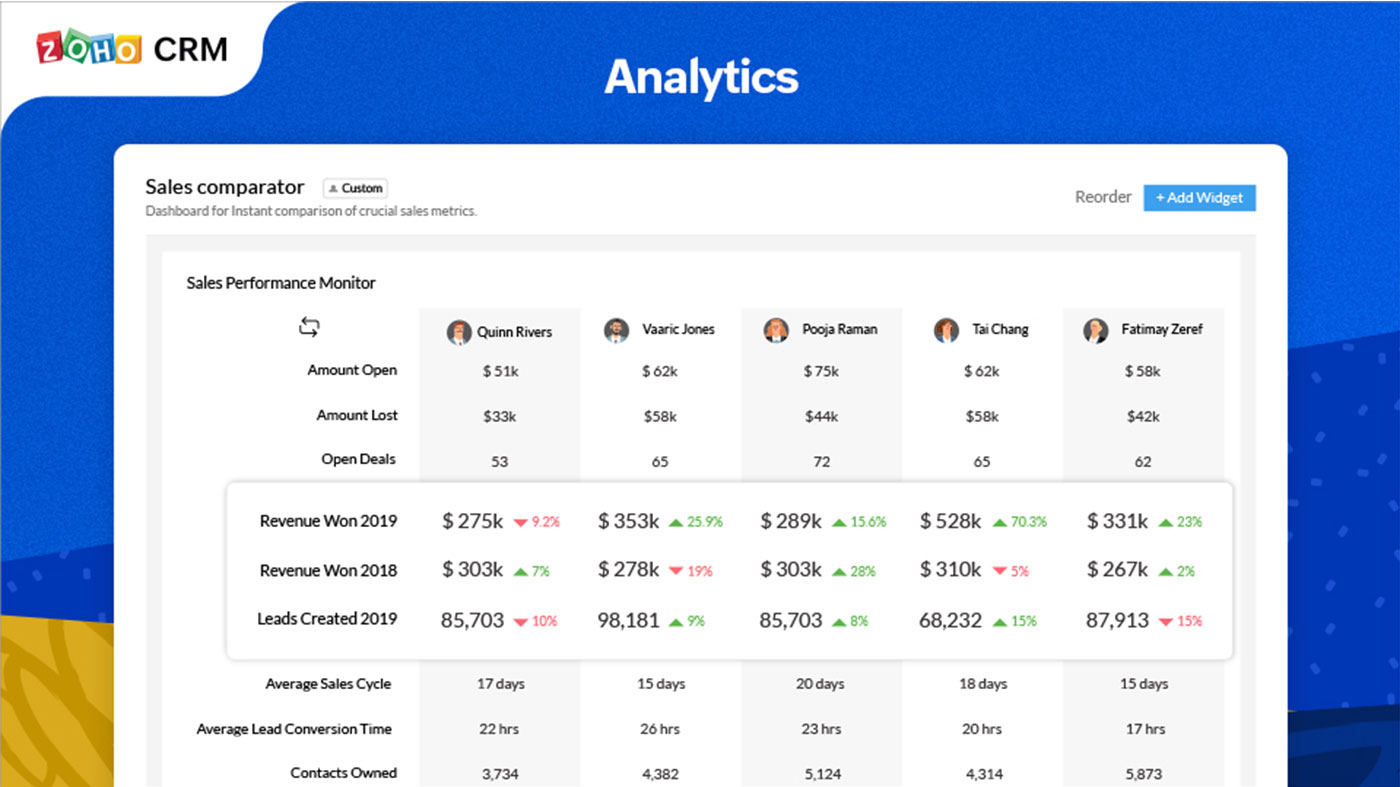
Zoho CRM Implementation and Customization by Navtark
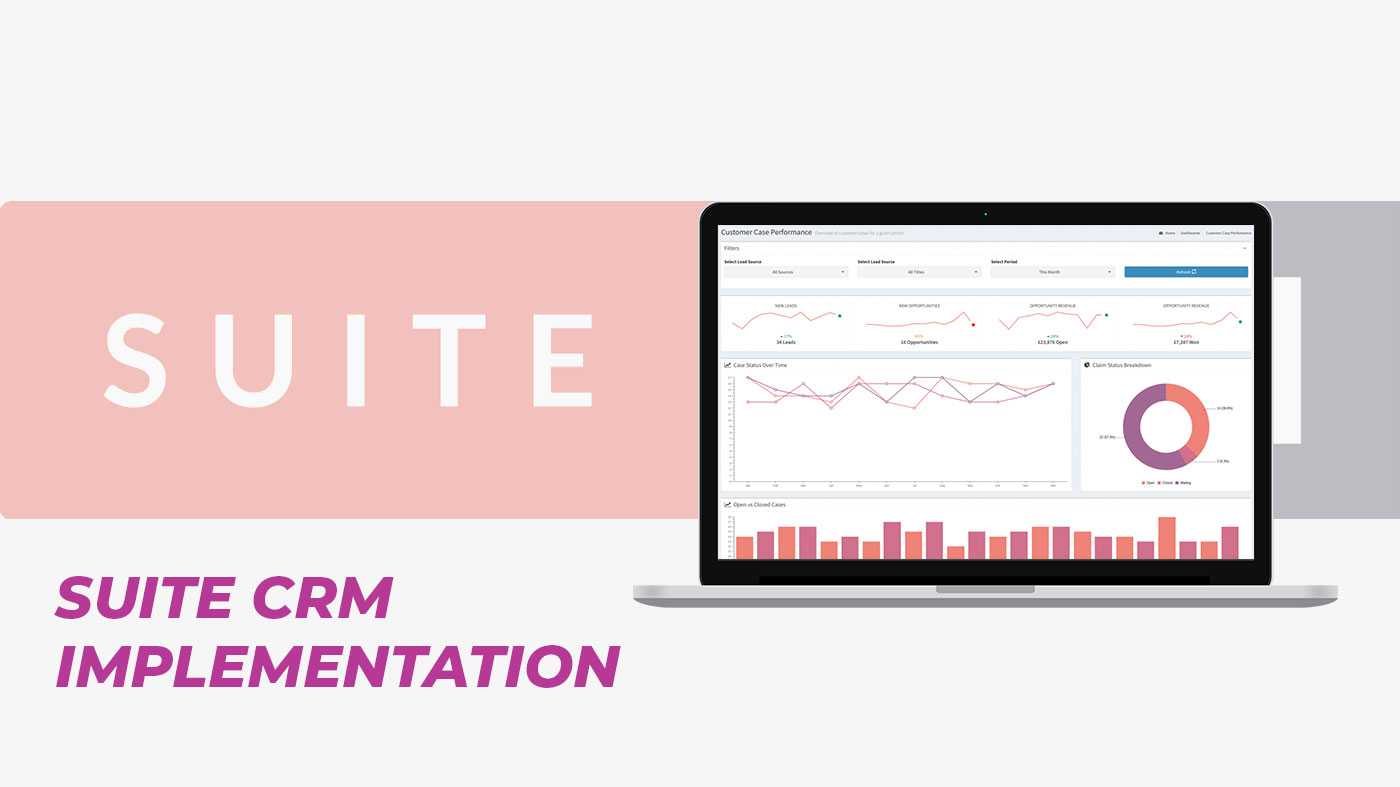
Suite CRM Implementation by Navtark
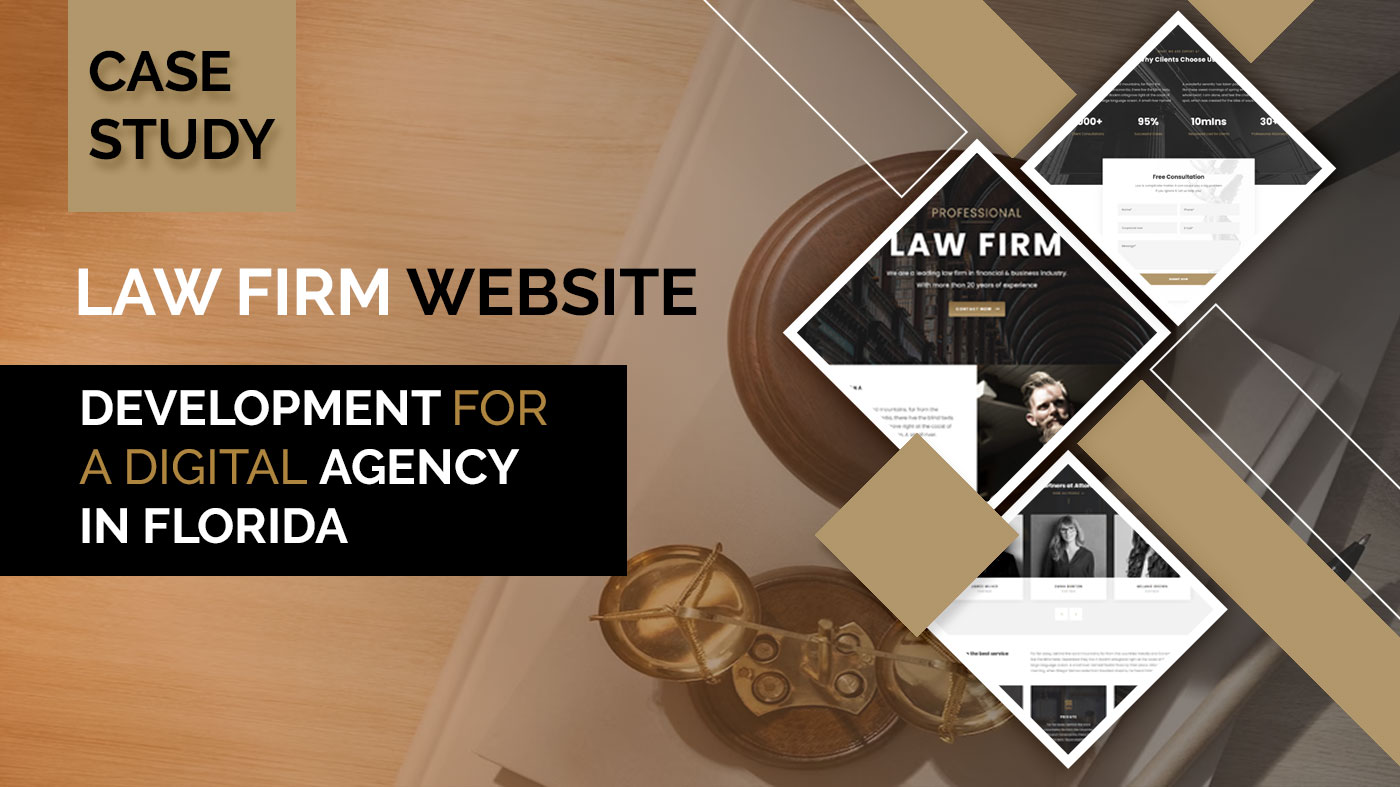
Law Firm Website Development for a Digital Agency in Florida
Ready to take your business to new heights experience the power of navtark's cutting-edge it solutions and unlock your true potential. discover how we've helped businesses like yours achieve remarkable success. don't miss out on this opportunity to thrive in the competitive landscape., related case studies.
303, 805, Pukhraj Corporate, Navlakha, Indore (M.P), 452001, India
Sales/Business Enquiries: +91 834 911 1605 International Sales: +1 415 226 6360 HR Enquiries: +91 810 909 9989
- Web Development Services
- Mobile Development Services
- Cloud Computing Services
- Online Marketing Services
- Custom Software Development Services
- ERP And CRM Solution
- PHP Development Services
- Java Development Services
- WordPress Development Services
- Magento Development Services
- Laravel Development Services
- Android Development Services
- Flutter Development Services
Products/Packages
- Home Services Apps
- Pest Control Apps
- Startup IT Services
- Nav Zoom Meet Plugin
- Navtark Wordpress to App
- On Demand Food App Solutions
- Our Services
- Privacy Policy
Website Development In USA
- Pennsylvania
- Massachusetts


Photo raises concerns about car dealership's marketing practice: 'Did you report it?'
M ost modern cities were built to facilitate cars — usually at the expense of other forms of transportation. Even still, cars are constantly infringing on paths meant for bikers, pedestrians, and buses.
A Redditor posted such a case in the r/f***cars subreddit.
The photo captures a Honda dealership using the majority of a sidewalk to showcase their cars.
In the comments, the OP posted an aerial view to give another angle of the problem.
"Spotted this car dealership using the sidewalk as its own parking lot," the OP wrote above the photo.
With cars already dominating the road, it seems a bit greedy that they would take up pedestrian real estate, too. It forces pedestrians onto the road and creates a dangerous situation for those opting to forgo driving.
Infrastructure designed for public transportation , pedestrians, and bikers is crucial in the crusade against dirty energy . The more accessible it is, the more appealing it is. As the famous quote from "Field of Dreams" says, "If you build it, they will come."
Fuel-burning transportation is a major contributor to air pollution , accounting for almost 30% of all harmful carbon pollution according to the EPA. The World Health Organization reported that air pollution kills 7 million people every year.
Watch now: These futuristic gas stations could completely change what it's like to own an EV
Using alternative transportation is a great way to minimize the burning of dirty energy sources and cool our planet. Walking and biking are also known to improve mental health and reduce stress.
Investing in an e-bike can pay for itself in a year through money saved on gas alone.
Approximately 90% of Americans would save money by switching to an EV — and they're only getting cheaper . If you drive a gas vehicle, there are tips to save money and protect this planet.
The OP's photos inspired advice and mutual aggravation.
"Did you report it?" one Redditor asked . "I've reported places like this, usually over and over until they do something."
"We have to go to town halls and be more vocal about accessibility," suggested another.
A third Redditor said , "I've reported this to 'code enforcement' and it changed in less than a week."
Join our free newsletter for cool news and actionable info that makes it easy to help yourself while helping the planet.
Photo raises concerns about car dealership's marketing practice: 'Did you report it?' first appeared on The Cool Down .


IMAGES
VIDEO
COMMENTS
One local auto dealership saw just how much of an impact an integrated, streamlined marketing strategy can have on overall success. Best of all, they didn't have to wait to see results. Over the last 30 days alone, they saw more than 350K impressions, almost 12K clicks and more than 5K conversions. Compared to the previous 30-day period, they ...
Auto dealerships have a unique challenge in digital marketing. Customers tend to engage in over 900 digital interactions with a dealership before they make a purchase, and dealers can expect to pay anywhere from $350 to $500 in advertising and lead-acquisition per car sold — a significantly higher up-front cost than most other industries. The auto dealership's customer journey is long and ...
Mastermind Provides Unprecedented Virtual BDC Support Amid COVID-19. Learn more about what Mastermind was doing while dealership management were pre-occupied with focusing on bigger picture strategies to combat the COVID-19 disruptions. Explore how automotiveMastermind has helped dealerships increase their car sales and improve their automotive ...
86 percent of car shoppers do online research before visiting a local dealership, according to a study by digital marketing agency Adtaxi. Customers who bought a car spent an average of 15 hours on the complete buying journey: researching, shopping, visiting dealerships, and negotiating, according to a 2020 Cox Automotive study.
The following case study reveals how geotargeting enabled a luxury car dealership to attract 500 new customer prospects to its website and 132 prospects to its showroom. A Volvo dealership in the New York Tri-State metro wanted to increase brand awareness among its target audience of luxury car buyers, and bring those prospective buyers into ...
In this case study, we compare results of Facebook Carousel ads versus Collections ads. If you're wondering how our Facebook Ads: car dealership campaigns stack up against the competition, well, the results are in. Dealer Authority vs. The Industry. Explore our growing list of automotive case studies to see how the digital marketing ...
Learn what essential digital marketing strategies car dealerships need to know for 2022 and beyond. ... Take, for example, this email marketing case study for a Ford and CDJR dealership. As a result of sending nine follow-up emails over a 14-month period, email engagement contributed to more than 150 vehicle sales. ...
1. Email marketing. Email marketing continues to be one of the most effective digital marketing strategies. In fact, it has the highest return on investment of all kinds of marketing, averaging about $42 in return for every $1 spent. And personalized emails convert better.
Explore the intricacies of car dealership marketing as we dissect our case study on Nissan Now that increased in vehicle sales. Skip to content. 941-747-2021. Login. HOME; ABOUT; WHAT WE DO ... Explore the intricacies of car dealership marketing as we dissect our case study on Nissan Now. With our expert knowledge and experience, Rooks Agency ...
With so many opportunities lingering on search engines and social media platforms for car (and truck) dealerships to grow their sales pipeline, we postulate that digital marketing can help thwart off the impending downturn that faces many automotive dealers at this moment. Maximizing one's advertising dollars through Google Ads, Facebook Ads ...
Case Studies Leveraging Mastermind to Increase Car Sales by 62%. Toyota of Sayre's implementation of Mastermind's predictive marketing technology increased campaign success, improved car sales, and enhanced customers' dealership experience. Check out our case studies for data on how automotiveMastermind has improved the car buying experience ...
Car Dealership marketing refers to strategies that are intended to grab the customer's attention and promote products or services. It thus becomes important to creatively develop campaigns that connect buyers to what they are looking for at every step. ... By meticulously crafting an experience, a car dealership marketing case study showcases ...
In this case study, we'll explore the benefits of programmatic marketing and share key audience targeting strategies that can help car dealership general managers maximize their sales, and finally look at some common statistics comparing traditional marketing versus programmatic marketing. Benefits of Programmatic Marketing for Car Dealerships:
Overall, to rank higher you need a solid content planning strategy, strong content, and a user-friendly website. 3. Share high-quality content. Content goes hand-in-hand with SEO and is a great automotive digital marketing strategy. Post informative, well-written, and well-researched content to your dealership's website.
Luckily, CMG has years of experience in all aspects of digital marketing. With modern data and analytics, we can develop a highly specific strategy that maximizes results, targets the exact customers you need, and provides trackable key performance indicators (KPIs). CMG has produced 14,000+ digital ads for over 360 auto dealerships, generating ...
That being said, this dealership marketing plan needed all the bells and whistles to rank above the local competition and most importantly, be the #1 Nissan car dealership in Tucson. In this case study, we break down how we created an automotive digital marketing strategy through SEM and automotive SEO efforts.
Automobile Sales: 264. Average Monthly Revenue Generated: $275K. Average ROI from marketing spend: 19X. Gross Revenue Growth Per Vehicle (Year Two vs Year One): 34%. Overall Revenue Growth (Year Two vs Year One): 28%. Newly Opened Pre-Owned Car Dealership Profitable within 75 Days of Launch. Focus on all-encompassing Digital Marketing Strategy.
In this case study, we'll share the story of our relationship with one of our top dealership clients. For anonymity, we'll refer to them using an assumed name: Titan Motors. We've been working with Titan for nearly a decade, watching them grow from a fledgling dealership to a community staple. In that time, Titan used many of our custom ...
Automotive retail is changing. Retailing is changing fast for many car dealers—and their bottom lines. Average dealership operating profits plunged from 8.9 percent in 2015 to 1.7 percent in the first half of 2018, while gross profits fell from 3.3 percent to 2.4 percent over the same period. Dealership sentiment is also shifting from ...
This type of sales growth and increase in visibility can be achieved for any brand, product, service or tour in the automotive industry whether that is for cars, 4WD's, accessories or vehicle upgrades. In this short automotive marketing case study I explain how I achieved these results. Sales growth. $ 0 M+.
Case Study: Successful Marketing Campaign for Car Dealer - Increase Sales by 31% in Half a Year. by Philip W | Nov 9, 2023 | Case Study. Introduction . Working with a car dealership client was one of the most interesting challenges we had in 2023. Our main goal was to attract customers for vehicle purchases, test drives and business customers ...
Introduction. This case study highlights the successful collaboration between Navtark, a leading web development agency, and one of its partner car dealerships. Navtark was approached by the dealership to develop a modern and feature-rich website that would enhance their online presence and drive more qualified leads.
PPC Case Study for a Local Used Car Dealership. A local used car automotive dealership was referred to us by a current client and was having trouble with their current PPC campaign. Truthfully, they didn't have the time, expertise, or resources to manage it in-house any longer. They were seeing month over month declines in their conversion ...
A Redditor posted such a case in the r/f***cars subreddit. The photo captures a Honda dealership using the majority of a sidewalk to showcase their cars. In the comments, the OP posted an aerial ...